Text
How to Market an App - 30 Strategies You Need to Use

Knowing how to market an app is essential if you want to attract new users. You might have the best app in the world, but if you don’t promote it properly, you won’t end up with any downloads.
In today’s world, all kinds of businesses in all kinds of industries are developing their own mobile apps. This could apply to international or local businesses, and the app could be incredibly niche or appeal to a massive audience.
Whatever the case, you need to have a clear mobile app marketing strategy in place if you want to attract enough customers. Simply putting it up on the app store isn’t good enough - you’ve got to market your app properly to get the downloads your product deserves.
Follow these 30 strategies for how to market an app below - they are all proven to deliver awesome results.

Focus On App Store Optimization
Create a Killer Landing Page
Do Enough Market Research to Understand Your Customers
Understand the Problem Your App Solves and Mention its Benefits
Ask for App Reviews
Create a Content Marketing Strategy
Promote Your App With Email Marketing
Link to the App in Your Email Signature
Find Relevant Communities Online and Engage With Them
Reach Out to Your Early Users and Build Relationships With Them
Create a Promotional Video
Promote Your App With Paid Ads
Pitch for a Feature in the App Store
Ask Users for Feedback
Offer a Referral Bonus
Reach Out to Influencers
Leverage Your Website
Look into Alternative App Stores
Apply for Awards
Reach Out for Features
Don’t Forget About Social Media Marketing
Get Featured on App Review Sites
Promote Your App In-Store
Join Relevant LinkedIn and Facebook Groups
Run a Giveaway
Respond to all of Your Reviews
Integrate Social Shares into the App
Host a Webinar
Try Guerilla Marketing
Cross-Promote With Another App
1. Focus on App Store Optimization
70% of App Store visitors use search to find their next app, and 65% of new app discoveries come from these searches. If your app is sitting at the top of the right search results, you’ll get loads more downloads.
To achieve this, you’ll need to focus on App Store Optimization (ASO). Just like Search Engine Optimization (SEO), App Store Optimization is the process of getting your App Store page to rank higher in the search results. The higher you rank, the more visibility your app has. The more visibility your app has, the more downloads you get.
When you set your page up for ASO, start with a main keyword. Find the most important keyword that relates to your app, and use this throughout your listing. Focus on a strong title for your listing that relates to the search intent of this keyword.
Include high-quality screenshots of your app interface in the listing, and always feature the benefits that users will get out of the app (and not just its features).
You can also localize your app to different languages and areas to make the app accessible and relevant to people in different areas. Otherwise, you might lose out on a huge audience who don’t speak your language but would still benefit from your app.
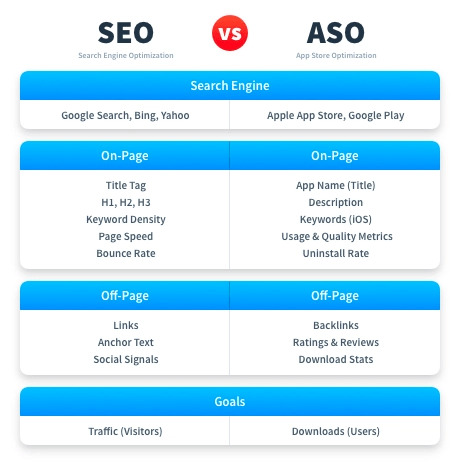
Source
2. Create a Killer Landing Page
You need to have a great landing page to promote your app. Don’t overthink this, just use your landing page to highlight your app in the most simple way possible. Clearly introduce your app in a sentence or two, and offer great visuals of your platform.
Think of your app’s landing page as your business card. You’ll have to include a clear call to action that leads to a download link for the app. Also include clear links to the App Store and Google Play.
Some great things to include on your app landing page would be social proof from your users (like testimonials and positive reviews) and a demo video.
Your landing page can also go live before your app is launched. This is a useful way to start building some excitement around your soon-to-be-released app.
With a landing page builder like Wishpond, creating the perfect landing page for your app is easy. You can choose between various templates, and use the simple drag and drop editor to put together easy modern landing pages.

3. Do Enough Market Research to Understand Your Customers
One of the biggest app marketing mistakes is not doing enough market research before the launch. Thorough market research should actually be done before development, and it’s an essential factor in mobile app marketing.
You’ve got to understand who your target customers are, and what pain points they have. Your app needs to be a solution to these pain points, which need to be clear in your app marketing efforts.
When learning how to market an app, it’s important that you create clear user personas. These should include everything about your ideal user’s demographics, interests, habits, challenges, and unique identifiers. With an in-depth understanding of your customers through detailed user personas, you will be able to market your mobile app far more effectively.
Understanding your users will help you realize things like the pain points they identify most with, the online channels they use the most, and what types of content this audience engages with online.
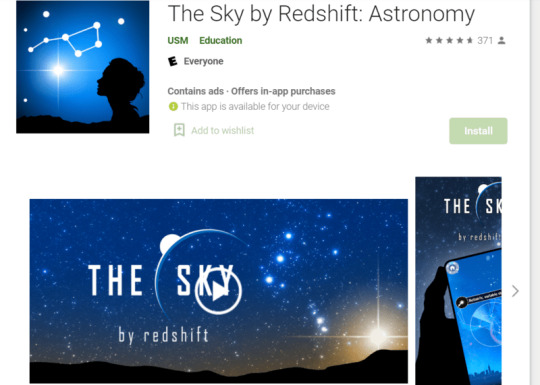
Above: an example of an app that caters to a very specific niche
4. Understand the Problem Your App Solves and Mention its Benefits
Apps are designed to make our lives easier. When figuring out how to market an app, you’ve got to keep your users’ problems at the front of your mind. Knowing this will allow you to offer your audience value and not just a product.
Whatever platform or channel you’re marketing your app on, don’t just list features. Instead, list benefits. This is far more valuable for your audience, and it will give your visitors much more reason to hit download.

5. Ask for App Reviews
One of the most important factors that determine whether a user downloads your app or not is reviews. Gathering as many positive reviews as possible is crucial for successful app marketing. This adds valuable social proof, which will help new users decide whether to use your app or not.
The problem is getting loads of 5-star reviews can be tricky for new apps. When you get started, personally reach out to every user and ask them for an honest review. This will help you get the ball rolling. You can also send out an automated email asking users to please leave a review.
Once you’ve gathered a few positive reviews, make sure to use them. Post them on your mobile app landing page, share them on social media, and look for any areas that you can make these reviews visible.
Once you’ve got a few great reviews, your user base will start to grow.

6. Create a Content Marketing Strategy
Content marketing is a great way to build up authority in your niche. The best strategy is to start publishing relevant content around your niche months before you launch your mobile app. This will help you build up an audience, it might allow you to start seeing some SEO results, and it helps you develop a level of expertise and authority.
To do this, start to write blog posts about the app you will be launching, as well as the problems your target audience faces. You could write an article introducing your app, an article introducing its benefits, talk about common problems your audience faces and how to solve them, etc.
The aim of content marketing is to add value to the user. So think about the kind of information that your audience wants to find out about, and write about this. Don’t just try to sell your product, try to educate and inspire.
And when you’ve created this content, you can promote it through your different marketing channels to grow your audience. Content marketing isn’t only about blogging and SEO. You can share this content on social media, make videos, create podcasts - get creative.
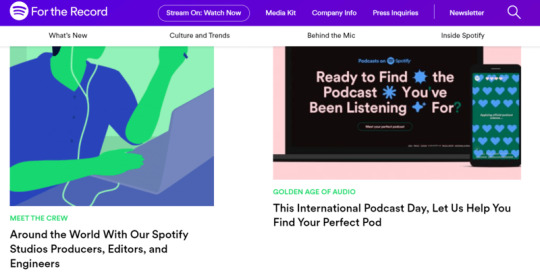
7. Promote Your App With Email Marketing
Email should form a major part of any business’s marketing strategy. As a business, you probably send out heaps of emails every week. Well, here’s a great opportunity to include in your app marketing strategy.
Try to feature and promote your new app in your emails. This allows you to send information directly to your audience, so it’s an easy way to reach a big interested audience and generate a lot of buzz for your new mobile app.
Include your app in your regular newsletter, send out updates about its launch, and promote the content you wrote about your app.
With the right email marketing tool, you can also easily send out personalized content to specific customers and leads. This can help you send more relevant details about your app to different people, giving them more reason to download it.
By the time you launch your app, you will have an audience of engaged email subscribers looking forward to your new product.
And then, once you’ve launched the app, you can continue to keep users engaged with regular email communication. You can send out updates, helpful tips for using the app, promote your blog content, or ask them for their feedback.

Source
8. Link to the App in Your Email Signature
Speaking of email, your email signature offers a great piece of marketing real estate. You can add a link to your app in your email signature to promote it to everyone you come into contact with.
This is a really passive app marketing strategy that requires basically no effort from your side. You can just go about your regular business day, except that now you can subtly market your app to everyone you communicate with via email.

Source
9. Find Relevant Communities Online and Engage With Them
The internet has given us many great things - one of them being easy to reach communities. Through platforms like Reddit, Quora, and LinkedIn, you can find communities of your exact target audience and reach them directly.
Search for Subreddits, LinkedIn groups, Facebook groups, Quora threads, and anywhere else people are talking about specific topics. With everything that’s out there, there’s definitely a community where your niche audience is active.
Join these communities and engage with them. Answer people’s questions, post interesting content and make sure that you subtly promote your new app through this. Don’t be too sales-focused though. Rather try to use your app to add value. Speak about the benefits you can offer, ask users about their thoughts on the product, and answer any questions or feedback.
Doing this will help you reach a large community of people interested in your product while creating trust and authority around your new app.

10. Reach Out to Your Early Users and Build Relationships With Them
When you launch your app, the first people who use it are incredibly valuable to you. You need to be grateful for these users, and you can almost think of them as brand ambassadors. One of the best things to do is to create personalized relationships with these users. Reach out to them personally, thank them for using your product, and ask them if they’d be able to offer you some feedback or leave a review.
This will help you generate your first reviews, and it will help you build strong relationships with your core customers. You should also ask your early users for feedback. They will appreciate it, and you will get some valuable information to help you optimize your app.
The power of word-of-mouth marketing should never be underestimated - especially when you’re starting out.

11. Create a Promotional Video
Video remains the most engaging form of content out there, and it’s an important addition to any app marketing strategy. There are all kinds of videos that you could create to help you market an app. You could create a demo video of the app, a fun promotional video highlighting the benefits of the app, a video testimonial from a happy user, and more.
Once you’ve created this video, there are many ways you can use it for mobile app marketing. You could add a demo video to your mobile app landing page, post promotional videos on social media, use videos in ads, or even set up a YouTube channel where you post regular video content about your app.
In today’s world, creating videos is easier than ever before. Whether you’re shooting a video presented by a person, or if you create an animated video, it will make a big impact on the way you promote your app.
youtube
12. Promote Your App With Paid Ads
If you want to know how to market an app to a large and relevant audience, using paid advertising is one of the best strategies. Of course, the downside to paid advertising is the ‘paid’ part. You have to pay for each click on your ad, which could require a significant ad budget.
The upside is that you can create highly targeted ads that are shown to your exact target audience. This allows your app to get way more exposure than you can generate organically. And it’s not just widespread exposure, you can target your ads to an audience based on their interests and activity.
There are loads of different platforms that you can run ads on. The platforms you choose should be chosen based on your audience and their online behavior. The most popular options for ads are Google and Facebook, but you can do ads on Instagram, YouTube, Reddit, Pinterest, Bing… Whatever platforms are most relevant to your target audience.
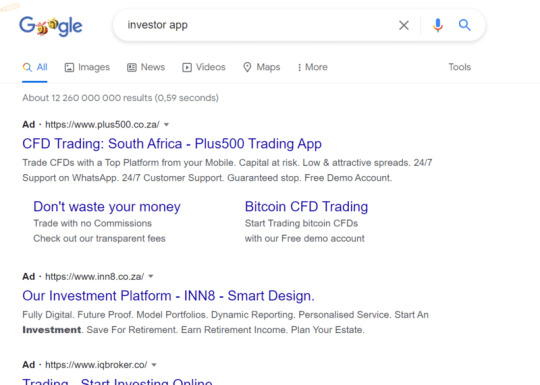
13. Pitch for a Feature in the App Store
Every day, a new app is featured on Apple’s App Store. If your app is featured, you’ll be able to get a lot of new exposure. This can be a powerful app marketing tactic for any new mobile app. A feature in the App Store could give your app just the push it needs to gain serious popularity.
In order to get featured, you will need to send in a convincing pitch to Apple’s App Store curators. They receive thousands of pitches for app features, so make sure that your pitch shows why your app is unique and what major benefits your app offers.

Source
14. Ask Users for Feedback
When you’ve just released a new app, it’s important to always be looking for new ways to improve the app. This will make a difference to your app marketing strategy, as it will allow you to generate more positive reviews and offer a better product.
Constantly improving your app also shows that you care about the quality of your platform and your users’ experiences, which is essential when learning how to market an app.
A good app marketing tactic is to reach out to all of your early users and ask them for feedback. You could do this through individual outreach, or you could send an automated email to users asking them to provide feedback. Your app users will appreciate your interest in their experience, and you’ll be able to continually improve your product.

Source
15. Offer a Referral Bonus
We’ve said it before and we’ll say it again: word of mouth marketing is incredibly powerful when it comes to software. Customers will trust what their friends and colleagues say more than what they might hear from a company selling its app. If you really want to boost your app marketing strategy, then you should try to get your users to refer your app to their friends. This kind of social proof is incredibly powerful.
Not only are referrals often more convincing, but they can also spread the range of awareness for your app in a big way. If one person refers your app to two friends, and those two friends each refer the app to two friends, your reach will grow exponentially.
To do this, you will need to give your users a reason for referrals. A great way to do this is to run a referral giveaway. You could offer a free version of your app (or another relevant prize) in a giveaway, and award bonus entries to the giveaway for each successful referral.
With a tool like Wishpond, you can easily generate referral campaigns to increase your app’s popularity.

Source
16. Reach Out to Influencers
Influencer marketing is one of the best ways to connect your product with a bigger audience. And if you use the right influencer, you can target the exact users who will be interested in your app.
This is another form of social proof that will help to build customers’ trust. If a user sees an influencer that they respect promoting an app, then there’s a good chance they will be convinced to use it too. This is even more true if the influencer offers something special, like a discount promo code.
You will need to offer the influencer something in return for their promotions. Typically, this will be a fee for each post. For smaller influencers, you could also offer a free product or some other kind of incentive.
Just make sure that you work with influencers who have the right audience for your app. Ask the influencer to share their audience demographics and engagement rates to understand if they will be interested in downloading your app. Having higher engagement rates are often better than just having a lot of followers.

Source
17. Leverage Your Website
If your business already has a website, you should make the most of it to market your mobile app. Beyond just the landing page for your app, you can promote your app across your entire website.
This can be done through popups advertising the app, mentioning your app on your homepage with a CTA, including videos about your app on your website, and so on. The more visibility you give your app on your website, the more traffic you’ll be able to send to the App Store.

Source
18. Look into Alternative App Stores
We all know about the Apple App Store and Google Play app store. These are the most popular options, but they’re not the only app stores out there. If you can get your app onto more app stores, you’ll be able to generate more exposure for it. Getting listed on smaller app stores could also help you get better app store optimization results, as there is less competition.
Some great app store alternatives include Amazon Appstore, 1Mobile Market, Samsun Galaxy apps, Mobile9, Opera Mobile Store, and Mobango to name a few. Explore what other options are out there - it could help you get a lot more downloads.
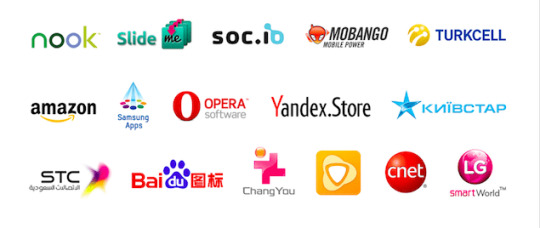
Source
19. Apply for Awards
If your app wins an award, you’ll be able to build a lot more trust and generate some great exposure. The good news is that winning an award for an app isn’t necessarily that difficult. There are loads of app awards out there that you can freely apply for. If you happen to win, it can give you some really powerful marketing content.
An award-winning app will look way better in highly competitive marketplaces. You can also display the award as a trust badge on your website, which is an effective way toi build trust for your brand.
Just do a Google search for mobile app awards that match your app’s niche. There could be all kinds of awards out there you qualify for. Any award, no matter how prestigious, is a good sign for your customers.

Source
20. Reach Out for Features
Another great way to spread the word for your mobile app is through features and roundup posts. There are loads of blogs and tech sites out there that run features on certain types of apps. Getting featured in these blog posts is a great way to attract a larger audience, and build some trust around your app.
You could just Google roundup blog posts that match your app, such as “best music streaming apps”. Gather up a list of these posts, and reach out to the author suggesting to add your app. Include the app’s benefits and what makes it unique, and you might end up with a free feature.
Also, look for tech websites that run regular features on new apps and software solutions. Send them an email introducing your app, its advantages, what makes it unique, and why it would be an interesting feature for their audience. The more coverage like this your app gets, the more popular it will become.

21. Don’t Forget About Social Media Marketing
Of course, you can’t ask how to promote an app without looking at social media. Social media marketing is essential for any online product. Social media isn’t just there for creating posts about your app, you can also use it to create a community around your app.
Post regularly about your app across relevant channels, post about the benefits of your app, and highlight the pain points that it solves. On top of this, you need to engage with your community and build relationships with your followers. Respond to any comments and questions, open up room for feedback and discussion, and ask your audience what kind of improvements they might want from your app.
A great social media marketing strategy should offer a variety of content that always adds value. This means you should post videos, infographics, use cases, share informative blog articles, and anything else that your users can gain value from. If you want to reach a bigger audience, then you can always try paid advertising on your social media channels.
For a more in-depth guide on social media marketing, read this helpful article.

22. Get Featured on App Review Sites
Just like you can get featured in roundup posts about apps, you should also look towards dedicated app review sites. There are plenty of sites out there that are always looking for new apps to review. This could help you get the word out and bring in more exposure.
Just like you did with the features, round up these sites and send them an email about the release of your app. Explain what makes the app unique, what its features are, and offer the reviewer a demo.
Getting 3rd party reviews for your app is always helpful for building trust, and increasing brand awareness.
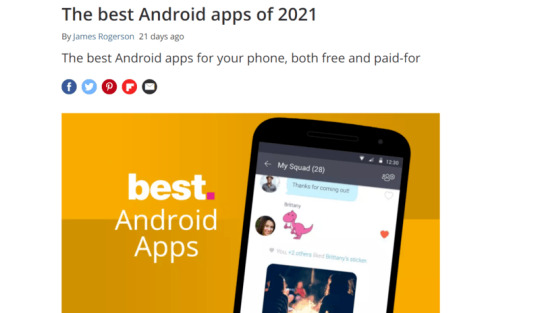
23. Promote Your App In-Store
If you’re a local business with a physical location, then you can use this space to promote your app. Print out some QR codes for your customers to scan and position these around your store. Something as simple as a poster saying “try our new app” with a code to scan can vastly increase your downloads.
You can get creative with any physical space that your business might use. This could include a QR code on receipts inviting users to download your new app or even QR codes on your menus or product packaging.
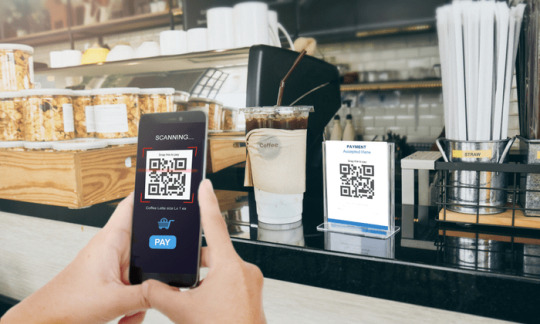
24. Join Relevant LinkedIn and Facebook Groups
The right social media groups can be ideal places to connect with your future users. Spend some time looking through LinkedIn and Facebook groups that match your niche. By finding groups based on specific interests, you could find places where your exact target audience is gathered.
Join these groups, and offer helpful content and insights to the members. Of course, you should subtly promote your app through this. Don’t spam the groups or be overly promotional. Instead, add value and help answer their questions. You can answer questions and respond to posts, or create your own posts establishing the audience’s pain points and showing how your app can solve this.
If you’re genuinely helpful and engage well with this audience, then you will be able to build up some trust and authority within your niche. This is important for building up a great brand around your mobile app.
25. Run a Giveaway
A giveaway is an amazing way to reach loads of new people and get your app going viral. By offering an appealing prize and promoting the giveaway properly, you can get hundreds of people to discover your app and download it.
To do this, you will need to come up with a type of giveaway, and what people will need to do to enter. This could include filling out a simple form, uploading valuable user-generated content, referring your app, and more. With a social promotions tool like Wishpond, there are many different types of contests that you can run.
Even though you will have to give away a prize, you’ll be able to attract plenty of interested users in return. If you gather all of their content details, you can reach out to them after the giveaway with marketing content and a promotional code for your app. This is an easy way to boost your downloads.
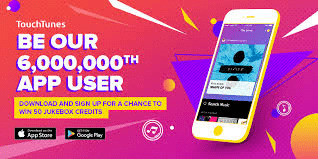
Source
26. Respond to all of Your Reviews
When you market your app, you need to make sure that you build up strong connections with your users. These are the people who have control over your app, and their experience can have a dramatic effect on your marketing efforts.
Whenever someone reviews your app, always respond to it. This is a small gesture, but it can make a big difference to the way your audience perceives you.
Simply thank positive reviews, and tell negative reviewers how you value their feedback. You need to show your audience that you care. Remember, most users will look for reviews before they choose your app. And if they see that you’ve taken the time to listen to each review and consider their feedback, then new users will gain some trust in your brand.

Source
27. Integrate Social Shares into the App
You want to find as many ways that you can to get people sharing and talking about your app. Of course, this includes social media. Shares on social media are valuable because people put a lot of trust into what their friends share and value.
An easy way to encourage social shares is to include share buttons somewhere on your app. If your app offers results (such as a game) then you could include an option for users to share their results to social media. This is just one example of how you can utilize social sharing in your app.
Once those buttons are there, it won’t require any effort from your side. And the results could be plenty of valuable social shares, which result in valuable downloads and exposure.
28. Host a Webinar
Another great way to show off the value of your app is through a webinar. Live webinars are incredibly engaging, and they can go a long way in building up trust amongst your audience. A good strategy is to host regular live webinars on topics that relate to your app and using these events to show the value of your app.
Just make sure that your webinars aren’t too focused on selling and promoting your app. Their main goal should be to offer valuable content and insights to your audience. Use the webinar to talk about topics within your niche and show how your app can solve these problems.
Try to include special guests in your webinars too. This is also a great place to put a human face behind your app and answer your audience’s questions.
And not only will a webinar help you promote your app, but it will also help you generate new leads that you can market towards. You can gather the email address and name of each registrant, and add this to your mailing list. These people are already interested in your app because they signed up for your webinar, so now you can send them relevant marketing content or even discount codes.

29. Try Guerilla Marketing
Guerilla marketing is all about making a big impact without necessarily spending a lot of money. This can be a form of disruptive marketing, and when done properly, it can make a lot of noise for the benefit of your app.
There is no set formula for guerilla marketing, instead, it requires you to think outside of the box. You could take to the streets with a piece of chalk, put up well-positioned stickers with your QR code, or set up some kind of clever marketing installment. This is all about creativity and reaching new users in an unexpected manner.

30. Cross-Promote With Another App
Apps can also team up with each other to create a bigger marketing impact. Another good strategy when learning how to market an app is to find another app that compliments yours but isn’t a direct competitor, and run a promotion together.
Doing this allows each app to access each other’s audiences. This means you get to reach a whole new audience of potential users without having to spend any marketing budget.
You could run a giveaway for both apps, or just mention each other on social media. The aim is to create a win-win situation where both apps benefit from each other’s exposure.

Conclusion
If you’ve got a great new app, then you need to make sure you market it properly to get the results you’re after. If you don’t know how to market an app properly, then it might never reach its full potential. Having a great product is only the first step, getting the app out into the world is the other essential part.
By following the 30 strategies listed above, you’ll be able to achieve far more popularity for your app. Whether you focus on one or all of these strategies, they should offer good results.
And when it comes to marketing an app, it’s all about trying out new things, measuring their results, and then trying something different. With enough practice, you’ll soon find the marketing strategy that works best for your platform.
Have a cool app you think we should know about? Feel free to share it in the comments below!
Related Content
How to Promote Your Blog: 11 Proven Ways to Promote Your Blog Post
App Marketing Strategies Proven to Help You Acquire Customers [Infographic]
E-commerce Mobile App Marketing Hacks to Improve Customer Engagement
4 Mind-Blowing Ways to Promote Your App with Video Content
How the Instagram Algorithm Works in 2021
15 Best Free and Low-Cost Marketing Strategies for Small Businesses
12 Successful Small Business Content Marketing Strategies and Tips
from RSSMix.com Mix ID 8230801 https://ift.tt/3nTLIlB
via IFTTT
0 notes
Text
7 Social Media Hacks for the 2021 Holiday Season

The holidays are a fruitful time for businesses.
There are so many eager buyers for a multitude of different products and services - which means you’ve probably been pretty busy lately.
These social media hacks for the holidays will save you some time.
This article will help businesses of all sorts reach new fans and followers, engage current fanbases and help convert them to customers more efficiently.

1. Use less popular hashtags on Twitter
I know this sounds weird, but it works.
Now I’m not saying you should ditch the trending hashtags, but sometimes you want to hit a niche market with some less commonly used hashtags.
Most of the time I’ll get a lot more click-throughs on tweets with less commonly used hashtags than I do with the overused ones.
For example, the Christmas hashtag can get over 70,000 tweets in a week. That’s a lot!

And sure, a lot of people are probably searching for that hashtag, but it makes your chance of being seen also a lot lower because there are so many other tweets.
So I like to use a mixture of most popular hashtags and less popular hashtags.
Whereas if you search something more specific, like #xmasgifts, the tweets per week are much lower - at around 300 per week.
"#xmasgifts" would be a good hashtag for retailers or eCommerce shops to use over the holidays.

You don’t want the hashtags you use to be completely deserted, you just want them to have a niche following.
To search for the popularity of a hashtag you can use a tool like Talkerwalker.com.
Try to find some hashtags related to your business and the holidays that have a maximum of somewhere between 100-1000 tweets per week.
2. Re-schedule your top tweets with Buffer
This is one of my favorite features on Buffer - and it’s super easy to do. I scroll through my top tweets and find the most clicked. You can also search for the most retweeted, most liked, etc.
Here at Wishpond we recently ran a holiday promotion to get $50 off of our Basic Plan (it’s $69 per month on a month-to-month plan).
59 clicks on a tweet is actually really high for us - so this tweet would be a perfect candidate to re-buffer.
I actually find that sometimes my re-buffered tweets will get more than the original tweet - especially if I re-buffer them for a different time of day (7am Pacific Time is ideal for our tweets).

It’s super easy to figure out which of your tweets have been the most popular on Buffer - the thing is, the analytics are only shown for the tweets that you specifically used buffer to schedule.
All you have to do is click the Analytics tab at the top of the dashboard where you’ll automatically be directed to your posts. Then below your Twitter profile image, you’ll see “Most Popular” to the right of “Recent. Just hover over it and choose whichever option you find fitting.

3. Get a little silly with your Facebook posts
So, I’ve been crafting social media posts for a variety of businesses over the past few years.
When the holidays come around that’s when I get excited - I know that this is the time to let loose and have some Facebook Page fun.
So what can you do to spruce up your holiday marketing on Facebook?
There is a lot of different content you can use to jazz up your Facebook page. Here’s a brief list of some types of content you can post:
Images
Videos
Jokes
Vines
Quotes
Questions
Polls
For example, take a look at one of Charmin’s Facebook posts:

They usually find endearing or hilarious ways to post about their product.
This Facebook post is great because it shows the necessity of their product, but also incorporates the holidays in an adorable way.
Next, take a look at this post by Skittles. They can have pretty obscure posts, but they always relate to their product.

Although this Facebook post may not be as effective for drawing customers into the store, these playful types of posts will help boost the reach of your content.
So, how can you add some hilarity to your own Facebook page? The easiest way is with images.
Thankfully your posts will already be based around a holiday so your posts will already have an extra advantage by being relevant to your fans.
I would start by taking a look at popular sites such as Pinterest or Buzzfeed to get your ideas for funny holiday photos rolling...
Facebook post tip: A lot of successful Christmas posts I’ve used in the past included animals or children… and possibly dad jokes.
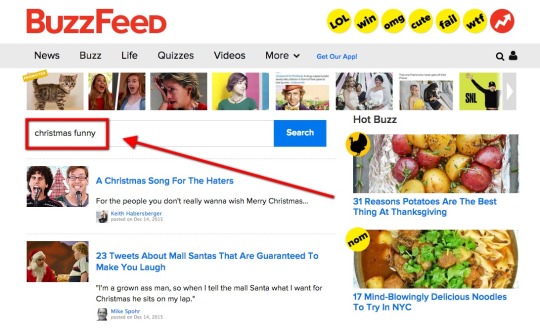
For more tips, check out this article: “How to Use Emotions to Create Engaging Facebook Posts.”
4. Change the appearance of a Facebook post and post it again
Re-featuring a post on Facebook is perfect for when you are spreading the word about a certain product, service or promotion around the holidays.
Facebook allows you to customize a lot of how your Facebook posts appear - such as the share image, the headline and subheader and also the description.
This means that you can link to the same offer over and over (but I wouldn’t overdo it).
In this post below, you can see the four different parts of the post you can change:
The post description
The link image
The link headline
The link subheadline

Make sure you’re not posting the same offer multiple times a day, and make sure that you are providing some different information than the previous post. You don’t want to make your Facebook timeline appear spammy.
Here’s an example of how Sears used this tactic below:

Need some Facebook post ideas for the holidays? Check out these 12 last minute tips: “12 Holiday Facebook Post Tips: Last-Minute Facebook Boosters.”

5. Run a holiday promotion to get more Instagram followers
According to Forrester, the top brands on Instagram generate engagement rates 58 times higher than their Facebook posts and 120 times higher than their Twitter posts.
Instagram is the place for brands to be. If your Instagram is in need of more followers, now’s the time to act.
And contests are a great way to generate more followers.
One great thing about Instagram is that it allows you to “follow-gate” your contests, which means you can ask people to follow your brand on Instagram as a condition of entering your contest.
For example, tea supplier Mighty Leaf...

Below you can see that they’ve included it in their conditions:
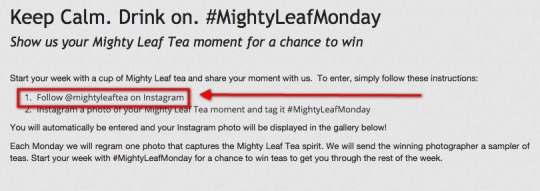
Note: In Instagram contests like Wishpond’s, there’s an option you can select in the campaign editor so that your Instagram contest only includes entries that follow you.
Need ideas for holiday contests? Check out this slideshare for last minute ideas: 12 Last-Minute Holiday Contest Ideas.”
6. Use Shops to convert Instagram followers to customers
If you already have an engaged following on Instagram, Instagram’s Shops feature is definitely worth a look - especially around the holidays.
Before Shops, Instagram users had no way to shop for the products found on Instagram without specialized tools such as Like2buy.
So how does it work?
Your followers can visit your shop from your Instagram profile or through the feed and Stories. Once they're at the shop, they can browse products, explore collections, and purchase products.
This happens seamlessly through Instagram’s in-app browser and without leaving the app from shops with checkout.

7. Schedule all of your holiday posts early so you can relax
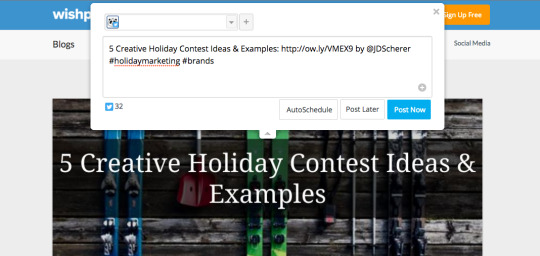
.wishpond.com/wp-content/uploads/ Sure, the holidays are a great time for making the most out of your social efforts, but that doesn’t mean you have to be on social 24/7.
That’s why social media management tools are so important to your social routine. This may seem like an obvious hack, but it’s one of the most important for the holiday season.
We all need a bit of down time now and then, regardless of if you’re taking a tropical getaway or just spending time with family and friends.
So make sure to schedule your posts (whether that’s with buffer, hootsuite, latergramme, etc.) to take the fuss out of posting during the holidays.
For a more comprehensive list of social media management sites, check out this resource by Wishpond: “199 Social Media and Content Marketing Tools.”
Related reading:
Best of 2015: The Year’s Best Branded Hashtag Marketing
How to Use Popups to Get More Fans and Followers on Your Blog
25 Tips: Email Lead Generation from Social Media
Top 10 Tools & Apps for Instagram Marketing
6 Smarter-than-Average Ways to Promote Your Facebook Page
Conclusion
I hope these social media hacks have helped give you some ideas on how to promote your business throughout the holiday season.
What are your most crucial social media strategies for the holidays?

from RSSMix.com Mix ID 8230801 https://ift.tt/2Y5XPD7
via IFTTT
0 notes
Text
7 Ways To Better Facilitate Collaboration In Your Business

Collaboration fosters a positive work culture where the employees are encouraged to communicate and work together as a team.
According to PGI, 15% of innovation can be increased due to workplace collaboration. Fortunately, many companies have eradicated the conventional ways of running an organization that allows their employees to sit in isolated cubicles.
Instead, they use different tactics to promote employee collaboration to increase productivity, creativity, and efficiency. Moreover, the best way to facilitate collaboration in an organization is by letting the team members actively participate in the group dynamic.
In this article, we will discuss seven ways a company can promote collaboration among team members.
Here are seven different ways for successful collaboration you can use in your organization.

1. Schedule Brainstorming Sessions
Brainstorming sessions with groups of employees can play an essential part in facilitating collaboration in an organization. It allows them to actively participate in the sessions by sharing different ideas and concepts on various topics.

Moreover, many companies now use tools for brainstorming online to let their employers generate innovative suggestions without any hindrance.
Even if your employees are working remotely, you can encourage them to pitch their ideas through several great brainstorming tools that offer them a more engaging experience. Moreover, if you employ a concept map maker tool, you can come up with clear solutions to some of the problems faced by your organization or employees after a successful brainstorming session.
2. Define Roles

Define the duties and responsibilities of each team member while working on a project to avoid competition and promote collaboration. Moreover, they will work more efficiently when they have a clear understanding of their position.
Furthermore, each team member will learn what it is like to share duties for outcomes in a collaborative environment. With such commitment, a goal turns out to be a crusade—the sense of accomplishment shifts from individual achievement to a group success that builds cohesiveness and confidence.
3. Adopt Open-Door Policy
Communication is the key to collaboration. If you keep yourself caged in your office, sitting away from your employees, it will be impossible for you to ensure a collaborative environment in the organization.

Adopt an open-door policy to let your team members communicate with you freely. As a result, they will feel more comfortable coming to the office and work more efficiently.
Remember, collaboration is not limited to only a few people; it should be adopted by every person working there.
Moreover, visibility plays a vital role in promoting collaboration in the workplace. When employees witness their managers and directors collaborating effectively, they will be motivated to follow this behavior, increasing efficiency.
4. Define Team Goals

Assign specific goals to each team quarterly to understand how they achieve their objectives and how you will evaluate their performance. Moreover, every team member will know what they have to achieve before the deadline. These achievements will enhance their working capabilities as individuals and team members.
Furthermore, discuss the quarterly results with the team openly to celebrate their success while analyzing their weaknesses. This method helps in multiple ways; for example, there will be no confusion among the team members, no one could blame anyone. Moreover, all the team members will collaborate more in the next project.
5. Appreciate Each Team Member’s Strengths

It is baseless to pinpoint team members’ weaknesses; instead, motivate them by appreciating their strengths. It will help them to work more efficiently than ever before.
Try taking a personality test of each team member to know their strengths and share the results in a group meeting. Moreover, this way, the employees and other team members will learn more about them.
On the other hand, you will know which task to assign to team members according to their strengths. For example, if they work harder in an environment that fosters collaboration, they can be given tasks that highlight this strength.
6. Reward Successful Collaboration

Give rewards to all those employees who have worked well with other team members and completed their goals successfully as a team. Giving prizes for such behavior highlights the company's priority and will motivate employees to work efficiently with others. You can:
Send a gift card
Put their posters in the office
Throw celebration party
Send email acknowledging their success
Give salary bonus
Moreover, this technique will also encourage others to collaborate with others to get rewards and company-wide acknowledgment.
7. Ask For Feedback

To better understand your employees and build meaningful relationships with them, you need to request feedback. You can initially ask for feedback during one-on-one meetings and then request employee feedback during group meetings.
The perfect time to ask for their feedback is during their performance reviews or when you are presented with the perfect opportunity for the potential growth of an employee. This feedback culture will encourage your employees to share their ideas and opinions, enhancing collaboration and paving the way for more healthy company culture.
Some of the most important questions that you can ask your employees include:
Do you like working with a small or large group?
Do you like to be taking instructions from other team members?
What sort of leadership do you want?
Do you like to interact with other employees?
How do you handle criticism?

Related Content
How to Create a Twitter Business Account: 13 Easy Steps (2021)
25 Proven Businesses You Can Start with a Landing Page
7 Reasons Why Blogging is Important for Your Business
10 Proven Facebook Post Types to Promote Your Products
12 Tips for Using YouTube for Your Small Business
Conclusion
Creating a collaborative environment is only the first step towards a more successful enterprise. It must be constant and deliberate to succeed.
You can have several notable achievements in your organization. However, by following the various measures outlined here, scheduling brainstorm sessions, defining work roles, adopting an open door policy, defining team goals, respecting team member strengths, tangibly rewarding successful collaboration efforts, and asking for feedback, you can massively boost productivity by getting your employees to work as a collaborative team.
When team members know they have been wholeheartedly accepted as a part of something special, they become more enthusiastic to work together to achieve their goals.
Moreover, team leads and managers are now more interactive with their employees than ever before. They put their heart and soul into bringing out the best from the team members and encourage them to come forward with creative ideas to realize their worth for the organization.

Written by our guest writer Jay T. Ripton
Jay T. Ripton is a freelance business and technology writer out of Scottsdale. He loves to write to inform, educate and provoke minds. Follow him on Twitter @JTRipton
.flex-container { align-items: center; display: flex; flex-direction: column; justify-content: center; } @media(min-width: 768px) { .flex-container { flex-direction: row; } }
from RSSMix.com Mix ID 8230801 https://ift.tt/31eXn6T
via IFTTT
0 notes
Text
Which Social Media Platform Is Best For Your Business In 2021?

Did you know there are more than 100 social media platforms as of now? It is bustling with new users each day. Having more than 4 billion active users, businesses are making dramatic social entrances. But there's one misconception, shrouding us in darkness — that you need to make a startling presence on every social media platform at your disposal!
Breathe a sigh of relief because you don't have to. Instead, you can be selective and choose a befitting permutation for your business. You can still succeed without pushing yourself over the edge.
Before we dig in to find the exact platform, let's have a look at the major benefits behind this obligatory presence on social media. Then we shall audit the current social media landscape to check which one is best suited for your brand promotion.
Let's begin!
Why is social media important for business?
This question is a no-brainer. We would be living our ancestral lives without social media. It has evolved everything on the face of the earth with its dominating impact on our preferences and lifestyle choices. It is now a crucial marketing avenue because of the following reasons:

Humanizes branding
Gone are the days of salespeople knocking on doors. People will prefer you over your competitors only when they relate more to you. Thanks to social media, brands can show their empathetic side and compassion for the community. Such support encourages your audience to connect with you. This is why it’s a good idea to focus on increasing brand awareness. By doing so, you’re able to create genuine relationships with loyal customers. Brand awareness means people recognize your logo, fonts, colors, voice, personality, and more when they see your content or place of business. This recognition makes people feel more comfortable working with your brand for the long haul.
Ease of ads
Social media advertising is suitable for all business sizes. Be it a budding startup or a Fortune 500 firm, any business can rely on social media promotions. Advertising is cheap and easy here. It is also quite flexible because of multiple ad formats like the story, carousel, banner, video, post, etc. The best part is, with a limited budget, you can try out fruitful experimentation. And it is worth the money.
Whopping lead generation
Social media is a free promotion tool to drive folks to your official site. The tempting feed gives them the final nudge to enter your sales funnel. Retargeting is also easier with social media based on their recent activity on your website.
Let's assume potential leads are swiping up your story on Instagram. They also add a few items from your summer sale but don't complete the transaction. Social media will help you retarget this specific set of people for conversion, increasing your overall lead generation.
Better engagement prospects
Social media is a promising platform to connect you with your audience at large. You get to learn more about your audience and their likings. So when it's time to pitch your service to them, they already feel sold out. Plus, you get to create a personal bond with your clients and loyal followers. Isn't that amazing?
Tip: Use social media scheduler for efficient management of multiple platforms.
But managing multiple social media accounts with different content guidelines needs an incredible amount of planning and timely execution. It also demands a dedicated team. And at times, the payback isn't instantaneous either.
That's why handpicking a platform makes this entire process manageable and effective. Let's start the auditing process to zero in the top networks.
Top 8 social media platforms for business in 2021
Choosing the right social media platform largely depends on your niche and the target audience. So here, we’ll discuss which social media is best for what industry and for the most active demographics it offers, as per the latest statistics from multiple sources.
1. Facebook
Popular industries on Facebook are as follows: Marketing and advertising, Retail, FMCG, Real Estate, IT Services, Software, Healthcare, Financial Venture, Edtechs
Age range: 25-65+
Facebook boasts roughly 2.9 billion active users, the most extensive user base for any social media. Facebook lets you have a business page for your business proceedings by offering tons of features and insightful analytics.
Another reason why this is the most favorite platform for marketers is because of its powerful ads. As per Hubspot, Facebook ads provide the highest ROI of all paid mediums. The Facebook group also compels business presence here for private or public discussions with customers and prospects. Facebook is suitable for all business types with multiple solutions at your disposal.
Tip: Get your hands on Facebook Pixel for better marketing prospects.

WPP is a renowned marketing and advertising firm having 70K followers and 67K people liking its official Facebook page. The page has an abundance of helpful blog posts and video content to amplify traction.

2. Instagram
Popular industries on Instagram are as follows: Traveling, Beauty, Fashion, Fitness, Music, Business, Lifestyle, Photography, Food, Parenting
Age range: 13-24
The recent blind scrolling sensation, Instagram, is a heavenly abode for people whose focus lies on visual content. Be it photography or videos of any length, Instagram is your go-to platform. Instagram continuously boosts its creators with features like Reels, badges, stories, IGTV, shops, and more to keep using the platform maximum.
Instagram has over 1.3 billion users, and it's only ever increasing with time. Instagram also gives several ad formats for promotion. Along with that, you can find tons of influencers using the platform to make money online. They can help you with your branding campaigns. Instagram's shoppable feed is the new favorite of merchants these days, where they can tag their products and list their prices. Various tools can help you grow on Instagram faster too.
Tip: Add important links and account handles in your Instagram bio to get more traffic and followers on multiple networks.

Here’s how Urban Outfitters is making the most out of Instagram. They have used all the features to boost their sales and branding. And the result is rewarding! Their official Instagram handle has 9.2m followers.

3. Twitter
Popular industries on Twitter are as follows: Technology, Games, Celebrity, World News, Airlines, Non-Profit Organizations, Food and beverages, Educational Management, Computer Software, Finance
Age range: 30-49
If your brand strongly aspires to be a thought leader, Twitter is the platform that will lead you to the hall of fame. Twitter has over 200 million active users relying on this platform for news, trends, and entertainment. This can be your official announcement-making channel. Also, when using Twitter, invest some time in hashtag strategy.
With its imposed character limit, Twitter wants you to be direct with your message for getting across maximum information in the shortest time. Twitter is also a dispensable medium for serving your customers on priority with fast replies and mentions to queries.
Tip: Pin your best tweet to your profile, so visitors can see it the first time without much scrolling.
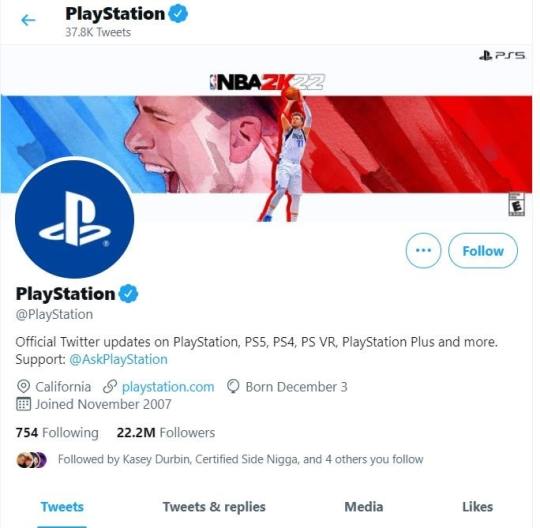
PlayStation is one of the most popular Twitter handles, with 22.2 million followers. They use it efficiently to announce the latest updates regarding their products, features, and events. They have a dedicated account called @AskPlayStation for customer queries too.
4. LinkedIn
Popular industries on LinkedIn are as follows: IT Services, Automotive, Retail, Construction, Educational Management, Analytics, Accounting, Computer Software, Financial Services, Healthcare
Age range: 21-45
If your brand deals with solutions for other businesses and not customers directly, LinkedIn is the channel for maximizing leads. How? Because affluent decision-makers dominate LinkedIn's majority user base.
Just like Facebook, LinkedIn allows businesses to manage a LinkedIn page. It doesn’t pose any character limits whatsoever, yet it is advisable to keep your posts crisp and professional. You can engage in specific groups too. It has indeed evolved from a job posting site to a branding platform with 774+ million global users. So hop in and mellow down the corporate stiffness with an apt LinkedIn presence.
Tip: Post at least thrice a week to get the maximum exposure on LinkedIn.

Google has a thriving LinkedIn account with 21 million followers. They use the platform for screening deserving candidates and the general daily announcements for the audience at large.
5. Pinterest
Popular industries on Pinterest are as follows: Home Decor, Art, Photography DIY and Crafts, Gardening, Hair and beauty, Accessories, Wedding, Jewelry, Fashion
Age range: 30-64
Inspire people with Pinterest branding. The platform is the visual search engine for more than 450 million users monthly. These visitors are likely to convert better as they see a practical usage of your products for their immediate needs.
But unlike other platforms, Pinterest is quite different in the way it works. It has boards for specific niche pins. You can create one for yourself or contribute to the existing ones. This will help in better target segregation. Pinterest ads are also cheap for their higher conversion rates.
Tip: Go for rich pins that sync real-time information from your website.

Oh Joy is a top Pinterest profile with 15 million followers. The design and branding company has astounding boards for inspiring people, right from choosing great colors, patterns to home decors and clothing.
6. Youtube
Popular industries on Youtube are as follows: Entertainment, Arts, Travel, Marketing, Real Estate, Lifestyle, Restaurant and Dining, Ecommerce, Cooking, Education
Age range: 30-49
Having a Youtube account is a default option for top businesses. The platform has 2 billion+ monthly visitors for learning and entertainment purposes. This video-sharing channel has managed to retain the attention of viewers for hours at a stretch! Along with high-quality videos, use concise descriptions for a quick brief. Also, enhance them by adding captions.
The best part of it is the playlist. You can segregate big videos into segments and post them as a playlist to get an increased number of views or optimize the size of YouTube thumbnail to get more clicks on your videos and how do you keep a tab on metrics? Youtube Analytics! If you are confused about handling the Creator Studio and the world of video analytics, take up free Youtube courses to get started.
Tip: Use Youtube shorts when releasing new videos.

Skillshare has an amazing Youtube profile with a beautiful cover image. Notice how they embedded their website link and social media buttons to magnify reach. They provide tutorials on multiple disciplines for their 344K subscribers and more.
7. Quora
Popular industries on Quora are as follows: Video Conferencing, Food Delivery, E-Learning, Technology, Finance, Marketing, Travel, Hospitality, Food and Beverages, SAAS
Age range: 18-24
Quora is a Q&A platform that, like Twitter, helps you build brand authority. 40K+ subjects with 300 million monthly users, you can answer questions of the masses and mold their decision-making capabilities in your favor. Quora can also give you a quick peek at the overall sentiment your brand is creating in a candid form.
You get to see what people are talking about your products or services, if they are not pleased, what their feedback is, and which competitor they are resorting to, to bear with your shortcomings. This is a great channel to improve your brand image in totality with direct communication for mass help.
Tip: Be polite whenever taking part in flared-up discussions.
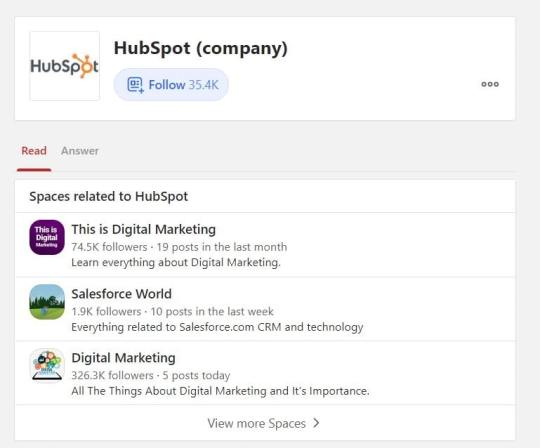
Hubspot space is available on Quora, which is followed by 35.4K users to access insightful CRM-related product discussions. Strive for relevant spaces to get people talking about your business too.
8. TikTok
Popular industries on Twitter are as follows: Beauty, Dancing, Fashion, Jewelry, Art, Home Interior, Toys, Dental, Accessories, Food
Age range: 20-29
TikTok has proved its supremacy in the limited time frame itself with 2 billion downloads. Add the essential fun element to your business by anticipating TikTok trends, and your business might be an overnight success. There are filters and catchy tunes to guarantee your posts rent out space in your followers' minds.
Just like Instagram, influencer marketing is in full swing on TikTok. Collab with relevant businesses can also help you massively boost your presence here. Also, make sure to use hashtags and user-generated content for a promotional strategy to widen your reach.
Tip: Create brand-specific TikTok challenges for ad campaigns.
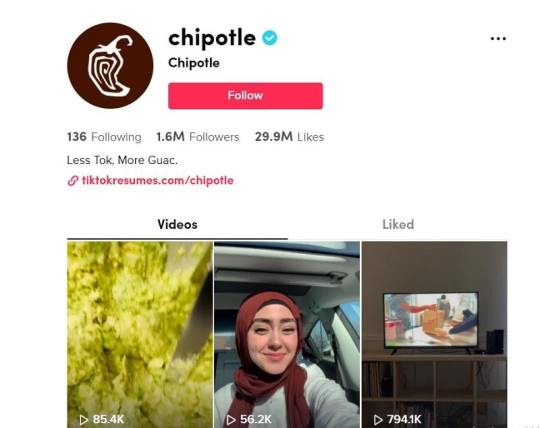
Chipotle has a brilliant TikTok presence with 1.6 million followers and 29.6 million likes. Taking an active part in trends and posting casual, funny videos about the brand is the secret behind such massive popularity.
How do I choose a good social media platform for my business?
Now that you have seen the top social media channels for business with examples let’s move on to the final decision-making process:
Identify the demographics with customer personas.
Choose the platform that includes these personas as their most active demographics.
Map your end goals from social media.
Look for your competitors on these channels.
Observe their content style and types.
Plan a similar content strategy for your business.
Get a relevant tool stack to aid in posting and marketing.
Start experimenting and implementing.

Related Content
Here's What to Post on Instagram: 24 Top Post Ideas & Examples
10 Proven Facebook Post Types to Promote Your Products
How to Create a Twitter Business Account: 13 Easy Steps (2021)
6 Small Business TikTok Success Stories
How to Use Quora for Marketing: 15 Quora Marketing Strategies and Tips
One last thing
Social media further intensified with the pandemic. They introduced new features to support the business community at large. But here's the truth bomb! A streamlined effort on just a couple of social media platforms shows better results at times. If you plan to use all of them, it’s advisable to span out to others only after mastering one platform. Scaling that way becomes much easier. Are you planning to add some more channels to your arsenal? Comment them down to get our help in making better decisions.

Written by our guest writer Sweta Panigrahi, Content Writer at SocialPilot
Her strongest pursuit is to capture social media happenings in her well-researched blogs. From codes to meme posts, her search history is a confounding mess. When not typing out blogs, you can find her in a sunny corner scribbling poems.
.flex-container { align-items: center; display: flex; flex-direction: column; justify-content: center; } @media(min-width: 768px) { .flex-container { flex-direction: row; } }
from RSSMix.com Mix ID 8230801 https://ift.tt/3Eoxobw
via IFTTT
0 notes
Text
How to Make Money With Affiliate Marketing

If you want to make an alternative stream of income online, then affiliate marketing is one of the best ways to do it.
Affiliate marketing is easy to get into, and it can set you up with a really solid source of passive income. With the right strategies, anyone can start to make money as a marketing affiliate.
If you want to start making money while you sleep, then it’s time to join an affiliate network. Follow this guide for everything you need to know about getting started with affiliate marketing and taking full advantage of this easy source of revenue.
1. What is Affiliate Marketing?
2. Why Make Money With Affiliate Marketing?
3. Is Affiliate Marketing Worth It?
4. How Much Do Affiliate Marketers Make?
5. How to Get Started With Affiliate Marketing
6. What You Need for Affiliate Marketing
7. How to Make Money With Affiliate Marketing
8. Tips to Increase Affiliate Sales
9. Become a Professional Affiliate marketer Today
10. Conclusion
What is Affiliate Marketing?
Affiliate marketing is when you earn a commission by selling a product or service that someone else offers. As an affiliate partner, you are rewarded with a commission for each sale that you generate for the business.
You can also get affiliate programs that reward you for things like leads, clicks to a website, app downloads, or free-trial users, but generally, an affiliate is rewarded for sales.
Affiliate marketers are people who promote other brands and products for a living. Pretty much anyone can become an affiliate marketer, and it’s a great way to make an extra income through an effortless side hustle. Although, you can absolutely build up a solid 6-figure business from home through affiliate marketing.
youtube
Check out the webinar above for some expert insights on using affiliate marketing to create a 6 figure business from home.
Why Make Money With Affiliate Marketing?
Making money with affiliate marketing is pretty simple to do. Affiliate programs are generally free to join, and (usually) anyone can join them. This makes it easy to get started with an affiliate program.
Once you get started, one of the major benefits of affiliate marketing is that it can result in a steady stream of passive revenue.
Let’s say you have an affiliate link on a web page somewhere. As long as you keep that page up to date, this affiliate link will continue to bring you an income for years to come. The more affiliate programs you have running, the more income you can make.
Yes, affiliate marketing will require you to promote your affiliate programs - there is some work involved. However, once this is out there you can start making money through affiliates in your sleep.
There are a couple of reasons why affiliate marketing has become such a steadily growing industry. These include:
Affiliate marketing is easy to execute: You don’t need any expert knowledge or experience to successfully join an affiliate program
Affiliate marketing is low-risk: It’s a commission-based model that doesn’t really require any investment. You might not become rich quickly with affiliate marketing, but it’s very difficult to lose out.
Affiliate marketing is easy to scale: It’s easy to grow your affiliate marketing revenue as a single person because all of your existing affiliate campaigns will continue to generate revenue in the background. This makes affiliate marketing a great passive income strategy.
Is Affiliate Marketing Worth It?
Affiliate Marketing is absolutely one of the best ways to make a passive income. Not only is it relatively easy to make money with affiliate marketing, but the whole industry is steadily growing. In fact, the affiliate marketing industry is expected to reach $8.2 billion by 2022.
Affiliate marketing is also a really easy way to make a profit because it’s such a low to no-cost venture.
How Much Do Affiliate Marketers Make?
When it comes to affiliate marketing, the sky’s the limit. Affiliates generally earn a commission rate between 5% to 30% of each sale. Low-level affiliates can earn up to $300 a day, while some “super affiliates” can earn over $10,000 a day. Of course, this is all relative to how popular your affiliate marketing business is and what kind of affiliate program you’re part of.

How to Get Started With Affiliate Marketing
In the most basic sense, you make money with affiliate marketing in three steps:
You recommend a product or service to your audience by means of an affiliate link
Your audience purchases this product or service through your affiliate link
You get paid a commission for the sales your affiliate link generated
Pretty simple right?
It is, but there is more to successful affiliate marketing than this.
First, you need to have two things in place to make money through affiliate programs. These are:
An audience that belongs to a niche
Affiliate products to promote
Without this, affiliate marketing just isn’t possible. Once you have these two things secured, there are no limits as to how you make money as an affiliate marketer.
If you want to become an affiliate marketer, here are the first steps to take.
1. Choose a Niche
The first thing you need to do is pick a niche. It’s important to understand that some niches are more profitable than others. For example, finance is more profitable than food.
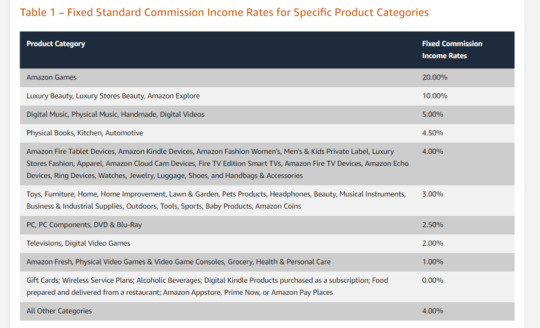
Above: example of different affiliate commission rates based on product niches
Having a clear niche is necessary for being able to attract and build up an audience. Your niche shouldn’t be too broad, and it should allow you to target very specific people. Successful affiliate marketers don’t necessarily need a big niche, instead, they just need to have a very engaged niche that they understand and can tap into completely.
It’s always a good idea to choose a niche that you’re genuinely interested in. This will allow you to promote affiliate links more authentically. It will also keep you interested in what you’re doing.
Great affiliate marketers aren’t shady salespeople - they’re honest and genuinely believe in what they’re promoting.
2. Create a Platform to Gather Your Audience
Now you will need a platform that allows you to build up your audience. The most typical affiliate marketing approach is through a website or blog, although you could also use YouTube, social media, courses, and events, or any other online channel to promote your affiliate links.
A blog or a YouTube channel are generally the best places to focus because they allow you to publish affiliate links that will stay evergreen and attract continual traffic. You can always promote your affiliate links on social media too, but these will soon get lost underneath new social media content. Using a combination of platforms is the best approach.
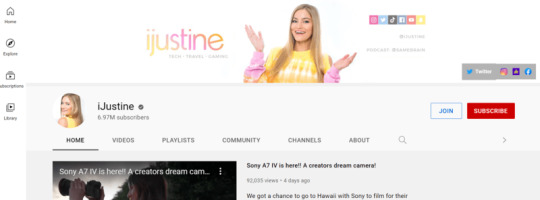
3. Choose Affiliate Products to Promote
Now that you’ve got your website set up, it’s time to start promoting your affiliate products. Once you’ve got your niche in place, choosing your affiliate products should be pretty easy.
The easiest way to find affiliate products is to join an affiliate network. These are networks that connect affiliate marketers with brands that run affiliate programs. Both brands and affiliate marketers make more money out of this, so it’s a win-win relationship.
Here are some of the most popular affiliate marketing networks you can join:
Amazon Associates
ShareASale
CJ Affiliate
ClickBank
Alternatively, you could sign up with brands directly. Think of a product you use and Google it alongside “affiliate program”. In many cases, you’ll find that a lot of your favorite brands have their own affiliate programs. And if they don’t have one, the product is probably available as an Amazon affiliate.
As you will see, there are many brands and products that you can choose from as an affiliate marketer. Get creative, and choose products that match your audience’s interests.

What You Need for Affiliate Marketing
Once you’ve got your website set up and you have your affiliate links, it’s time to get those affiliate links out there to start making money!
While there are many different ways that you can do this, there are two essential things you will need for promoting your affiliate links. These are:
Traffic/reach
An email list
As long as you have these two things, you can start to make money as an affiliate marketer.
This is because you can get your affiliate links seen by people who visit your website, social media pages, YouTube channel, etc. Or, you can send out your affiliate links via email marketing.
In order to do this, you will need to focus on the following strategies.
SEO
SEO is the most valuable tool for any affiliate marketer. Let’s say you have a blog post that ranks at the top of Google search results. You will be able to get loads of traffic continually landing on that blog post, and clicking on your affiliate links. And if you keep that blog post up to date, it can stay at the top spot for many years. This won’t cost you anything, and it will allow your affiliate links to continually make money.
Besides just getting lots of traffic, you also get high-quality traffic with SEO. For example, if your affiliate link is selling a vacuum cleaner, you can optimize your post for a phrase like “best vacuum cleaner”. Whoever searches for this is looking for the best vacuum cleaner to buy, so if they land on your page, you can direct them to your affiliate link vacuum cleaner.
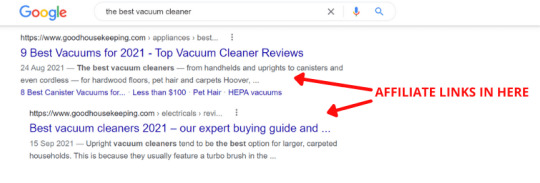
Basically, if you optimize your website properly and get your SEO tactics down, you’ll be able to win at affiliate marketing.
The only problem is there is A LOT of competition out there, so ranking for the right keywords can be tricky. And there are a lot of different factors that go into SEO. These include:
Optimizing your web pages for the right keywords
Making sure the technical aspects of your site are working well (such as the loading speed or mobile optimizations)
Ensuring your content is SEO-friendly and answers the search term correctly
Getting backlinks
And many, many more ranking factors
Here are a couple of helpful tips to improve your blog for SEO.
However, if you really want to get great SEO results, the best solution is to work with an SEO expert. At Wishpond, we offer complete SEO services to help you rank for the best keywords. Book a demo to find out more.
Paid Advertising
You can’t always get your blog posts to the top. If this is the case, you can use paid ads to bring you traffic.
Paid advertising will allow you to get your affiliate links in front of the right people for more traffic and more sales. The only problem is that paid ads can be expensive, so you need to make sure your ad spend doesn’t overpower your affiliate income.
By using a platform like Brax, you can run affordable native ads that help you get the best possible ROI for each campaign.
Building an Email List
Building up a mailing list is something that all businesses need to do.
As an affiliate marketer, your mailing list is one of your most valuable assets. Once you capture an email address, you have that email forever. You can then target these emails with strategic content that markets your affiliate products or services.
Here are a couple of tactics that you can use to generate new leads and build up your mailing list:
Popups: Strategically placed popups on your website are a great way to capture emails. Make sure you offer some kind of value that entices people to sign up to your mailing list.
Lead magnets: You could offer something like a free eBook to anyone that enters their name and email address. Just make sure that this content appeals to your target audience.
Giveaways: Even though you’re trying to sell affiliate products, you could also run a giveaway to generate new leads. Choose a prize that your target audience will be interested in, and get them to enter their name and email address for a chance to win.

These are just a few strategies that you can use to gather more email subscribers. With a tool like Wishpond, you can build landing pages, create popups, set up online forms, run social giveaways, contests, and way more.
How to Make Money With Affiliate Marketing
Now that you’ve got all your essentials set up, it’s time to start making money with affiliate marketing. Here’s what you need to do.
Create Content that Generates Affiliate Revenue
The role of an affiliate marketer is to get users to discover the right products for their needs through high-quality traffic.
You can’t just write up a bunch of content and randomly insert affiliate links. Instead, you have to carefully plan your content to make sure it reaches your target audience and adds value to them. To do this, you will have to really understand your audience and create content that matches their intent.

Above: example of blog content that you could use to promote affiliate products (in this case the products would be glue)
If you’re using affiliate links in blog posts, then understand that your target audience is looking for a certain product, but they don’t know which specific product is right for them. To get these people onto your blog, you will need to use investigational intent keywords. These are things like “what is the best vacuum cleaner?”.
Then, when the user finds your content, make sure you offer enough helpful information and guidance in order for them to want to buy your affiliate product.
If you’re promoting affiliate links through social media or YouTube videos, then make sure the affiliate products match your audience’s interests. If you are a social media or YouTube influencer, then you will have a very specific niche. The products you promote will need to fit right into this. For example, foodie YouTubers should promote food products.

Strategically Promote Your Affiliate Links in the Content
The next step is to include your affiliate links in the content.
This needs to be done carefully. You don’t want to come across as being too pushy or too sales-focused. Instead, you should focus on adding value through your affiliate links.
What people like about affiliate marketing is that it’s a lot less in-your-face than traditional forms of advertising.
Don’t try to squeeze as many affiliate links into one blog post as you can. Only ever advertise affiliate links that make sense and add actual value to the user. Your goal should be to offer affiliate links that are genuinely helpful and valuable to the user.
Always try to include your affiliate links early in any blog post, and only add them in when necessary. Too many affiliate links will impact the user experience.

Optimize Your Traffic for Better Affiliate Marketing
There’s an idea in marketing called the 80/20 rule, where 80% of your profits come from 20% of your content. This isn’t an exact science, but the idea is generally true. You will probably find that the bulk of your affiliate revenue comes from only a few places.
Take a look at your source of affiliate revenue and where you’re getting the most traffic. These pages should be optimized as much as possible to increase your affiliate revenue even more.
Add popups to these pages, ensure your affiliate links are clearly visible and optimize your content to get as many clicks as possible.
Distribute Your Affiliate Products
Promoting your affiliate blog posts, videos, courses, or whatever other platform you’re using is important for making an affiliate income. Yes, you can just set it and forget it if you rely on SEO to bring you traffic. If you want to expand the reach of your affiliate products or services and make more affiliate sales, then you’ll need to take promotion seriously.
Email marketing is by far the best way to do this. You can send emails directly to your audience’s inboxes, and target them with personalized content. If you consistently send the right content to the right people, with enticing affiliate offers, then you will soon start to see a rise in your affiliate commissions.
Of course, don’t forget about your social media channels to promote your affiliate links.

Top Tip: Creating special affiliate offers is one of the best ways to get people clicking on your links and making sales. Some affiliate programs allow you to promote offers like “use my affiliate code for a 10% discount off your first order”.
Tips to Increase Affiliate Sales
In order to make more affiliate commissions with each affiliate program, there are a couple of best practices that should be considered. Keep the following tactics in mind if you want to increase your conversion rates.
Interview a product expert: A great way to give your affiliate promotions more depth is to talk to a product expert on the topic. If you can get a recognized expert to help you promote your affiliate link, you will be able to build up more trust.
Create a product tutorial: Creating a tutorial focused on your product will help you attract more high-converting traffic. People search for things like “how to save money for retirement”. You can write a guide on this and include an affiliate link to a retirement planning solution. This will help you attract people who are actively searching for products like this.
Try different angles: Try out different angles for promoting affiliate products and see which ones work best for you. You could do an unboxing video, a tutorial on the product, a roundup post of best products, or more. See what type of content offers the best results for your audience.
Keep it legal: Always keep things above board when you promote affiliate links. Make sure you fully disclose that you’re offering affiliate links through a clear and simple disclaimer.

Become a Professional Affiliate Marketer Today
Although affiliate marketing is pretty simple, there’s a lot that goes into becoming a successful affiliate marketer. If you want to make a serious income from affiliate marketing then you’ll want guidance from an industry expert.
Martha Krejci offers a Professional Affiliate course that teaches you exactly how to grow multiple affiliate income streams on 5-10 hours a week (or less).
Check it out here, and use the code “wishpond” for 50% off.

Conclusion
Earning an income from affiliate marketing is incredibly rewarding. It’s a great way to supplement your existing income, and you can even do it professionally.
It only takes a couple of hours up front, and then you can enjoy years of affiliate income streams ahead. Follow the strategies above, and you will be able to build a successful affiliate marketing business that can make some serious money.

Related Content
6 Sure-Fire Ways to Increase Your Blog Affiliate Marketing Revenue
5 Awesome Affiliate Marketing Examples (And What to Learn from Them)
Which Digital Marketing Channels Offer the Best ROI?
How to Make Money on Instagram: 10 Strategies That Work
How to Monetize Your Blog - The Complete Guide
How the Instagram Algorithm Works in 2021
from RSSMix.com Mix ID 8230801 https://ift.tt/3bao1PV
via IFTTT
0 notes
Text
Building a $95 Billion Startup: The Stripe Story

The Stripe startup launched in 2011 as a payment processing software for e-commerce. Since its launch, Stripe has grown into a $94.4 billion company that operates around the world.
With just 7 lines of code and a great idea, two brothers from rural Ireland totally revolutionized online payments. How did they go from a small-scale startup to a dominating force in the financial industry?
Let’s break down Stripe’s story to find out.
youtube
Stripe Background: How Stripe Was Started
What Made Stripe So Special?
Stripe Funding and Valuation
Stripe Revenue
How Does Stripe Make Money?
Stripe Investments and Acquisitions
Is Stripe the World’s Leading Payment Platform?
Stripe IPO
Stripe and the Crypto Market
Conclusion
Stripe FAQs
Stripe Background: How Stripe Was Started
Stripe was founded 11 years ago by John and Patrick Collison, aged 19 and 21 at the time. Hailing from Dromineer, a small town on the shores of Lough Derg in County Tipperary, Ireland, both the brothers were academically gifted and showed a special interest in math and physics from a very young age.
While the internet wasn’t easily accessible in their remote village, they had nine computers at home by their early teens and were paying €100 a month for a satellite broadband link. When they were 18 and 16, John and Patrick launched their first-ever business called Auctomatic, which helped eBay store owners track their inventory. Ten months later a Canadian company bought it for $5 million - a testimony to the brothers’ talent.

While studying at Harvard and MIT in 2009 and continuing to develop apps, the idea for Stripe was born out of their own experiences with running an internet business, where, according to John, “the hardest part was finding ways of accepting customers money.” Having stumbled upon a problem that no one else seemed to have solved, they soon realized this wasn’t for lack of trying. It was just because developing this kind of secure and reliable payment system was a tough job.
All the online payment methods that existed back then included several steps, required many fees, and took weeks to set up - which isn’t something that the Collison brothers wanted to do. They took a leap of faith and wrote seven simple lines of code that businesses could plug into websites and apps to instantly connect with a credit card and banking systems and receive payments, streamlining the process considerably.
In 2010, both the brothers dropped out of college to try and get their business idea off the ground. And so, Stripe, although then called /Dev/Payments, was born as an online payment processing platform. The company aimed to cater to web-based ventures of all sizes, preventing fraud and offering easy-to-use payment solutions.

What Made Stripe So Special?
Still confused as to what made Stripe stand out? It’s because the platform’s software made it possible for online businesses to accept digital payments without having to obtain licenses or strike deals with banks or credit card operators to receive money.
This model is what gave Stripe its edge and motivated businesses to start using the platform’s services. In 2010 they received an estimated $20k-$30k of seed funds through startup accelerator Y Combinator, which had previously funded Auctomatic, helping the Collison brothers start their operations.
John and Patrick did all they could to try and kick off their idea. They approached people like Elon Musk and Peter Thiel to ask them to invest in Stripe.
“It’s a little impetuous to go to PayPal founders and say payments on the internet are totally broken,” said John in an interview, adding that “you can WhatsApp anyone around the world, and it’s free. It’s a remarkable act of coordination between the telcos and ISPs and the people who own the fiber underneath the sea to create this global communications network. Then, if you look at the economic infrastructure, we haven’t even started.”

Above: The Collison Brothers (source)
Stripe Funding and Valuation
The brothers’ confidence paid off when Thiel led a $2 million seed round with Sequoia Capital and Andreessen Horowitz in 2011. In 2012, Sequoia Capital led the Series A round alongside PayPal co-founder Elon Musk, Elad Gil, and Max Levchin, bringing Stripe’s valuation to $100 million. Its valuation crossed the billion-dollar threshold after 2014’s Series C round, led once again by Sequoia Capital and Founders Fund, Khosla Ventures, and Allen & Company brought in $80 million and raised its valuation to $1.8 billion.
In total, Stripe has held ten equity funding rounds, from its pre-seed Y-Combinator round to its most recent, $600 million Series H round that valued the company at a whopping $95 billion. Stripe has raised $2.2 billion from 39 investors, more money than the company needs, making it highly capital efficient. This has also helped the Collison brothers’ net worth go up to $11 billion each.
Stripe has become the third most valuable venture-backed private company in the world, and the most valuable in the US earlier this year, when it was valued at $95 billion.

Stripe Revenue
Stripe processes hundreds of billions of dollars every year at a charge of only 2.9 percent of the total transaction value and 30 cents for every transaction. This business model has helped the company generate $7.4 billion in revenue last year—up 70 percent year-over-year, the Wall Street Journal reported.
Stripe’s current client roster includes big names such as Google, Slack, Zoom, Shopify, Lyft, Amazon, and more, meaning that more than half of the world’s users might be making their purchases through a Stripe-powered business without them even knowing!
As they say, good design is invisible - a motto that Stripe has taken pretty seriously. And because so many tech giants in the world use Stripe for their financial transactions, it’s been fairly easy for the company to approach investors and venture capitalists the way it does.

Source
How Does Stripe Make Money?
As of now, Stripe has 50 corporate clients that each process more than $1 billion annually. Stripe makes money through transaction fees. These include fees for online transactions, subscription billing, invoicing, connecting clients that pay through third-party sellers, and in-person point of sale payments.
Stripe also makes revenue through its Stripe Capital Service business loans, its Radar product, and custom finance and data analysis reports.
The company also has 2,500 employees at its 14 worldwide offices, showing how far this small company has managed to go just a decade into its operations. Over time, Stripe has become the default choice for businesses worldwide, which is reason enough to believe that this platform will always be relevant in this age of the internet.
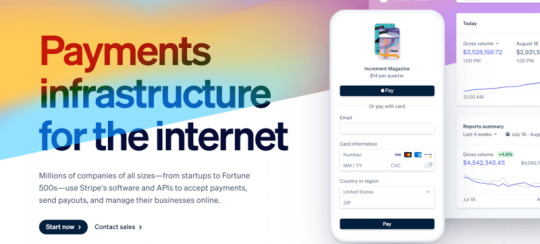
Stripe Investments and Acquisitions
Stripe has also participated in funding other companies. Since 2017, Stripe has disclosed a funding amount of $2 billion across 40 deals. $1.1 billion of this came from 14 investments during 2021 alone.
Some of these companies include Step Mobile, Wave, TrueLayer, Balance, Fast, Safepay, Check, Pilot, Codat, and more.
Stripe has also acquired a total of 11 companies since 2011. The latest of these was Seachange (June 2021). Some of Stripe’s other acquisitions include Bouncer, Tax jar, Paystack, Touchtech Payments, Index Systems, Payable, Indie Hackers, and more.
Is Stripe the World’s Leading Payment Platform?
Currently, Stripe’s primary competitors are platforms like Paypal, WePay, and Silicon Valley’s very own, Square - valued at $112 billion. However, in order to become the leading online payments platform, Stripe will need to continue to expand beyond the US.
This is a strategy they have been pursuing through investments and acquisitions of payments companies and neobanks based in places such as the UK, US, Mexico, Philippines, Israel, Pakistan, and Nigeria. Stripe is especially committed to European expansion and plans to add 1,000 jobs in Ireland alone over the next five years, with John Collison saying that "the growth opportunity for the European digital economy is immense."
It’s pretty safe to assume that the internet will be the primary source for monetary transactions very soon. The Collison brothers themselves have frequently said that their goal is to “increase the GDP of the internet” and that we’re still in the early stages of an internet economy. Stripe is ready to deal with this huge shift in terms of how we handle our finances.
Currently, Stripe is available for businesses in 42 countries and can accept payments from anywhere in the world. As John Collison sees it, moving commerce online will be a “global equalizer.”, which means that businesses aren’t limited to geography now because of how easy the payment system is. The company’s recent funding will be used, in part, to fuel global expansion, which shows that Stripe is ready to go big once the digital financial revolution comes.

Stripe IPO
So, with this kind of success, is Stripe going public soon? The company itself hasn’t announced anything, but having filed its intentions to IPO with the Securities and Exchange Commission in July 2021, expectations are that it will go public in the last quarter of 2021 or the first quarter of 2022.
The valuation of Stripe could be around $100 billion or more after listing.
Stripe and the Crypto Market
Stripe recently announced that it’s building up a new crypto team to help develop the future of Web3 payments.
Stripe was initially an early payment processor that adopted Bitcoin. However, in 2018, the company announced that it was ending its support for Bitcoin payments - stating that Bitcoin has “become less useful for payments”.
It seems like Stripe’s philosophy on Bitcoin has changed, as the company is now reentering the crypto space. They’re being pretty quiet about how this will play out, but it will certainly be an exciting move from the payment processor.
Watch this space!

Conclusion
Stripe is one of the most exciting companies in the world right now. The company started with a simple idea to improve e-commerce payments, and they’ve grown into a massive, multi-billion dollar business. The fact that so many investors have shown so much interest in Stripe is a sign that the company still has a huge future ahead.
What do you think of the company’s journey through the years? Let us know in the comments below.

Stripe FAQs
How many websites accept payments through Stripe?
Approximately 3,124,751 live websites accept payments using Stripe. The Stripe Checkout solution is used on 784,256 live websites. This gives Stripe a 15.49% market share in payment processing.
Where is Stripe available?
Stripe is available in 46 countries, which includes 5 countries that have limited access.
How many payment methods does Stripe support?
Stripe supports 32 different payment methods. These payment methods are spread across categories that include cards, wallets, bank debits, bank redirects, cash-based vouchers, and buy-now-pay-later.
How much does Stripe process in payment volume?
It’s estimated that Stripe processed a total of $350 billion in payments in 2020 (a 133% increase compared to 2019). Over the past 5 years, Stripe has seen a minimum growth rate of 50% each year on its payment processing volume.
Related Content
Allbirds IPO: Silicon Valley's Favorite Sneakers Go Public
Why Did MailChimp Sell to Intuit for $12B?
How The Rock Created a Record Selling Tequila Brand
Why Did Hubspot Buy The Hustle (And What Can We Learn From This?)
How Instacart Became a Billion-Dollar Business
How Marie Kondo Built Her Million-Dollar Empire
OnlyFans Uncovered: Valuation and Business Model Explained
from RSSMix.com Mix ID 8230801 https://ift.tt/2XJdZ5j
via IFTTT
0 notes
Text
How to Promote Your Webinar for Guaranteed Attendance: 22 Strategies

It doesn’t matter how great your webinar is if there’s no one there to experience it.
Webinar promotion is one of the most important parts of running an online event and it’s something you have to get right if you want your webinar to be a success.
From our experience running webinars on all kinds of subjects, we’ve figured out the most effective ways to promote your webinar and draw in a guaranteed audience.
Follow our complete guide to webinar promotion for a successful event that helps your business achieve its goals.

What Makes a Good Webinar?
Before starting to promote your webinar, you need to make sure you’ve got a great webinar to begin with.
So, what exactly is a webinar, or webcast?
A webinar is a type of live seminar delivered online. It involves a host and guests, and the webinar is broadcast live. A webinar needs to have a clear topic or theme, that is presented to a live audience of attendees.

When you plan and deliver your webinar, here are some of the most important best practices to remember.
Offer Value
Your webinar has to provide value to your attendees. The event should offer some kinds of actionable takeaways, that attendees can apply to their own situations.
Yes, webinars are a sales and marketing tactic designed to promote your business in some way. However, nobody wants to join a webinar that’s just one long sales pitch.
Your webinar content has to be valuable to the viewer in some way. Attendees need to leave your webinar with fresh knowledge and insights that they can use.
Educate Your Audience
All webinars have to be educational in some way. They need to teach your audience something they never knew, leaving them with more knowledge than what they had before the event.
This could be on a new product, a business strategy, how to use a tool, how a service works, some kind of expert insights, and so on.
Make it Entertaining
It doesn’t matter how much valuable content your webinar offers - if it’s boring, nobody will be interested. Your webinar shouldn’t just be educational, it should also be fun.
Make sure that the host is knowledgeable, but that they also have a good personality. A webinar is a great way to engage your audience and to add some personality to your brand. If the webinar is just a long, boring information session, you’ll soon lose your audience.
Make it Easy to Understand
You need to communicate your webinar clearly. If you want to offer value to a large audience, then the webinar needs to be easy to understand.
Use a visually appealing presentation that conveys the information clearly. Use simple language, and pay attention to the way you present your ideas verbally.
Plan the Webinar Properly
Finally, the best webinar is one that is well-planned. You never know what could go wrong during a live event so always try to have your bases covered.
An important part of this is preparing for any possible technical difficulties. Use a trusted platform to stream the webinar, and know how to use it. Do a dry run of the webinar in advance, and make sure that you have a clear understanding of the flow of the event, speaking times, and any technical tasks you may need to perform. Of course, a strong internet connection is essential.

How to Promote Your Webinar: 22 Proven Strategies and Examples
Preparing a great webinar is only the first step, the second half of the work comes down to your promotions. Without strong promotional efforts, you could be presenting your well-planned webinar to no attendees. From our experience, here are the most effective strategies and tips for webinar promotion that works.
1. Choose a Topic That Appeals to a Broad Audience and Offers Clear Value
The first thing that’s going to get people to attend your webinar is your topic. If the webinar topic is bad, then nobody’s going to show any interest in your promotions.
We’ve already covered how important it is to offer actionable advice and value to your webinar attendees. So, make sure that this value is clearly communicated in the title and topic of your webinar. Your audience needs to know what they’re going to get out of the webinar before they attend it.
When you choose a topic for your webinar, try to come up with a topic that appeals to a large audience, but is still focused enough to offer clear actionable value that your attendees can apply.

2. Set an Attendance Goal
You need to have a clear goal for attendance when you start to promote your webinar. Otherwise, you won’t know what you’re trying to achieve.
Having a goal in place helps you measure the success of your promotions, and it helps you to know which tactics will work best for your next upcoming webinar. Setting a clear attendance goal is the first step to achieving a good webinar registration.
3. Understand Your Registrant vs Attendees Ratio and Set a Registration Goal
Once you’ve set your attendee goal, you need to understand that webinar registration doesn’t equal attendance. Generally, only 44% of registrants actually attend the webinar they sign up for. Use this figure to understand how many registrants you will need in order to achieve your desired attendance level.
Once you’ve got your registration figure in place, keep a constant eye on your registration progress to see whether you need to adjust your promotional efforts or not.
Of course, you also want to make sure that you get as many attendees as possible from your registrants. To do this, you’ll need to keep your webinar front of mind. Keep following up with registrants, reminding them about the upcoming webinar and the value they will get from it.
4. Offer Something Special to Attendees
Everyone wants to be part of something special. When you promote and run your webinars, try to find a way to offer something special to your attendees. This could be a giveaway during the event, a special offer for all attendees, or a social contest leading up to the webinar.
This gets people excited to register for your event, it gives registrants more reason to attend your webinars, and it will help to add even more value to your existing program. The more you can offer to your attendees, the more positive brand awareness you’ll be able to create. This will make a big difference to your sales and marketing.
An example of this would be running a live draw at the end of your webinar based on a question you ask in the live chat. You could run a giveaway based on a hashtag that you ask attendants to post on social media or give away coupons and discount codes during your event.
Another excellent strategy is to follow up with all attendees after the webinar and send them each a discount code for your product or service. This isn’t necessarily a promotional tactic, but it’s an effective way to boost your sales after the event. This is because your attendees are clearly interested in your brand, and if you can show just how valuable your product is during the event, then a discount code could be just the nudge they need to make a purchase.

5. Promote Your Webinar at the Right Time and On the Right Day
Timing plays a major role in your webinar promotion. Certain times of the day result in better registration rates. Something as simple as the time and day that you send out your promotional email could have a major effect on your attendance levels.
Promotions launched on Tuesdays drive the best results, and promotions launched on Fridays are the least effective. Early morning promotions are also the best. You want your email to be at the top of your readers’ inboxes when they check their mail in the morning. Try to send out important promotions between 8 am - 10 am.
The closer you get to the date of your webinar, the more registrations you’ll get. This means you should also increase the frequency of your promotions closer to the date of the event. A promotional period of 3 to 4 weeks is best, as you’ll be able to get a steady stream of registrations throughout this period.
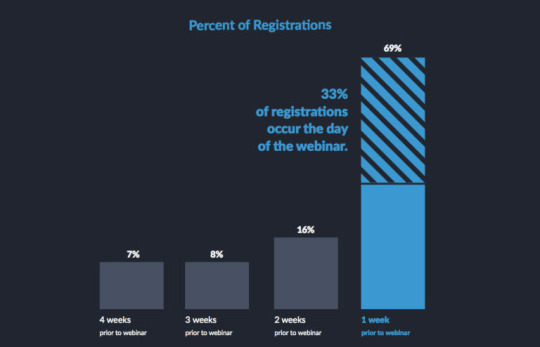
Source
6. Create a High-Quality Webinar Landing Page
Your webinar landing page will decide whether people will register for your webinar or not. All of the efforts you put into promoting your webinar will drive interested people to your webinar landing page. If this registration page is properly set up, visitors will quickly and easily register. If not, you could lose out on a good portion of your attendees.
Firstly, make sure that all of the correct information is displayed on your registration page. This should include who will be hosting the webinar, what the webinar is about, when the event will take place, and how registrants can access the event. Of course, highlight the value and benefits that your webinar offers, not just what it’s about. All of this information should be presented in a simple, succinct way so that visitors can quickly get all of the information they need.
Your signup form should also have as few entry requirements as possible. The easier it is to register, the more registrations you will get. You could even offer one-click registrations from your promotional emails.
If you use an email marketing tool like Wishpond, you can filter all of the people who clicked on your registration link (which sends them straight to your landing page) and register their emails for your webinar. This is the easiest way to get people to sign up because they don’t have to fill out any forms or offer any details.
By using Wishpond’s landing page tool, you can build incredibly easy, beautiful landing pages with the drag and drop editor. This is the most effective way to set your webinar up for success.

7. Develop a Clear Email Marketing Strategy
Hands down, the best channel for promoting your webinar is email. You can use email marketing to reach a large audience and send your registration link directly to all of their inboxes.
To do this, you will need a good email marketing tool. The best email platforms allow you to segment your mailing list based on various factors. Doing this allows you to send customized, personalized content to your different customers and leads. This will improve your open rates in a big way.
For example, you can frame your email to existing customers or previous webinar attendees differently from emails sent to new leads.
When promoting your upcoming webinar, set up a series of emails to be scheduled for different times. Ideally, you will want to send out an automated email workflow, where your subscribers receive different emails based on their actions. Sound complicated? It’s not.
Let’s say you send out an initial email promoting your event. Those who registered can automatically get sent a thank you email, followed by a few reminder emails over the promotional period. The people who did not click on your first email can get sent further promotional emails later on.
Creating an automated workflow like this saves you the trouble of following up with different contacts and registrants while making sure that everyone receives the right content at the right time.
With a tool like Wishpond, setting this up is easy.

Not sure how to write and put together your emails? Follow this guide to help you create effective marketing emails.
8. Send a Registration Confirmation
As soon as people register for your webinar, automatically send them a thank you email. This is just a simple way of thanking them for registering (which is good manners) while providing a reminder for the upcoming webinar. These emails are also important for letting your registrants know that their sign-up was a success.

You can easily set these emails up with an automation tool. All you need to do is thank the person for registering, remind them of the value that your webinar is going to offer, and include the time, date, and webinar link.

Above is an example of a landing page that registrants get ent to from one-click registrations.
9. Send Out Reminder Emails
Your follow-up email is necessary, but this isn’t always enough to keep your webinar at the front of your registrants’ minds. Sending out a series of reminder emails before the webinar will help to get registrants excited about the event, and it will encourage them to keep a space in their calendar open.
You’ve got to be careful here because sending too many emails will be annoying, while not sending enough emails could make registrants forget about the webinar. Sending one email a week to registrants is a good idea, with a final reminder the day before the webinar.
You can also use these emails to promote any other relevant content you have (like eBooks, videos, or blog posts) that relate to the webinar topic.
These emails should get your registrants excited, so use them to talk about the value they will get from the webinar. Introduce the speakers, list the talking points that will be covered, and reveal what they will walk away from the webinar with. Your goal should be to build up momentum and engagement around the event.

10. Promote Your Webinar on Social Media
You’ve got to use all of your marketing channels to promote your webinar. Of course, this includes your social networks.
Post about your webinar regularly across your social networks, tag the guests who will be on the webinar, and engage with any questions about the event. Social media is a great place to start building up some real buzz around the webinar.
Short-form social media videos, like Instagram Reels, Stories, and TikTok videos, are also a great way to get the word out. You can post short snippets from the webinar guests covering what they’ll be talking about or introducing themselves. You could also post short animated videos highlighting the webinar topic.
Remember that social media is about building a community, so get your audience involved. Ask them questions, such as what they want you to talk about in the next webinar, and engage with your audience to build excitement.

11. Get Your Guests to Promote the Webinar to Their Audiences
If your webinar has guests (which it probably does), you should also use them to promote the webinar too. When you get guests to agree to join the webinar, make it a clear term that they also need to post about the event.
This allows you to get your webinar out to an entirely new audience, which can help your registration numbers in a big way. Just make sure that the guests promote the correct link to the registration landing page.
12. Promote Your Webinar On Your Blog
Your blog is another great place for webinar promotion. During the buildup to the webinar, post a blog article about the event and what will be covered.
Content marketing like this is the perfect opportunity to go a bit more in detail about the things you will be talking about and who your speakers are.
Then you can promote your blog post across social media and email, to add a new form of promotional content to keep your audience engaged and excited. Of course, make sure that you include a clear call to action (CTA) leading to the registration form in your blog post.
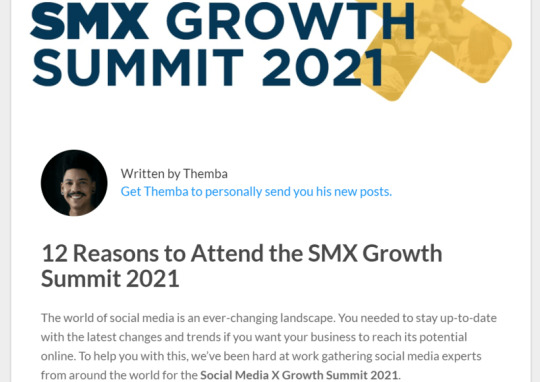
13. Leverage Your Employees Networks
When you spread the word for your webinar, don’t forget about your employees. Employees can be valuable assets for social media promotion, as they allow you to expand your reach and audience in a big way.
If each of your employees posts the webinar on LinkedIn and invites their contacts, your registrations could skyrocket. This only really works if your employee’s audiences are the same as your target audience.
Just send out social media assets and the correct registration link to all of your employees, and they could start generating some valuable traction for your event.
14. Consider Paid Media
If you want to reach a wider audience, then consider utilizing paid media. Running ads for your webinar can help you reach way more people. You just need to make sure that the cost of your ads is worth what you get out of the webinar.
If you do want to promote your webinar using paid ads, then social media is your best bet. Platforms like Facebook and Instagram collect loads of data from their users, which allows you to target a very specific audience. This means you’ll be able to get your webinar out to your exact target audience, which will mean better results for the campaign.
15. Send Personalized Invites to Key Accounts
This won’t necessarily raise your attendance a great deal, but it can help you to get the most important people watching your webinars.
If you have a few really important clients or leads that would benefit from the webinar, reach out to them personally and extend an invite. Send them a personalized email that is clearly not automated, and explain the type of value that they will get out of the webinar.
This can help you build stronger relationships with key accounts, and it can boost the authority and trust of your brand. Sending personalized invites out to hot leads is also a great way to fill them with confidence in your business to close a deal.

16. Turn Your Webinar into a Regular Series
A once-off webinar will get you some attendance, but a regular series of webinars will allow you to build up a bigger, more engaged audience.
If you’re using webinars to grow your business, then hosting a regular webinar series is definitely the best approach. With each webinar, your audience will grow a little bit bigger. Regular events also make it easier for registrants to remember the webinar, and attend each time.
To do this, create a name and general theme for your webinar series. Maybe you could run a webinar once a month, or once a week. Set a recurring date, and make this a regular thing to promote. Doing this will help you build momentum, and gain your webinar series more popularity.

Example of a weekly webinar series titled “Accelerating Value”.
17. Promote Your Next Webinar On Your Current Webinar
Your webinar promotion should start as soon as the previous webinar ends. In fact, it should start before the webinar ends.
At the end of your webinar, take a moment to tell your audience about your next webinar, what the topic is, and when it will take place. This lets you directly promote the webinar to an audience of already interested people. If they liked the webinar they’re on, there’s a good chance they will join the next one.
You can also make an email list of all attendees, and send them a personalized invite to the next webinar. Chances are, these people will be more likely to join a webinar because they already trust your business and are excited to see more of what you can offer.

18. Utilize Popups and CTAs on Your Website
If you’re going to make the most of your marketing real estate, you should be using your website to promote your webinar.
Publishing popups and CTAs across your website will help you turn your site visitors into registrants. This is a great way to build interest in your business while attracting more attendees to your event. Just a simple description of the webinar with a clear call to action (leading to the registration form) is all you need.
With a tool like Wishpond, you can create easy popups and forms to publish anywhere on your website.

19. Promote Your Webinar on Live Social Media Streams
We’ve already mentioned the importance of marketing your webinar on social media platforms, and live streams are one of the best strategies you can implement.
Schedule a live stream before the webinar where you’ll introduce yourself (the host), cover the topic of the webinar, and accept any questions and comments from your audience.
This will help you get people excited about the webinar, and it will allow you to start getting your personality out there before the event. Live streams add a more human, personal element to marketing, and they’re a great way to build up your webinar. Make sure to include a CTA during your stream to get viewers signed up.
20. Create a Promotional Video
Video marketing is incredibly powerful. Video is one of the most exciting and engaging forms of online content. This means a promotional video for your webinar is an effective way to drive lots of interest in your event.
All you need is a fun and simple video highlighting the topic, introducing the guests, and telling viewers how to register. This could be an animated video or just a simple selfie video. You can post this on social media, share it in your stories, and even use it in ads.
youtube
21. Use the Best Video Conferencing Tools for Your Webinar
This isn’t necessarily a webinar promotion tactic, buts it’s a really important thing for offering a good webinar experience.
In order for your webinar to be a success, you need to host it on a great video conferencing tool. This needs to be a platform that you and your audience are comfortable with. A great platform means no technical difficulties, which results in a better quality webinar.
A great approach is to use a video conferencing tool that allows you to stream the webinar across different platforms. You could do a single webinar across Zoom, YouTube Live, and Facebook Live at the same time - allowing you to tap into different audiences on each of these platforms. This also means your audience will have more options to choose a streaming site that they are more comfortable with - which should boost your attendance levels.

22. Use Wishpond to Promote Your Webinar
Effective webinar promotions require the right digital marketing tools. By using Wishpond, you can access all of the promotion tools you need from one easy platform.
This includes email marketing, creating landing pages, popups, online forms, marketing automation, and more. Instead of subscribing to numerous promotion tools, you can get them all in one place.
On top of this, Wishpond offers a team of marketing experts who can create and manage your campaigns for you. Get your own designers, video editors, ads specialists, and more.
Book a demo today if you’re keen to get started.

Summary
These 22 best practices for promoting your webinars will make a major difference to your webinar attendance levels. Follow these strategies, put some effort into your promotions, and you’ll increase the number of attendees in a big way.
Webinars are awesome tactics for lead generation, promoting products, and boosting the popularity of your business. If you get your webinar right, it could have an amazing impact on your business.
Have you got any experience promoting webinars, or have an upcoming webinar you’d like to discuss? Reach out in the comments below.

Related Content
How to Organize a Live Summit: 11 Tips
How to Create the Perfect Webinar Landing Page
9 Best Tools & Tactics to Skyrocket Your Webinars Promotion
10 Stunning Features Every Webinar Landing Page Needs for Conversions
How the Instagram Algorithm Works in 2021
How to Promote Your Blog
10 Ways to Use Live Streaming to Boost eCommerce Sales
from RSSMix.com Mix ID 8230801 https://ift.tt/3GgSV7A
via IFTTT
0 notes
Text
Top 30 Instagram Marketing Tools to Grow Your Business

With over 1.3 billion users, Instagram is an essential social media platform for marketing. While there are massive opportunities to reach a big audience, there is also a lot of competition. This is why you need the right Instagram marketing tools if you’re going to succeed.
These Instagram marketing tools will help you make the most of your Instagram efforts - whether it’s creating captivating posts, monitoring your analytics, cracking the Instagram algorithm, or converting your Instagram followers to customers.
Here are the top 30 Instagram marketing tools you need to create a fool-proof Instagram marketing plan:
1. Canva
Canva is one of the best Instagram marketing tools to help you make images that stand out. You can use Canva to enhance your Stories or your feed posts. Canva offers loads of design features in a really easy-to-use format, allowing anyone to become a champion designer.
One of the best things about using Canva as an Instagram tool is that you can access plenty of templates, fonts, and design elements. This allows you to make your brand really stand out, and create a clear and consistent identity to help users recognize your content.

What are some ways you can use Canva for Instagram marketing?
Superimpose text on images
Create multi-image layouts
Add a wide range of pre-designed graphics into your posts
Price: Free, or $12.95/month for Canva Pro to access more features
2. Wishpond Instagram Hashtag Contest App

Running an Instagram contest is one of the best ways to increase engagement, get more followers, spread brand awareness, and promote your business. With the right Instagram marketing tools, you can make sure your contest or giveaway does more for your business.
Wishpond’s Instagram Contest App collects Instagram photos and showcases them in a voting gallery on your Facebook Page or website. Fans submit their photos from Instagram and vote on their favorites.
Running contests is a great way to engage your current followers and collect email leads. They’re a win-win for both you and your Instagram followers.
What are some other ways businesses can use Wishpond’s Instagram Contest?
Library: Get entrants to snap a photo of you and your book of the moment in your favorite reading spot.
Mall: Set up a photo booth corner somewhere in a mall and tell Instagramers to snap a photo there for a chance to win.
Radio station: Have your followers take a funny photo (or video) of them belting out their favorite song
Price: Book a demo

3. Like2buy
We all know it’s a best practice to include a link to your website or blog in your bio, but Like2buy takes this a step further. They provide a simplistic gallery of products that are instantly available for purchase.
Like2buy provides a link that brands put in their bio. Once a user clicks on the link, it will take them to a page of the brand’s featured products. It only takes a few clicks to get from a brand’s Instagram to their Like2Buy product page. Using this social commerce tool can help you create the ultimate user journey and turn any social channel into a shoppable storefront.

Tip: Use Instagram captions to say “shop link in bio” to remind users that they can shop for the products conveniently.
Price: Request a demo for details.
4. Layout

Layout is Instagram’s collage app, and it’s by far the easiest app of its kind. It allows you to combine 2-9 of your photos into one image.
There are three options from where you can select your photos: camera roll, recent photos, and an interesting “faces” option where Layout compiles the photos you have of people‘s faces.
There are also a lot of creative features included: such as mirroring, flipping, resizing, and rearranging with just a few taps.
Bonus: It has a photo booth feature that includes a countdown where you can snap up to 4 photos in a row.
How can businesses use Layout for Instagram marketing?
Real estate agent: Make a collage of several different photos of a new property for sale.
Beauty salon: Compile a collage of the latest hairstyles of the season.
Tea merchant: Snap photos of 4 loose leaf teas in visually pleasing containers at a high camera angle.
Price: Free
5. Instasize

Instasize allows you to edit, filter, and resize photos and videos. The app is seriously easy to use, and it allows you to totally transform your Instagram marketing.
Simply access your camera roll and upload the file you want. Then edit your photo or video and use the red icon in the top right-hand corner of the app to export it by opening it on Instagram, saving it in high-resolution to your camera roll, or sharing it on another social network.
Instasize has a lot more features than just image resizing. Check out their unique overlays, borders, collage frames, and stickers. You have the option to download more borders and stickers easily and for free through the app. This is one of the best Instagram marketing tools for both still images and video.
Price: Free
6. Pixlr
There are so many image editing tools you can use for your photos, but Pixlr is my favorite. It’s really easy to use and also gives you a bunch of options.
You can use Pixlr for Instagram marketing to apply filters and effects, remove the background, make collages, and you can access many design templates. Some features allow you to:
Take photos within the app
100+ effects
280 overlays
200 borders
Despite all of the options, this Instagram marketing tool is surprisingly easy to navigate.

Price: Free
7. Sked Social

ScheduGram is one of a kind - it’s a web-based tool that enables you to publish your Instagram photos and videos now or later. When it comes to Instagram marketing, having a good scheduling tool is a must.
You can also manage multiple Instagram accounts and collaborate with other users - which is particularly useful because you don’t have to log in and out to switch accounts. ScheduGram has basic photo-editing features such as cropping, adding filters, text, and rotating images.
ScheduGram lets you schedule multiple posts at a time. This is an effective time-saver and frees you from worrying about the last time you posted on Instagram.
Price: ScheduGram offers three different plans at $25/month, $75/month, and $135/month (free trial available)
8. Repost

Instagram users feel honored when a brand mentions them. And when brands share users’ content, they generate some valuable social proof. Repost is an easy way to make your followers feel appreciated.
Repost makes sharing other people’s photos or videos simple: browse your feed or search for a specific user or hashtag, click on the photo, and tap, “repost.” It’s that simple.
This app is a great way for brands to show their user-generated content (UGC) and give praise to their customers.
Tip: Create a hashtag unique to your brand. It will make it easier for you to find UGC photos for your brand to use and a great way for Instagram users to browse your photos.
Price: Free
9. Iconosquare
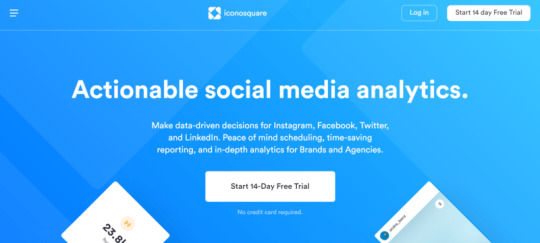
Iconosquare is the go-to Instagram analytics tool for marketers: it allows Instagram users to monitor and analyze comments, likes, followers, messages, and more.
This tool sorts out the analytics of your account and puts all the information in one dashboard. It’s one of the most in-depth Instagram marketing tools, allowing you to make easy data-backed decisions.
Here are a few handy Iconosquare functions:
The bulk commenter makes it easy for you to keep track of your follower’s comments
Shows you who has unfollowed you in the last week and onward
Specific comparative growth statistics that help you grow your followers
Price: Three options are available at $49/month, $79/month, and $139/month (free trial available)
10. GoDaddy Studio

This sleek app was designed for mobile-creative types and Instagram users that are serious about making visually appealing graphics. GoDaddy Studio (previously Over) is an awesome Instagram marketing tool to easily elevate your social posts.
With GoDaddy Studio, you can add text & artwork to your photos. They feature both standard and custom-made fonts as well as original graphics. You can access 1000s of customizable templates that work on all your social media platforms.
GoDaddy Studio makes it easy to make beautiful graphics for Instagram while you’re on the go.
If you’re into designing your own fonts, you can upload them to this Instagram marketing tool to use on your photos.
Price: Two options are available at $5.99/month and $14.99/month (free trial available)
11. SproutSocial
SproutSocial, like other great social media platforms like Hootsuite and Buffer, allows you to compile your entire social media efforts into one dashboard:
An "all-in-one" social notification inbox
Publishing, scheduling, and drafting from
A complete social content calendar
Reporting on all post's performance
10 social profiles (under their "premium" plan, more with others)
Keyword and profile monitoring
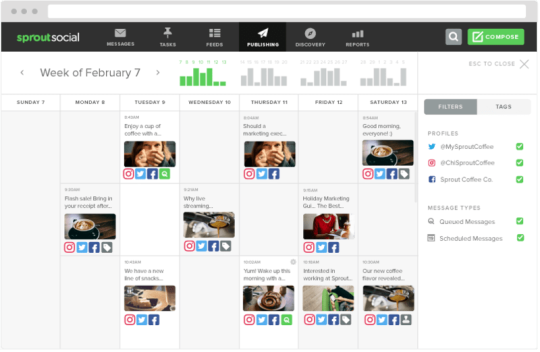
If you want to schedule posts, access advanced analytics, stay up to date with your community, and more, then this Instagram marketing tool is a great choice.
Price: Three options are available at* *$89 per user/month, $149/month, and $249/month (free trial available)
12. VSCO
VSCO adds on to Instagram's stock filters with their own "presets." The VSCO app allows you to easily imitate film effects as well as edit your images subtly. This Instagram marketing tool is one of the best options for making your phone photography look really special.
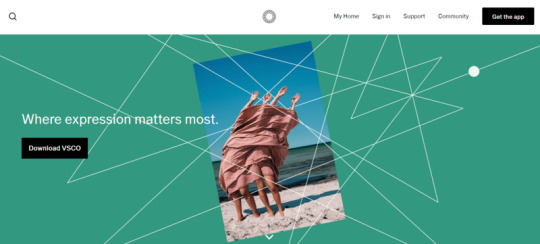
Price: Free app download, or monthly subscription available for VSCOMembership
13. Prisma
The Prisma app enables you to turn your photos and videos into "works of art" using chosen styles from classic and famous artists such as Picasso, Van Gogh, and others. This Instagram marketing tool lets you easily enhance your photos to make your feed really stand out.
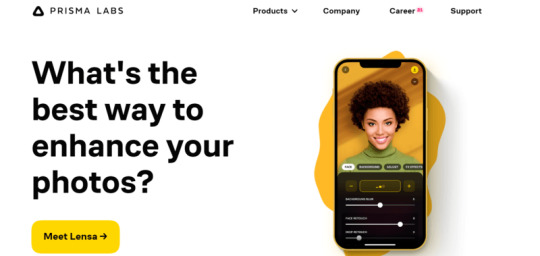
Price: Free
14. Snapseed
Snapseed is Google's own photo-editing application. It enables users to edit and select different effects/enhancements. Alternatively, Snapseed can automatically adjust the color and contrast of your images.
A cool thing with Snapseed is the "save filter" function which enables users to find the filter combination they like most and save it to use again. This Instagram marketing tool also has a cool “Stacks” feature that lets you save groups of filters as a template to be applied to future photos.

Price: Free
15. Vimeo Create
Video is by far the most engaging form of content on social media. Vimeo Create is an excellent Instagram marketing tool that can automatically turn your product images and text into perfectly polished videos.
This is the easiest way to put together great video content for your social media without having any video creation experience.

Price: Free, with the option to upgrade to more advanced video editing tools
16. Boomerang
Boomerang is Instagram's proprietary "stitching" tool. Click a button within the app and it'll take a bunch of photos and stitch them together into a mini-video/gif. This is a fun Instagram marketing tool to make your stories really stand out.

Price: Free
17. Later
Later is another Instagram tool to help you schedule posts. It’s a seriously popular Instagram marketing tool to help you plan, publish, and analyze your Instagram posts.
The free social media tool has the multiple-profile and bulk image upload option of the paid platforms, but it is more simple to use.
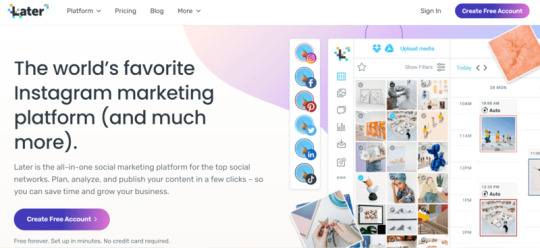
Price: Free, unless you want the Plus Plan at $9/month
18. Buffer
Buffer is a well-known social media scheduling tool, and it works really well for Instagram. When it comes to Instagram tools for scheduling your content, Buffer is one of the easiest to use.
You can easily line up your Instagram posts for publishing, preparing them from mobile or desktop, and Buffer will publish them directly for you. The Premium plan also allows you to create and schedule Stories, add a shoppable Instagram grid to your website, and access detailed analytics on your Instagram account.

Price: Three plans are available, including a free plan, a Pro plan at $15/month, and a Premium plan at $65/month
19. Hootsuite
If you’re looking for a social media management platform to schedule posts and grow your business, then Hootsuite is one of the most popular.
Hootsuite lets you line up posts for your Instagram account in advance, and it will either send you a notification to post them, or it will post them for you if you have an Instagram Business account.
This is one of the most popular tools for Instagram thanks to its many social media management possibilities, its great analytics insights, and easy scheduling. You’ll be able to make your marketing strategy a lot easier with Hootsuite.
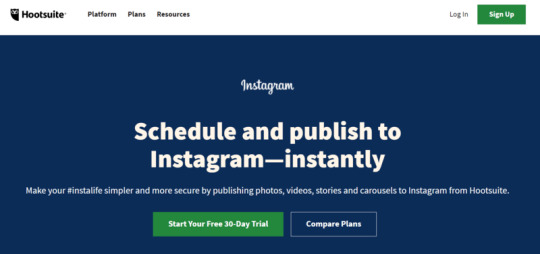
Price: From $29/month for the Professional plan
20. CrowdFire
Crowdfire is a desktop and mobile app that connects your social media accounts, identifies avenues of growth and then recommends content and posts which it believes will drive success for your Instagram profile.
If you want to find related content to your Instagram account, schedule your content, and easily manage all of your social accounts from one place then Crowdfire is a great option.

Price: Four options are available: free, $7.48/month, $37.48/month, $74.98/month \
21. AutoHash
AutoHash offers an easy solution to find relevant hashtags for your Instagram content. The tool uses AI to recognize your photos and automatically find relevant hashtags based on this. It makes sure you don’t go over the hashtag limit.
If you’re scheduling your Instagram posts, AutoHash will save your favorite hashtags in the app, or it will just copy them to your clipboard so that you can set up your posts easily.

Price: Free
22. Adobe Lightroom
Adobe Lightroom is a professional photo editing app to make sure your content looks amazing. If Instagram’s filters just aren’t enough, then Lightroom will let you get the exact look you’re after. When it comes to tools for Instagram editing, Lightroom is one of the best.
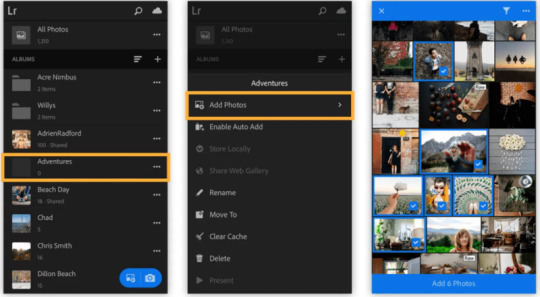
Price: $9.99/month
23. Afterlight
Afterlight is the ultimate Instagram image-prettifying tool out there, giving users:
74 filters
78 textures
128 frames

Price: Free
24. Prequel
Prequel will keep all Instagram accounts up to date and on-trend with its excellent filters and special effects. Prequel’s filters are truly special and can be applied to both still images and video.

Price: Weekly and yearly subscriptions are available
25. Showcase
Showcase, like Like2Buy and others, automatically creates an optimized gallery of your Instagram images (and the merchandise inside them) to enable Instagram users to quickly and easily navigate from your profile to the buying stage.

Price: Free Basic account
26. Display Purposes
This is a simple social media tool that gives you details on Instagram hashtags. You just type in the hashtag, and can access related tags, top posts, and demographics related to that hashtag.

Price: Free
27. Soldsie
Soldsie is another platform which enables Instagrammers to drive and track referral traffic from Instagram to their products. A link in your bio sends Followers and Instagram users to a page of your website which enables them to buy the thing they saw on your Profile.

Price: Three plans are available at $49/month, $99/month, and $199/month
28. Keyhole
Keyhole offers an analytics portfolio, including a useful hashtag tracker for Instagram. You can calculate the ROI of your branded hashtag, measure the impact of your influencer campaign hashtags, and more. This is a great hashtag analytics tool to help grow your business and improve your marketing efforts.

Price: Book a demo
29. Milkshake
Milkshake allows small businesses and solopreneurs to utilize the bio link even if they don’t have a website. You can create a super simple mobile landing page with tappable cards through the platform. This can be updated with blog posts, videos, storefronts, and more.

Price: Free
30. Omnilink
Omnilink is similar to Milkshake in the way that it brings your links together and builds a mini website in the process. However, you get more optimization and analytics capabilities with Omnilink. This option can also be connected to multiple accounts.

Price: Free
Conclusion
I hope you’ve discovered a new tool or app to further your Instagram marketing. Whether you want to access better Instagram analytics, schedule your content, enhance your images and videos, or more, these tools will make a big difference to your marketing strategy.
What are the Instagram tools you love using? Let me know in the comments section below.

Related Content:
15 Instagram Hacks and Features You Didn’t Know Existed
How the Instagram Algorithm Works
How to Make Money on Instagram: 10 Strategies
52 Tips: How to Market on Instagram
47 Tips for Running an Instagram Photo Contest
5 Best Types of Instagram Photos to Drive Engagement
3 Key Hashtag Strategies: How to Market Your Business & Content
113 Visual Marketing Tools and Apps
25 Creative Facebook Contest Ideas You Can Use Today
P.S. Wishpond's Facebook Contest Apps make it easy to create sweepstakes, photo contests, Instagram hashtag contests & more.
from RSSMix.com Mix ID 8230801 https://ift.tt/3B4dobV
via IFTTT
0 notes
Text
Everything You Need To Know About Instagram Creator Studio

If you want to keep your audience engaged, it’s important to stay active on Instagram. Regular posting ensures that your profile appears in the feed of your followers, keeping it top of mind. It also increases your chances of discovery by new users.
While you can use the Instagram app to publish your posts, it lacks the ability to schedule content, which means that if you want to post content at times when you might not be able to use the Instagram app, you’re out of luck.
There are of course a number of third-party solutions available to help you manage your Instagram profile, but while they may offer the features you require, they’re usually paid.
With the introduction of Creator Studio, Facebook has created a free tool that allows you to easily manage your Instagram profile, allowing you to schedule content and more.
Let’s look at what Instagram Creator Studios is, how you can use it, and why it’s a good alternative to third-party solutions in a bit more detail below.

What is the Instagram Creator Studio?
Creator Studio is a set of tools that allow you to post, schedule, manage, monetize, and analyze content on your Facebook pages or Instagram accounts. Although it was first introduced in 2017 as a tool specifically for Facebook, its functionality was limited and was tricky to use.
Relaunched in 2020 with support for Instagram, Creator Studio now has become a lot more popular, in part due to Facebook starting to phase out its Publishing Tools for Pages, and also because unlike many third-party scheduling solutions, Creator Studio is free and a native solution.
With Instagram Creator Studio you can:
Get an overview of all your content (photos, videos, IGTV, Stories, etc.) on your desktop
Schedule your Instagram content
Get insights into metrics of your posts and profile such as performance, follower data, and engagement type
Monetize content and manage brand collaborations if eligible
Before You Get Started with Instagram Creator Studio
Before you can start using Instagram Creator Studio, you need to ensure that your Instagram account is set up correctly. You’ll need:
An Instagram account and Facebook Page
To connect your Instagram account to the Facebook Page
To switch your Instagram account to a Creator Account or business profile if you haven’t already
How to connect Instagram to Facebook Creator Studio
Connecting your Instagram profile to Creator Studio is a simple process once you’ve ensured that your Instagram account is set up correctly. You’ll need to:
Head over to https://facebook.com/creatorstudio
Click on the Instagram icon in the top-center of the page

Click on the Instagram Login button to open the Instagram login page. Follow the instructions to log in.

If you haven’t already connected your Instagram account to a Facebook page, you’ll be given instructions on how to do so.
Congratulations! You’ve successfully connected Instagram to Creator Studio, you can now start using the tool.
How to use Creator Studio for Instagram
Instagram Creator Studio allows you to post and schedule content, get insights into your account, and monetize it. Let’s look at each of these in a bit more detail below.
When you first log in to Instagram Creator Studio, you’ll be presented with your Content Library which gives you an overview of all the content you’ve posted on your Instagram profile. This includes video, photo, carousel, stories, and IGTV content.
You can also view the content types individually by selecting the appropriate tab.

Using the menu on the left-hand side of Creator Studio allows you to navigate through the various sections of the tool, including Content Libary, Calendar, Insights, Monetization, and Instagram Accounts.
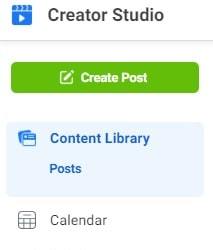
The Calendar tab takes you to a calendar overview of all your scheduled content, Insights take you to the analytics and Monetization allows you to manage your brand collaborations. If you’ve connected more than one Instagram account to Creator Studio, you can manage which ones are displayed from the Instagram Accounts tab.
As the name suggests, the green Create Post button allows you to create a post, which we’ll look at in more detail below.
How to Post on Instagram from Creator Studio
With Instagram Creator Studio you have the ability to create two types of posts: Feed posts and IGTV. To post on Instagram from Creator Studio you need to do the following:
Click the green “Create Posts” button in the top-left corner of the Creator Studio menu.

Select either Instagram Feed or IGTV depending on the type of post you want to create.
If you’ve selected Instagram Feed, a window will pop up as shown below. Here you can add the photo(s) or video of your choice, your description, and the post’s location.

Click “Add Content” to select the file you want to publish. You can either upload it from your computer or from a Facbook page.

To tag accounts in your post click on the “Tag Media” icon below the post. Now click anywhere in your post and enter the name of the account you want to tag.

You can turn off comments by clicking on “Advanced Settings” and changing the “Turn Off Commenting” toggle to the on position.

You can access Instagram’s Accessibility tools and add alt text to your posts by clicking on “Advanced Settings” and adding your description for visually-impaired users.

If you’re happy with your post you can click on the blue “Publish” button in the bottom-left of Creator Studio.

To create an IGTV post from Instagram Creator Studio do the following:
Click the green “Create Post” button and select IGTV from the menu that appears. A window will pop up where you can add a title, description, and video.

Upload your video and add your title and description.
If you want your IGTV video to appear in your feed tick the “Share Preview To Feed” box.
To select the cover thumbnail for your video click on “Cover Image” and either upload a custom thumbnail, choose a video frame, or if you want Instagram to generate one automatically.
If you’re happy with everything, click the blue “Publish” button to share your IGTV video.
How to Schedule Instagram Posts with Facebook Creator Studio
What’s great about Instagram Creator Studio is that it allows you to schedule posts ahead of time, making it easy for you to stay active and post at the right time without having to spend tons of time each day doing so manually.
To schedule posts with Instagram Create Studio, follow the same steps as you would for creating a regular post, as listed above, and then doing the following:
Click on the down arrow on the blue “Publish” button.
Select the date and time you would like to publish your post via the pop-up.

Once you’re happy with the date and time, click schedule to add the post to your calendar. To get an overview of your scheduled posts, click on the Calendar menu option.

Now that you’ve shared your posts, you’ll want to take a look at their performance. You can do this via Insights, which we’ll look at in more detail below.
Insights in Instagram Creator Studio
If you’re looking to find out more about your audience and how your posts performed, you can do so under the Insights tab in Instagram Creator Studio. There are two areas that Insights covers. These are:
Audience: Here you can get information about your followers such as age range, gender, location (top countries and cities).
Activity: Here you can get information about how people engage with your Instagram account. You’ll get access to your posts’ reach, impressions, and actions people have taken (website visits, profile visits, calls, texts, emails, and got directions).
To view your Insights you need to:
Click the Insights tab in the Creator Studio menu
Select either “Activity” or “Audience” depending on what information you want to view
If you choose “Activity” you’ll be presented with an overview of the actions taken on your account and the reach of your account. This includes the number of website visits, profile visits, calls, texts, emails, and people that got directions, as well as the total number of impressions.
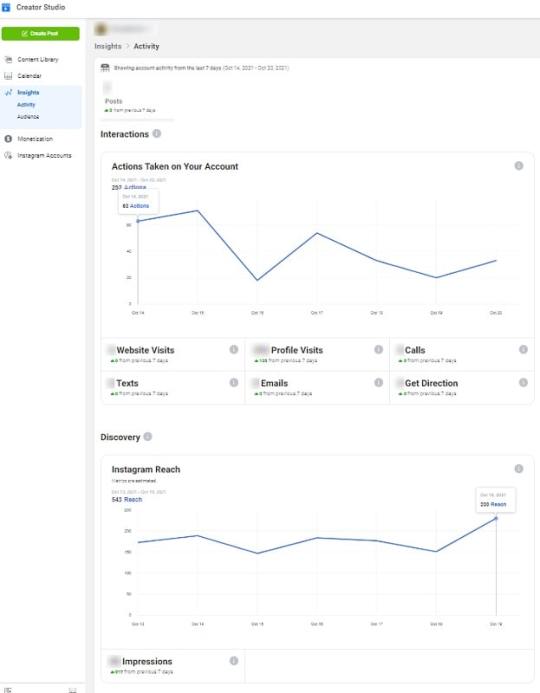
If you select “Audience”, you’ll get an age and gender breakdown of your followers, information about when they are on Instagram, and a list of the top countries and cities that your followers are from.

How to use Monetization in Creator Studio
If you have more than 10,000 followers, you can monetize your content and collaborate with brands. Creator Studio allows you to manage and monitor the status of your monetized content and brand collabs.
To apply for brand collaborations, manage your content, and see which other monetization deals you qualify for, click on the “Monetization” tab in the menu. You will be presented with the Brand Collabs Manager that gives you an overview of your sponsored content.

Using More Than One Instagram Account
If you need to manage more than one Instagram account, Creator Studio lets you easily add more than one and also lets you choose which accounts to display during a session.
Navigate to the “Instagram Accounts” menu item and you’ll be presented with a list of connected accounts.

To add another account, click the “Add Instagram Account” button in the top-left corner and follow the instructions to log in with the account you want to use.

Once you’ve added the account, you can click on the down arrow next to your account name in order to select which profiles you want to view.

Related Content
How to Get More Real Likes on Instagram: 45 Easy & Powerful Tips
Here's What to Post on Instagram: 24 Top Post Ideas & Examples
20 Tactful Instagram Tips You're Missing Out On
How to Market on Instagram: 30 Ideas, Tips & Examples
15 Instagram Hacks and Features You Didn’t Know Existed

Wrapping Up
As you can see from the above, it’s easy to use Creator Studio for Instagram.
Using Creator Studio, you can get an overview of all your content, post to Instagram, schedule posts, view your scheduled posts, view insights about your audience and posts, as well as monetize your content and manage brand collaborations.
All this and you can do it for multiple accounts. Not bad for a free tool!
Do you use Creator Studio? What do you find the most useful feature? Are there any features you think are missing? Let me know in the comments below.
from RSSMix.com Mix ID 8230801 https://ift.tt/3vwpg5g
via IFTTT
0 notes
Text
5 Ways eCommerce Websites Can Make the Most of Their Data

The eCommerce industry is constantly evolving. New trends and technologies are popping up all the time that can help boost your store’s success. One of these emerging trends is data analysis.
Data is the new oil, and eCommerce websites are sitting on a goldmine. You can use data to improve different areas within your business, from customer experience, and conversion rates, to better personalization.
Correctly collecting and analyzing big data has been proven to increase a company's revenue by 25%. It’s a major component in driving success online.
In this article, we'll explore five ways that data can benefit your eCommerce store. You'll discover how data can help you create better content and target customers more effectively. Plus, measure ROI with ease, and increase customer loyalty over time.
What is big data, and why does it impact eCommerce?
Firstly it’s important to understand the buzzword that has become synonymous with data collection: Big Data.
Big data involves sorting through large quantities of data to reach a scientific and statistically backed solution to a problem. Because of its significant insight, it has the potential to transform eCommerce.
Big data analytics has an impact across many different facets of eCommerce. For example, data can allow you to:
Analyze customer behavior and sentiment across social media
Better tailor marketing messages
Detect fraudulent transactions
Target customers by behavioral attributes
Create personalized campaigns with relevant offers and messaging
Implement dynamic pricing strategies
Enhance customer satisfaction by providing a relevant and seamless experience.
However, big data can sometimes come with one big downside, and that’s data silos.
The Elephant in the Room - Data Silos
Unfortunately, the process of using big data to power substantial business benefits isn’t always as straightforward as it sounds.
Before eCommerce companies can analyze, evaluate and action their data, they have to face a very common occurrence: data silos.
A data silo is when a database does not integrate or coordinate with other databases because it was never intended to do so. Data silos happen naturally but can cause problems when you try and combine the different sets of data into one cohesive system.
The problem is particularly common among eCommerce companies. Especially those that use a variety of tools within their MarTech stack that do not integrate together. They may try and find workarounds, but the problem always persists.
Ultimately though, data is siloed off, which is a huge missed opportunity.
Common eCommerce data silo examples include:
Email marketing lists: Email data collected in-store with low-level accuracy. This data may then be fed into the sales department CRM with overlapping data.
eCommerce customer data: This is often separated from in-store customer data
Regional business data: This becomes separated because of different geographical locations—for example, data collected at different stores across the country or globe.
Marketing data: This is often siloed by its channel, i.e., social media or email marketing.
Thankfully, there are ways to unlock and overcome data silo challenges for eCommerce companies - they just need to integrate them.
Integration can take place by using specialized software, like a customer intelligence platform. These platforms enable companies to identify and gain comprehensive views of their customers. They also help to ensure that recent data is automatically updated across teams. This unifies the data throughout departments and breaks down data silos.
Other methods include using a Customer Relationship Management Software (CRM) with integration capabilities. Or even the slightly more time-consuming and manual option of undertaking a company-wide data audit.
Of course, when it comes to collecting and using data, you need to get user consent and ensure you are compliant with conditions such as GDPR. Building a single customer view and breaking down data silos has to be done with caution.
With all the data available to eCommerce websites, the key is making the most of it.
So here are five lucrative ways to do just that.

1. Forecast Trends and Demand
Big data has revolutionized how people can predict what will be next season's best-selling product. By introducing trend forecasting algorithms, businesses can eliminate any guesswork when predicting trends. Knowing with certainty what products they should invest their money into for maximum profit potential.
Likewise, with forecasting demand. All businesses will forecast demand to some degree, whether it's an eCommerce shirt seller estimating that a new design will prove particularly popular or an ice-cream seller forecasting that their ice cream will sell quicker in the summer months than the spring.
Many business owners will base these decisions on gut feel or what seems like the best guess at any given moment. This can lead to overstocking and wasted inventory if you're not careful.
By basing forecasts on historical and reliable data, you're in a much stronger position. There shouldn't be any decisions just based on intuition anymore.
1.2 Analyse Dynamic Pricing
Provided there is enough data, customers can be evaluated by their spending patterns and on-site behavior. Once a user is on the site, you can immediately collect data and "classify" the type of user they are. Are they showing a high propensity to buy? Are they brand new to the website?
All this data can be used to tailor their experience to achieve your desired outcome.
For example, if a user is looking to book an appointment online at a dentist or a car service prices could vary. Looking into the data, if Saturday at 10 am is a popular time with high demand, you could charge a premium.
We can see this implemented below by UK garage chain Kwik-fit. They vary the price for the same service depending on what time you wish to book.

Other examples include:
Uber – Uber will calculate its ride fees depending on demand. Users can see these prices and be alerted to higher prices due to higher demand within the app before committing to a booking.
Easyjet, Ryanair – Flight prices are constantly being reviewed and altered depending on demand and how early or late the booking is.
2. Provide Highly Personalised User Experiences
By using data, eCommerce sites can create personalized experiences for their customers.
They can learn what items are popular among a customer's buying history, and then they show them more of that item on the site.
Or offer discounts based on how much time the user spends browsing various products within an online store.
For example, data could identify someone who buys large appliances but never buys clothes. The website could then recommend deals or upgrades relating to their available large appliances.
2.2. Action Behavioural Segmentation and Targeting
Behavioral targeting, also known as behavioral marketing, is the process of targeting potential customers by matching their interests and behaviors with products that may appeal to them.
This new form of online engagement uses Big Data to help understand your customers better. The websites they like, what kind of product pages they spend more time on, etc

By using behavioral analysis, you can then plan your marketing campaigns around this. For example, sending personalized emails with discount coupons at certain times each year. If you capture customer's birthdays you can send a unique discount code as a "happy birthday" treat.
Not only will this likely convert, but it’s also a great way to provide a more connected and personalized experience with customers.
3. Deliver Better Optimized Marketing Campaigns
You'll never send a generic campaign again once you integrate big data into your marketing campaigns. Big data is the key to big optimization, and it's only getting bigger every day!
Marketers who understand and value the importance of relevance and timeliness will love big data. The opportunities it presents allow for more creative and impactful campaigns.
Campaigns can be shaped around customers’ preferences and identified needs in real-time. This allows retailers to deliver more personalized experiences, which 67% of customers want.
For example, personalized email messages containing relevant content should always prioritize impersonal emails with irrelevant materials - even if they're less expensive. That’s because what matters most to customers is how much they enjoy using the product/service being marketed at them.
Take a look at the below example from budget airline EasyJet. For their 20th anniversary, easyJet wanted to do something special for each customer. They emailed customers a personalized story highlighting everywhere they had traveled in the past two decades. They finish off the email with a subtle CTA of "where's next"?
The email also highlights where nearby airports served by easyJet may be located that would allow them more places around the world at an affordable price point.
The email also highlights where nearby airports served by easyJet are located. The extra touch is EasyJet highlighting the extra places these alternative airports serve. Allowing customers to find new places to travel at an affordable price.

Another elephant in the room for most marketers is that of the “cookieless future,” which is now likely to come into place in 2023. At the moment, there isn’t a single solution to this. Google also looks like they themselves may need more time to address this change.
One thing is for sure, however, and that’s the importance of first-party data. It’s now more important than ever to ensure you’re collecting it safely, accurately and are in a position to use it to your benefit.
4. Improve Customer Service
Big data can revolutionize customer service from monitoring emails and social media campaigns to observing online self-service tools. Big data can support your CS team.
Collected information can be quickly analyzed to identify possible drawbacks in customer service. You may not even know some of them exist.
From incorrect orders to refunds, to complaints your customer service team deals with it all. Multiply this by email, text, live chat, social profiles, and the job becomes a lot bigger to manage.
This is where big data can help.
A connected data ecosystem will allow customer services teams to have access to all the data they need. Very quickly.
For example, if a user queries a specific order number, your CS team will be able to find out everything they need to in seconds. When they ordered it, the delivery status, maybe even a delivery ETA.

The above example shows this in practice. A user with an issue tagged the wrong profile, but Nike Support still jumped in and attempted to resolve the issue.
5. Provide a 360-Degree Customer View
A 360-degree customer view is the most comprehensive way to measure a company's customers. With it, you'll be able to see all interactions a customer makes with your business, from past and present purchases to customer service queries and complaints.

Big data fuels the creation of a 360 view. Tracking and storing different customer interactions, touchpoints, and preferences in one location.
Once you have that 360 customer view, you're really in business. You can share this with different departments, marketing, sales, and customer services, for example. This allows each department to create a tailored experience for that customer.
Providing that personalized customer experience cultivates trust and builds strong fulfilling customer relationships. Which will ultimately boost revenue, reduce churn and amass brand loyalty.
As we mentioned earlier, this needs to be done with explicit customer consent, and in a compliant way.
There are a couple of ways you can achieve a 360 customer view.
1. Conduct a data audit
You’ll need to understand all the points at which you collect customer data, how it’s collected, and what format it’s in.
You’ll need to determine if your data is being collected in a consistent format which can be used/linked throughout the business. If not, how you can address this and agree on a "standard" format and begin to enforce this.
2. Use a CDP
As the term “360” suggests, you’ll need a way of consistently monitoring as many touchpoints as possible. You’ll also need to get a handle on 1st, 2nd and 3rd party data. This isn’t easy or even possible if you don’t have the right software. This is where a Customer Data Platform (CDP) comes in.
CDPs aggregate and organise customer data from multiple touchpoints, consolidate it into individualised customer profiles, and then allow that data to be used by other pieces of software, systems and MarTech stacks.

Related Content
14 Best eCommerce Marketing Tips & Strategies to Boost Sales
30 eCommerce Marketing Strategy Examples with Proven Success
7 Best eCommerce Experts You Should Know & Their eCommerce Best Advice
11 Common eCommerce Marketing Mistakes (And How to Avoid Them)
How to Sell Online Without an eCommerce Website
Conclusion
eCommerce companies can gain a competitive advantage and revolutionise their businesses just by making the most of their data.
In summary, the five ways eCommerce websites can make the most of their data is to:
Forecast trends & demand
Provide highly personalized experiences
Deliver better optimized marketing campaigns
Improve customer service
Gain a 360 customer view
Ensuring big data can be used seamlessly across the business, without data silos is a must. The possibilities this will present your business are almost endless. You'll find new ways to grow revenue. Your customer service team will be able to provide better and quicker responses. You'll be able to provide a better customer experience.

Written by our guest writer Hannah Stewart, head of Marketing and Business Development at Zeotap, the home of the next-generation Customer Data Platform.
Zeotap empowers brands to unify, enhance and activate customer data in a cookieless future, all while putting consumer privacy and compliance front-and-centre. Recognized by Gartner as a "Cool Vendor", it works with over 80 of the world's top 100 brands, including P&G, Nestlé and Virgin Media. It is also the founding member of ID+, a universal marketing ID initiative.
Prior to joining Zeotap, Hannah led the Marketing and SDR functions at Yieldify, a martech company selling CRO solutions to e-commerce businesses in the US, UK and Australia. She started her career (after a detour teaching English in Japan) at Weber Shandwick and Nelson Bostock, working with companies including Samsung, Canon and HTC on global communications strategies before jumping ship to startups with a product marketing role at Monitise, a mobile banking business since acquired by Fiserv.
.flex-container { align-items: center; display: flex; flex-direction: column; justify-content: center; } @media(min-width: 768px) { .flex-container { flex-direction: row; } }
from RSSMix.com Mix ID 8230801 https://ift.tt/2Z33yK3
via IFTTT
0 notes
Text
10 Marketing Tips to Help You Thrive as a Solopreneur

Out of the 30 million small business owners in the US, approximately 81% of them are solopreneurs. Being the only person in charge of your business has loads of benefits, but it also brings many challenges. One of these is marketing.
Good solopreneur marketing is essential if you want to attract new customers and grow your business. The problem is marketing requires a lot of time and effort, which is something solo entrepreneurs often can't always find.
The good news is that there are plenty of highly effective digital marketing strategies that are perfectly suited for people running businesses alone. Follow our guide to the most essential marketing tips and tactics to help solopreneurs thrive.
1. What is a Solopreneur?
2. Solopreneur vs Entrepreneur: What's the Difference?
3. 10 Solopreneur Marketing Tips
4. Solo Entrepreneur Marketing Done for You
5. Conclusion

What is a Solopreneur?
A solopreneur is someone who sets up and runs a business all by themselves. Loads of small businesses start out as solopreneurs. And even as they experience business growth, many entrepreneurs prefer to just do it alone and keep the business a one-person operation.
Being a solopreneur involves handling all elements of a business yourself. This includes accounting, marketing, product development, logistics, and everything in between.
In today’s online world, the possibilities for solopreneurs are promising. This is because so much can be done online, and there are lots of great digital tools that make running a business easier.
Solopreneur vs Entrepreneur: What’s the Difference?
All Solopreneurs are entrepreneurs, but not all entrepreneurs are solopreneurs. The main thing to note about solopreneurs is that they do all of the work themselves. They’re both the founders of the business, as well as all of the employees. An entrepreneur, however, starts a business but takes on more employees as the business grows.
Another big difference between a solopreneur and an entrepreneur is how they scale the business. While most entrepreneurs set up businesses with the plan to scale them over time, solopreneurs aim to keep their business at a size that suits a single person.
This means that solopreneurs need to have a very specific and clear marketing strategy in place. They need to be able to grow their business to a profitable level, but they can’t grow the business beyond the point where they need to bring on more people.

10 Solopreneur Marketing Tips
As a solopreneur, you’ve got a lot on your plate. Marketing is essential for any business, but it can be really hard to get it done properly when you’re operating alone. To help you, here are 10 of the best marketing strategies and tips for business owners that do it all themselves.
1. Use Automated Email Marketing
Email marketing offers some of the best return on investment possible. In fact, for every $1 spent on email marketing, $42 can be generated.
Email is an amazing way to build relationships with customers, attract new leads, and promote your services. With the right tools and tactics, email can also be an easy digital marketing strategy to handle alone.
Automated marketing allows you to put your emails on autopilot. You can set up workflows that send specific emails to specific people based on their actions. This means you always send the right content to the right person, without having to actually send out the emails yourself.
You’ll save loads of time, and can watch your small business grow as you focus on other tasks.
With a marketing automation tool like Wishpond, setting up automated email campaigns is incredibly easy. This allows business owners to achieve big results with minimal time or effort, which is perfect for busy solopreneurs.

Above: example of an automated email campaign
2. Choose Fully-Integrated Marketing Software
Any digital marketing strategy today relies on the use of marketing software. If you’re using lots of different software options, this can get time-consuming, confusing, and expensive real fast. As a solopreneur small business owner, you just don’t have the time or resources for this. This is why using a single marketing software solution for your small business is such a good idea.
With a fully integrated platform, businesses can take care of all their digital marketing needs from one space. You’ll save loads of time while staying on top of all your digital marketing tasks far more easily.
For example, a platform like Wishpond allows business owners to run email marketing campaigns, build landing pages, create social giveaways, accept online payments, set up various lead generation campaigns, and more all from one platform. With a single solution like this, running a solopreneur business becomes a lot more easy and efficient.

3. Have a High-Quality Website That Works for You
Your website can make or break your solopreneur business. This is where all of your potential customers will end up before reaching out to you, and so it needs to fill them with trust and confidence.
Use your website to introduce yourself, share your story, and reveal why new customers should choose you. Use high-quality images, and make the website simple to navigate.
A good strategy is to offer different landing pages for your different products or services. This is important for local marketing, as well as improving your SEO visibility. Having the right landing page builder will be a big help to solo entrepreneurs.
You should also make sure that it’s easy for your website visitors to get in touch with you, set up appointments, and subscribe to your newsletter. The more your customers can do on your website, the fewer time-consuming admin tasks you’ll have to do.
So if you set up things like an appointments calendar, an online form to request services, and a payments gateway, you can cut down your business admin in a big way.

4. Schedule Your Marketing Content in Advance
A major part of digital marketing is creating and publishing quality content. Content marketing covers blogging, email marketing, social media marketing, and more.
This is one of the most effective ways to increase brand awareness, attract your target audience, build trust, maintain customers, and promote your products or services. The downside is that creating marketing content is a time-consuming process that solo small business owners often struggle to find the time for.
A simple solution to this is to schedule your content in advance and continue with other work tasks while your content is published.
You could spend some time coming up with a monthly content calendar, and then use apps to schedule your content for specific dates. This way, you’ll still be able to publish a consistent flow of content throughout the month, without having to dedicate each day to your digital marketing.

Source
5. Get Started With Video Marketing
Speaking of content marketing, video is one of the most powerful forms of content out there. It’s the best way to really engage your audience, grab their attention, and introduce your brand. And as a solo entrepreneur, it’s really important that your customers know who you are.
Today, creating a video marketing strategy is easy, and it can help you to achieve great results for your business. You can use videos on social media, add videos to your landing pages introducing your products and services, utilize video testimonials, create longer-form YouTube video content about your business, and more.
View this post on Instagram
A post shared by SUNSHINE COAST HAIR AND MAKEUP (@meraki__artistry)
6. Set Clear Marketing Goals
Marketing a business alone can be a daunting task, especially when you’ve got many other things to do at the same time. The best way forward is to have a clear plan of action each day, and a set of actionable goals that you’re aiming for.
This allows you to focus and refine your marketing efforts without wasting time experimenting with different channels and blindly posting on social media. Having clear goals in place also means you’ll be creating a marketing strategy to fit the needs and scale of your business. This is important for solopreneurs.
Starting with goals helps you actually meet the marketing targets for your small business. Try to make these goals highly specific and measurable. This allows you to review your marketing efforts and continually refine your strategy.
7. Focus On Evergreen Marketing Content
Evergreen content is the type of content that stays relevant for a long period of time. A good example of this would be an SEO-optimized blog post that continually ranks at the top spot of a search engine for years. Sure, evergreen content is great for any business, but it’s particularly useful for solo entrepreneurs.
This is because of two things. Firstly, solopreneurs don’t have a lot of time to spend creating new content. Instead of creating new videos and writing new blog posts every day, they can continually send traffic to their website from a single piece of content.
Secondly, solo entrepreneurs have a limit to how much they can scale their business. With a few pieces of consistent content (compared to a consistent string of new content), it becomes easier to manage your traffic and business growth.
So, how do you create evergreen content? Whatever form of content it is, always make it relevant for an indefinite period of time. Don’t just focus on trends and timely topics, but think about content that your audience will still be searching for years from now.
Great evergreen content that does well with SEO should also offer a lot of information. Creating ‘ultimate guides’ is probably more effective than publishing many shorter guides in this case. For evergreen content, you should also spend time regularly updating the content to make sure that it’s never outdated.
Evergreen content like this could be in the form of a blog post, an eBook, a YouTube video, a podcast, or anything else. It will be able to drive consistent traffic to your site, generate a steady flow of leads, and help your company to stay visible to the right customers.
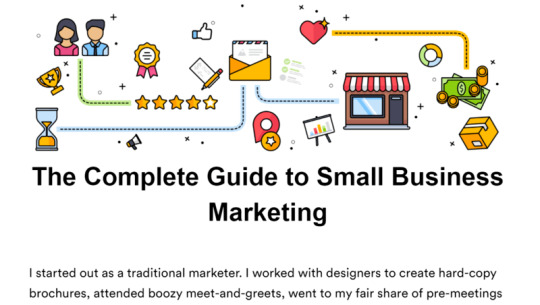
Above: an example of evergreen blog content
8. Show Your Personality and Expertise With Live Events
If you run a small business alone, then you are essentially the business yourself. A big part of solo entrepreneur marketing is making your personal brand a part of your business. And a great way to achieve this is through live events.
Not only do virtual events allow you to show your personality and expertise, but they also allow you to address a large audience at once. You can answer all of your customers’ questions and address common pain points without having to reach out to customers individually. This will save a lot of time, and act as a helpful resource for future marketing efforts if you record it.
You can do live social media events or host webinars on platforms like Zoom. This is a great way to increase brand awareness, generate new leads, and reveal the person behind the business.
youtube
9. Share Your Solopreneur Journey
Everyone loves a success story.
As a solopreneur, plenty of people will be interested in how you built your company and what your journey looks like. Instead of waiting until you’ve reached your end goal, start to share your business journey now. This will help to bring across your personality while getting more people interested in your business.
You can release videos about your business journey, write blog posts, and share your experience on social media. You could start to build an engaged community by doing an Ask Me Anything post on Reddit or even start a podcast. This may sound silly to new small businesses, but it can do wonders for enhancing your authority and building an audience.
View this post on Instagram
A post shared by Shopify Expert + Web Designer (@kaitlinfontenot)
10. Spend Time Engaging With Your Customers
As a one-person business, your customer base expects you to be fully engaged with them. Unlike big companies, solopreneur customers want a more personalized experience. They’re not just dealing with a business, they’re dealing with an individual.
Make sure that you pay extra attention to customer service and engagement. Try to spend some time each day responding to any comments, questions, or reviews on social media. Reach out to customers asking for feedback, and include a level of personalization in your daily business operations. This will go a long way in building up a base of happy, loyal customers that trust your business.

Solo Entrepreneur Marketing Done for You
As a small business owner doing it all yourself, you probably don’t have the time to manage all of your marketing campaigns while servicing your customers. We get it, digital marketing requires a lot of effort and expertise.
Instead of hiring an expensive marketing agency, or taking on new hires, Wishpond offers the ideal solution for solopreneurs. With Wishpond, you can access all of the tools you need in a single platform, alongside a team of experts to create campaigns for you. You’ll save loads of time, while your marketing is in expert hands.
Book a demo today to see how Wishpond can help you grow and manage your business.

Conclusion
Whatever kind of products or services you sell, having a good marketing strategy in place is vital. With the right strategies and tools, anyone can create high-impact marketing campaigns while still having plenty of time to manage the daily operations of their business.
Follow the tactics listed above, and marketing your solopreneur enterprise will become a whole lot easier.
Are you a solopreneur? Let us know your thoughts and experiences of marketing in the comments below!

Related Content
20 Best Local Marketing Strategies and Tips
How to Build a More Complete Content Marketing Strategy
The Complete Guide to Small Business Marketing
The Comprehensive Guide to Effective Social Media Marketing
15 Low-Cost Alternatives to Paid Advertising
A Step-by-Step Guide of a Complete SaaS Marketing Campaign
9 Must-Have Marketing Tools Business Owners Need for 2021
from RSSMix.com Mix ID 8230801 https://ift.tt/3vpZxeR
via IFTTT
0 notes
Text
What’s Next for Remote Work?

Since 2020, the whole world has shifted to remote work schedules. While some companies are adopting a permanent remote working culture, others are investing in massive new office spaces.
Google recently announced that they will be spending $2.1 billion to buy a huge new Manhattan office space, while Apple has been pushing back its return to office plans. Beyond these giant companies, small businesses all around the world are changing the way they operate through remote work.
Is remote work really the future, or was it just a pandemic trend? Does remote work benefit or slow down businesses? And what are some remote work trends we’re facing right now?
We explore this in our guide all below.

Employees today don’t even want to return to offices as cool as this. Source.
1. The Global Shift to Remote Work
2. Is Remote Work a Long-Term Solution?
3. Advantages of Remote Work for Businesses
4. Remote Work Challenges
5. What Will the Future of Remote Workspaces Look Like?
6. Hybrid Work Trends
7. Wrapping Up
The Global Shift to Remote Work
The Covid pandemic of 2020 resulted in a lot of big changes for the world - one of the biggest being a new wave of remote working. Out of nowhere, offices around the world shut down as their employees moved their work to their homes. What may have seemed like a temporary situation during lockdowns quickly turned into the new norm.
Businesses that once relied completely on physical office spaces realized that they could continue their operations remotely. With this realization comes the question of whether remote work is a permanent fixture, or a short-term trend?
Today’s modern employees choose to spend 40% of their time working from home, and 62% of employees now expect their employers to let them work remotely going forward. On top of this, a whopping 83% of employees say they are more productive working from home.
Looking at the way things are going, it seems like remote work is the direction the world is taking. So what does this mean for small businesses? And is remote work really the best solution?
Is Remote Work a Long-Term Solution?
Now that employees are getting comfortable working from home, businesses are starting to question if they will ever return to their offices again.
Let’s go back to Google’s New York office plans. The city’s real estate industry was completely cut down during the pandemic, but now Google will be paying one of the highest prices in the last couple of years for an office building in the US. Clearly, this major company sees a big future in office spaces.
About 28% of office workers in this region had returned to the office during the time Google announced their plans. This is more than double the rate a few months ago. So clearly the world doesn’t plan on being fully remote just yet.
Companies are starting to return to the office, although this doesnt mean that offices are looking the same as they once were. As companies start to reopen, they need to consider the new wave of remote workers. Office spaces are being cut down to align with the new way of working. For example, Conde Nast, whose offices are close to the new Google office, is cutting down on office space in a big way since the pandemic saw their employees take their work remotely.
For companies that have already established remote working strategies, there’s no major need to go back to office spaces.

Google’s new Manhattan office building. Source.
Advantages of Remote Work for Businesses
Working at home in your sweat pants may sound like the dream for most employees. While remote working might be questioned by some, it does offer a range of unique benefits to companies of all sizes.
At Wishpond, we have successfully transitioned to a fully remote company and we love it. We get to collaborate with people all around the world and enjoy the perks of working from any environment we choose.
As Jordan Gutierrez-Keever, COO of Wishpond, says:
“Being remote helps us reach talent without borders, we've been able to find great employees in over 15 different countries”.
Here are some reasons why remote working should be considered.
You Get to Work With People all Over the World
With online work and communication technology improving, businesses can now find talent all around the world. Instead of being limited to employees in your area only, you can now sift through a much larger pool of candidates to find the perfect match for your business.
As a business owner, this means you don’t have to just settle for the best candidate in your area, you can find someone who really offers the most to your business. Beyond the fact that you can choose from a larger talent pool, working with people around the globe is also exciting. You can create a more diverse and multicultural business, which has many advantages.
And being able to choose from talent around the world allows you to find people with specific skills more easily. Instead of trying to find the only German speaker in your area, you can now reach out to Germany directly.
Working with employees all around the world also makes it easier for many businesses to find clients from different countries.
Can Small Businesses Take Their Staff International?
Even if you are a small local business, remote work gives you an opportunity to find employees around the world. This could be for administrative staff or marketing staff that don’t need to be based at your physical location.
As a small business, this also means you might be able to find staff that you can afford more easily. Many small businesses put exchange rates in their favor to hire skilled employees that they can afford.
You Get to Work From Anywhere in the World
Just as you get to work with people based all around the world, you can also work from anywhere in the world yourself. Ever fancied the idea of working in a hammock between two palm trees on a tropical beach? Now you can.

Achieve a Better Work-Life Balance
Maintaining a strong work-life balance is important for both managers and employees. Working from home allows employees to unlock more hours out of each day, through things like skipping the daily commute.
An important result of remote work is the improved work-life balance, which means happier and more productive staff. Of course, employees can also struggle with blurred lines between their work and home life.
Enhanced Productivity
Remote has been proven to improve productivity rates. In a study done by Stanford, the results showed a rise in productivity that equals a full day’s work.
Without unnecessary coffee breaks, commutes, and a more comfortable working environment, employees have been proven to get a lot more done. On top of this, sick days and employee attrition also decrease with remote work.
Remote Work Saves Businesses Money
Cutting down on renting office space can have a major impact. The Stanford study mentioned above also showed that businesses could save around $2000 per employee by cutting out office spaces. When you think about things like electricity, office equipment, rent, heating, and parking bays, the costs really add up.
Remote Work Offers Better Employee Wellbeing
Finally, employees can enjoy a better state of wellbeing through remote work. By working from home, you can have the time to fetch your kids from school, see friends, eat a home-cooked lunch, and fit an exercise routine into your day.
With more time available, employee wellness improves. This helps to reduce stress levels, improve productivity, and increase job satisfaction.
“I really enjoy working fully remote because it allows me to get up later, not have to worry about traffic, and I can use the saved time to work on personal projects,”
said Themba Kriger from Wishpond.

Remote Work Challenges
Remote work certainly has its benefits, but these don’t come without challenges. Not all businesses are able to transition to fully remote work environments and the ones that do generally face plenty of speedbumps along the way.
Here are some common challenges that businesses face when moving their operations away from office spaces.
Distractions and Loneliness
Getting away from certain coworkers may have been a dream when you were in the office, but you could soon start to miss them. According to a recent study, loneliness is the second biggest struggle to remote work. This is a problem found alongside struggling with distractions at home, and not being able to unplug after work.
At the office, you’ve got nothing to focus on besides your work. At home, distractions are everywhere. Being alone can also have a negative effect on employee wellbeing and happiness.
Timezone Difficulties
The ability to spread your team around the world is a major advantage, but it can also be a challenge. When you’re working between different timezones, communication can be affected in a big way.
Workers at other ends of the world work different hours and struggle to overlap their schedules. Or, they could work the same hours while one worker sacrifices their time by working the graveyard shift -which is not ideal.
Collaboration and Communication
When you’re not sitting next to your team members at work it’s easy to miss out on what everyone’s busy with. Even if you have regular meetings and use efficient communication tools, staying up to date with every action is tricky.
Collaboration and communication are essential for the success of any business operation.
Home Network Problems
Nothing hurts a remote workday more than a bad wifi connection.
Remote teams need to be properly sorted with a strong wifi connection, and adequate hardware in order to keep their productivity levels up to standard. Ensuring that a large team is all equipped with a good enough wifi connection can be a challenge.

What Will the Future of Workspaces Look Like?
This is a tricky question to answer because different companies have different opinions about the need for office spaces.
The percentage of permanently remote employees is expected to double in 2021 compared to the 16.4% level before the pandemic.
Major companies, like Facebook, REI, and Shopify have also announced that some form of remote work will remain an option for workers in the future. It seems that remote work isn’t going anywhere.
Some companies are taking this even further by introducing a 4 day work week.

At the end of the day, the most important factor in deciding between remote and office-based work for a business is productivity. A 2021 survey showed that 52% of employers think that productivity levels have increased since their teams started working remotely due to the pandemic.
It seems that remote work will become a major focus for businesses going forward. If you’re considering starting a business, or are concerned about your current working environment, it would be a good idea to start focusing on how you can utilize remote work in the future.

Hybrid Work Trends
When looking at remote work trends, it seems that hybrid work is the direction that we’re heading. Hybrid work is a model where some employees head back to the workplace from remote working, and others continue to work from home. Most big businesses, like Microsoft, have implemented a more flexible hybrid working from home approach.
When we look at the movement towards working remotely and creating a hybrid work environment, there are a couple of remote work trends and considerations that stand out. We’ll outline these below.
Flexible Work Seems to Be the Future
In our post-pandemic world, the biggest work trend is flexible work. We’re not talking about flexible hours as much as we’re talking about the flexibility of working from home.
With this work trend, employees can enjoy the benefits of both working remotely, as well as in an office space. This is why 66% of business decision-makers are busy redesigning their physical office spaces to better accommodate flexible remote work trends.
One challenge of this is understanding where to invest. Should businesses invest in remote employees by helping them set up their home office spaces? Or should companies focus on their own offices?
What is the Price of Productivity?
We’ve already covered how remote workers are more productive, but how exactly is this affecting them? Is the work-life balance better when working remotely, or do team members blur the lines when they work from home?
One trend we’ve noticed about working remotely is that the digital intensity of remote workers’ days has increased. When working remotely, we’re faced with more meetings, more chats, more emails, and more time spent online.
A lot of remote workers struggle to turn off, and many are expected to respond to work queries and be available around the clock. If employers don’t pay careful attention to the work-life balance, remote jobs can be non-stop.

Source
Networks Could Get Smaller
Even though working from home allows you to connect with anyone, anywhere in the world, data has shown that the shift to working from home has actually shrunk our networks. People that work from home tend to have increased interactions with their close networks, but they spend less time expanding their broader network.
This means that companies that work from home could become more siloed than they were before 2020. A downside of this could be a decrease in innovation. While working from home full-time could continue to shrink our networks, hybrid work trends could help us to see more growth in this area.
Cybersecurity Becomes More Important
40% of organizations that work from home have shown concern about cybersecurity risks. This means that the future of remote work will likely include a heavy focus on cybersecurity, the use of VPNs, and increasing compliance and security training processes within companies.
Companies with remote workers need to find the balance between flexibility and security. This is especially true as remote workers change their locations and implement a more nomadic lifestyle.

Reskilling and Upskilling has Become More Important
Another big trend that has come out of work-from-home businesses is that more career path opportunities have opened up with remote work. Upskilling and reskilling have become an increasing trend because workers now have more flexibility about the paths they can choose.
With more remote jobs becoming available, freelance work has also grown. This means more people are looking into different opportunities and areas that they can shape their careers. Online learning, upskilling, and exploring new directions is a major work from home trend right now.
Flexible Work Hours Are On the Rise
Many organizations have become more open to flexible hours as they have shifted their workforce to remote work. Working in a traditional workplace is limited by specific office hours, which is completely freed up when you work from home.
One of the big benefits of working from home is greater flexibility, which workers are taking full advantage of. Taking on a more flexible work schedule is also changing the way that companies operate (because now they could have workers online around the clock).
Work Has Become More Human
Even though there is a physical distance with remote work, many companies have found that working from home has actually helped to create more of a human connection within a workforce.
Instead of the regular office culture that we’re used to, workers now present a more realistic view of their lives to coworkers. This includes dogs barking during meetings, children playing next to a work desk, and a workforce adjusting to each worker’s personal schedule.
This has helped to improve work relationships and make people feel more comfortable to reveal their at-home life. This adds up to a more comfortable and happy work environment.

Wrapping Up
Remote work doesn’t seem to be going away any time soon. In fact, businesses are focusing on developing their future operations around remote work.
Here at Wishpond, we’ve got hundreds of people based all around the world - and it works great. Even though Google is investing so much in their new office spaces, it doesn’t mean remote work is over.
Sure, many employees are returning to the office, and remote work doesn’t always work out for every business. But it seems that remote work is only getting stronger, and it will continue to be an important area of focus for businesses in the future. Let’s also not overlook the fact that 83% of workers say they are happier working remotely.
Do you work remotely? Or do you run a business with remote staff? Let us know your experience in the comments below.

Related Content
The Rise of AI in Business
The Rise of Augmented Reality
The Pros and Cons of a 4 Day Work Week
7 Disruptive Marketing Tips to Win Over More Customers
The Top Places for Remote Workers
Should Your Business Accept Bitcoin?
from RSSMix.com Mix ID 8230801 https://ift.tt/3jfseGC
via IFTTT
0 notes
Text
7 Ways to Convert Leads Using Instagram Stories Like a Pro

Lately, we’ve seen a slew of new features and tools that come with social media apps, and Instagram is a strong pioneer on that front. And in this particular post, we want to highlight the power of using Instagram Stories as the ultimate lead generation machine you didn’t know you had.
As it stands, many online businesses that use Instagram Stories resort to using it for its most basic features. They might reshare their Feed posts to their Stories. Or they’ll use it to constantly talk about their products and services like a free online billboard.
While there’s nothing wrong with these tactics, we know that there’s a better way. So instead of simply using Instagram Stories as another place to echo the same content you’re already publishing on your feed or other platforms, try this on for size.
Here are 7 highly effective ways you can convert followers into leads and sales using Instagram Stories.

How to Use Instagram Stories for Lead Generation
1. Cross-Post Your Instagram Stories to Facebook
This feature has been available for a while now, but recent improvements have made this process easier. By cross-posting your Instagram Stories to Facebook, you not only get to share the same content on two platforms automatically, but you’re able to leverage Instagram Stories’ powerful features and get them to translate on Facebook Stories too.
For example, when you put up Polls on your Instagram Stories and cross-post them, they’ll also appear on Facebook. They add that extra engagement people need to interact with your brand on a platform as busy and crowded as Facebook.
Another reason this tip is worth doing? Your Facebook page might have more followers than you have Instagram followers. This is true for many brands and businesses, so make the most of these new social media features.

How does cross-posting your Stories on Facebook generate leads?
If you create the right kind of Instagram Stories that attract the attention of even your Facebook followers, you’ll have a better chance of getting users to check out your Facebook page.
On your Facebook page, you might have feed posts that link to free lead magnets and offers, or you have a clear CTA for customers to check out your promotions on your online store or book a call.
There’s no denying that Instagram is a little more limited in terms of redirecting users through links. And it takes no effort to auto-publish Stories on Instagram to Facebook, so you don’t lose anything by making this part of your strategy.
2. Create Opt-In Forms Using the Question Sticker
We mentioned in the previous section that Instagram is limited in its link abilities. Because of that, it’s hard to direct users to different landing pages, especially ones for lead generation and collecting emails.
What’s the workaround for this? We have a solution: the Question Sticker on Instagram Stories.
Brands and creators normally use the Question Sticker to get users to interact with them. Thought leaders use this to let their users ask them questions they’ll then answer, and brands use this to collect short insights and thoughts from their customers.
But what if you turned this Question Sticker into a lead generation form?
Here’s how to do it.
If you’re on Stories promoting a free lead magnet, say a free downloadable that you want to email to users, add the Question Sticker.
Then in the text area, make your call to action “Leave your email below” so that users can leave their emails that you later can add to your mailing list. Of course, be sure to actually send users their freebie!
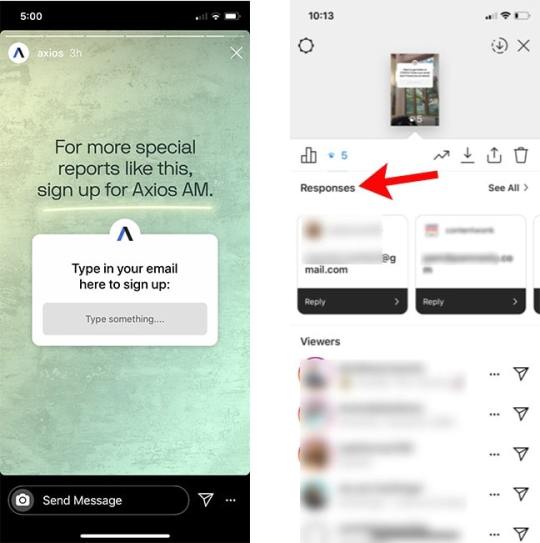
Check out these extra tips that might help you make the most of this tip:
Show users what they might get in return. Can you give them a mockup of the freebie they’ll receive in their emails?
Build up to your ask. Before you post a Question Sticker asking people to leave their emails at the door, post a series of Stories that might prime them and get them excited about your freebie.
Not getting a lot of email sign-ups? Try engaging with your ideal audiences’ accounts to get their attention and get them viewing your Stories.
3. Invest in Story Lead Ads
Unless you have at least 10,000 followers on your Instagram account, you might not have the Swipe Up Stories feature, which lets you add a link to your Instagram Stories.
And while this feature won’t be coming to all accounts that don’t hit the threshold anytime soon, Instagram has a workaround: paid Story ads.
Paid Story ads are exactly what they sound like. They’re Stories you turn into an ad that potential leads can use the Swipe Up feature and get on your desired lead generation page.

Use Story ads to get a swipe-up link that will help you generate more leads through Instagram. Be sure to link back to a landing page with your lead generation forms.
To set up paid Story ads for lead generation, it’s as simple as putting up a Facebook ad, selecting “Lead Generation” as your campaign objective, and selecting “Manual Placement.” Finally, choosing only Instagram Stories as your desired placement.
Want to make sure your Story ads get approved? Here are some tips from Facebook themselves:
Take out any edit lists or special boxes in file containers in any video ads.
Leave about 14% (250 pixels) of the top and bottom of the video free from text, logos, or other key creative elements to avoid covering them with the profile icon or call-to-action.
Recommended primary text is about 125 characters max.
Use the right CTA text. Facebook and Instagram let you choose between a few options, including “Subscribe,” “Download,” “Get Quote,” “Get Offer,” and “Book Now,” among others.
4. Launch a Contest
Really want to rake up those leads at little to no cost? A contest is probably one of your best bets.
If this is your first time putting up an Instagram Story Contest, it couldn’t be simpler.
Follow these steps to help you get started with your Instagram Story contest:
First, decide on the prize you want to give to a lucky winner or set of winners. Make sure it’s related to your brand in some way — choose either a product or service in your business or make the prizes relevant to your customers’ interests.
Write your contest mechanics. Because your goal is lead generation, encourage users to sign up with their emails on a sweepstakes type of contest, where emails will be drawn based on random lots. Promote your contest landing page on your Stories, and be sure users can easily sign up and enter the sweepstakes.
If you prefer to get users to engage during the contest, consider the following mechanics:
Ask contestants to follow your Instagram page and Like your contest post.
Ask them to tag at least 2 friends who also want to win.
Get them to share the contest posts on their Stories, together with a brand mention and your branded hashtag.
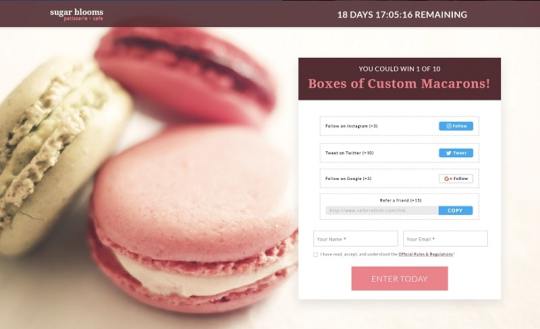
Create your branded sweepstakes contest with Wishpond’s contest tools.
5. Add a Link in Bio that Takes Users to Your Landing Page
Instagram only gives you one link that users can interact with on any of your posts, and that’s the link in your profile bio.
Many businesses on Instagram will choose to optimize their link using expanded Instagram bio link options. We see that here with Wave Apps, a financial and accounting company, where their link in bio leads to a gallery view featuring different links and even pages on their blog.

One example of optimizing your link in bio is with a link expander, like this gallery view.
This is, of course, one option. But there are many ways you can optimize this link. Instead of just leaving a link to your website or using a type of link tree with several link options, why not consider making your link in a bio take your users to a lead generation landing page straight away?
This lead generation landing page will have a compelling offer for your users, such as a link to sign up for a discount, a free ebook, or book a free call.
To convince users to follow the link in your bio, make sure your feed posts and Stories give a clear CTA. This also helps you align your content to make sure what you post is relevant to your customers.
Here are some tips for optimizing your Instagram bio landing page:
Prioritize making your landing page mobile-friendly. Because Instagram is a mobile app, you want to make sure when users click to go to your lead generation form, they’re taken to a site that is easy to navigate and interact with on their phones.
Keep your most important elements front and center. When possible, make sure your sign-up form is accessible right away when users click. If not, consider adding a button high up in your landing page that opens or takes users to the form.
Make sure your feed and Story CTAs match what users will see on your landing page. Don’t be misleading or confusing.
Use web-safe fonts. When users click links from brands’ Instagram bios, they don’t leave the app and instead are taken to an in-app window. Because of this, you don’t want your landing page to load too slowly because of fonts and elements that aren’t optimized for these kinds of features.
Avoid pop-ups wherever possible. Mobile gives you limited space to work with. Because of that, avoid elements that pop up or over on users’ screens. Your forms should be static elements on your landing page as much as possible. Avoid making them pop up in case they fail to do so.
Don’t ask for too much information. Whenever relevant, only ask for their name and email address. If your opt-in forms are too long, users are more likely to abandon your form, so don’t ask for other information like addresses or phone numbers unless you absolutely need it.
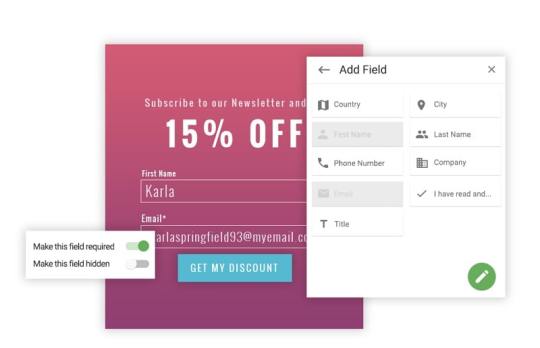

6. Tell a Story Using Videos
It’s possible your customers are spending more time watching Stories than they spend time on their home feed. This means Instagram Stories are one of the best places to engage users and keep them hooked to your content.
Tell them a story that gets them to keep watching. You might, for example, showcase some compelling before and after stories and testimonials from your previous successful customers. Or you can tell them the story of how your online business works and came to be.
Another thing you can do is to create exclusive Story-only content, like sharing tips and tricks right from your Stories. Experiment with different things that might engage users. Can you show them what a day in the life of your business looks like? Or can you tell them about what your business is currently working on just for them?
Don’t underestimate the power of a powerful story to hook users. When they’re engaged all the way to the end, that’s when you can follow them up with a call to action to sign up for something free through the link in your bio.

7. Collaborate with Influencers
Finally, here’s a great lead generation tip: collaborate with the right influencers and get in front of their audience.
Are there any thought leaders or icons in your niche that you can tap? Or perhaps there are a group of creators in your industry that could make some amazing content about your brand.
Leverage these relationships and get them to direct their users in the direction of your business. For instance, you might get creators to make branded content for you, which you can later reshare in your Stories and pin in highlights.
Yet another amazing way to leverage influencers and get leads from their audience? Partner up with them for an IG Live. Whenever you do a joint Instagram Live with anybody, both you and their followers will see that you’re Live.
Because of this, their loyal followers will tune in and discover your brand. They’re more likely to turn into hot leads if your Instagram Live is of high value and if you can follow up your Live content with a compelling freebie or offer.


Related Content
15 Instagram Hacks and Features You Didn’t Know Existed
How to Get More Real Likes on Instagram: 45 Easy & Powerful Tips
How to Market on Instagram: 30 Ideas, Tips & Examples
Here's What to Post on Instagram: 24 Top Post Ideas & Examples
20 Tactful Instagram Tips You're Missing Out On
Key Takeaways/Conclusion
Convinced that you can turn Instagram Stories into a powerful lead generation tool? You might have to test this out for yourself. Be sure to follow these top tips that help you use Instagram Stories to convert followers into leads, and see that email list and customer base grow:
Cross-post your Instagram Stories to Facebook
Create opt-in forms using the Question sticker on Stories
Invest in Story Lead Ads
Launch a Contest
Add a link in your bio that takes users to your landing page
Tell a story using videos
Collaborate with influencers
To make the most of these tips, check out Wishpond’s tools to help you create beautiful landing pages, stress-free contests, high-converting social sharing tools, and more.

Written by our guest writer Kevin Payne
Kevin Payne is a content marketing consultant that helps software companies build marketing funnels and implement content marketing campaigns to increase their inbound leads.
.flex-container { align-items: center; display: flex; flex-direction: column; justify-content: center; } @media(min-width: 768px) { .flex-container { flex-direction: row; } }
from RSSMix.com Mix ID 8230801 https://ift.tt/2YQ7pdV
via IFTTT
0 notes
Text
Allbirds IPO: Silicon Valley's Favorite Sneakers Go Public

With its shoes worn by big-name celebrities, and an estimated $1.7 billion valuation, the sustainable shoe company Allbirds is about to go public. With its recent IPO filing announcement, Allbirds has big plans to take over the sustainable footwear space.
This company sells so much more than just pairs of shoes. Allbirds is known as the official sneaker of Silicon Valley, and its position as a public benefit corporation focuses on the pursuit of environmental conservation.
Here’s everything you need to know about Allbirds before it goes public.
youtube
Allbirds Background
Allbirds Business Model
Allbirds Outlet Stores
Allbirds Valuation 2021
Is Allbirds Going Public a Good Idea?
Allbirds IPO
5 Things to Know About Allbirds Before They Go Public
Is Allbirds Really Sustainable?
Conclusion
FAQs
Allbirds Background
The story of Allbirds started back in 2016 when it was founded by ex-New Zealand soccer player Timothy Brown and his friend Joseph Zwillinger.
To put it simply, Allbirds was and is a shoe company. But at the same time, ever since its inception, Allbirds has been offering its customers something more than just shoes. The company holds the reputation for being one of the most innovative and environmentally-friendly shoe brands in the whole world. This comes down to their revolutionary idea of using wool for manufacturing sneakers that are comfortable, simple, and sustainable - all at the same time.

Source
How Was Allbirds Started?
The idea of creating shoes from wool came to Brown in 2014, who had to wear a variety of different sponsored footwear and sportswear from the big apparel companies.
“My initial insight was that footwear had become overdesigned, over-logoed, overly bright--and you're overwhelmed by the amount of choice. So the early idea was: make a very simple silhouette--the simplest sneaker that you possibly could,” he said in an interview.
Once Brown knew what he wanted to do, he immediately searched for factories and warehouses to kick off his production. He found a factory on the internet, but on his first site visit, he realized that many shoe companies used cheap materials and less than thoughtful manufacturing to cut costs.
This sparked his second insight, with Brown saying that “the innovation alarm went off. There was a huge unexplored opportunity in natural, sustainable materials starting with wool, which is abundant in New Zealand.” When he pitched his idea to the New Zealand Wool Industry. they offered him a grant to create a wool shoe to show everyone how well his idea could work.

Above: Tim Brown and Joey Zwillinger
Allbirds Official Launch and Kickstarter Campaign
It took two years for Brown to create a prototype, and in 2014, he developed the first-ever pair of wool shoes, which he released through a Kickstarter campaign.
The campaign talked about how comfortable and resilient these shoes were, and while Brown’s goal was to earn $100k at the end of the campaign, his shoes ended up making him more than $119k in only five days - showing just how much potential his idea had.
Using the funds he had raised and all the social capital he had gained through the campaign, Brown partnered up with Joey Zwillinger - a renewable materials expert - and the two officially launched Allbirds in 2016.
How Allbirds Became the Silicon Valley Sneaker
The thing about Allbirds is that it’s not just a sustainable shoe brand, it’s a seriously fashionable brand too. In fact, Allbirds is known as the official sneaker of Silicon Valley.
At the time of the launch, Brown, and Zwillinger spent a huge amount of money on their marketing and PR campaigns because they didn’t want to market their shoes as only sustainable. They wanted the world to know that the shoe they created was made to be the most premium and comfortable shoe that one could wear.
The campaigns proved to be so successful that Time Magazine even did a piece on Allbirds on the day of the launch. The article was titled ‘The World’s Most Comfortable Shoes Are Made of Super-Soft Wool,’ and it helped the brand gain even more recognition.
In the span of only a few days, celebrities like Mila Kunis and Jennifer Garner were seen wearing and endorsing Allbirds. Soon after that, the company became one of the most loved names in all of Silicon Valley. Even the New York Times published an article on how the footwear was becoming a staple for Silicon Valley - where the prevalent style was minimal chic, a category that the Allbirds fit right into.

Allbirds Business Model
In terms of their business model, Allbirds is a direct-to-consumer brand. This meant that the company hasn’t partnered up with any third-party retailers, but instead functions through its website. Customers can place their orders online which are then shipped to them directly.
This model ensures that the company gets to set its prices and direct its profits instead of relying on external retailers. Allbirds have more control over their sales, and their business model cuts out the middle man, which leaves more room for profit.
With eCommerce becoming so popular during the Covid 19 pandemic, the company has been seeing a huge rise in online sales.

How Does Allbirds Make Money?
Being a direct-to-consumer brand, nearly 90% of Allbirds’ revenue comes from online sales. Thanks to the skyrocketing online shopping space during the Covid 19 pandemic, Allbirds’ digital sales reached a whopping $194.6 million in 2020.
Approximately 53% of the company’s digital sales in 2020 were from repeat customers. And according to the company’s SEC-1 filing, the average lifetime spend for an Allbirds US customer is $446.
The 5 Core Pillars of the Allbirds Business Strategy
Allbirds focuses on the demand for sustainable and long-lasting footwear and apparel. According to Allbirds, the companies strategy covers 5 core pillars. These are:
To make the world’s most comfortable footwear and apparel, powered by leading sustainable materials, innovation, and design
To build a brand with a large and loyal community of customers that love the products
To continually inspire this community to keep coming back and advocating for the brand
To use a digitally-enabled and seamless cross-channel experience to serve this community
Deliver the highest-quality products on time at a great value to customers through a low-carbon, technology-enabled, consumer-focused supply chain

Allbirds Marketing Campaigns
After gaining initial success through its PR campaigns, Allbirds established a prominent social media presence, further driving their sales. The company hired Social Media Ambassadors to promote their products through platforms like TikTok, Instagram, and Twitter. This got everyone talking about Allbirds and how they were the revolution that the footwear industry needed.
Allbirds took maximum advantage of their social media sites to connect with their fans and listen to their feedback. Unlike their big-shot competitors, Allbirds was a small company. Which meant that they had the time and resources to dedicate towards customer service and satisfaction - and that proved to be a game-changing move.
Allbirds targets Gen Z and millennial customers through its initiative focused on environmentalism, health, and wellness. These are big topics of interest for these target audiences. Allbirds has capitalized on the complete minimal and casual appeal of its footwear.
@weareallbirds
Turning natural into supernatural. #weareallbirds #foryoupage #fypシ
♬ original sound - Allbirds
Allbirds Outlet Stores
After experiencing all of this success, Allbirds transitioned into outlet stores, opening 27 stores in eight countries as of 2021. However, their digital channel still represents 89% of the sales - showing that their initial business model is still successful today.
The company also plans to expand its stores to 36 outlets by the end of 2021, which experts believe will be a winning move considering that people are once again returning to the world of physical shopping after more than a year.

Source
Allbirds Valuation 2021
Today, Allbirds is one of the most valuable footwear companies globally, with an estimated net worth of $1.7 billion. Because of the company’s quick success, Allbirds has received at least $204 million in equity investments from big-name investors.
The company’s revenue in 2020 was $219.3 million, up from $193.7 million the year before. Digital revenue was $194.6 million in 2020. About 53% of 2020 sales were from repeat customers - all of which are great numbers for a business that’s only starting in the market.
However, at the same time, Allbirds’ losses also grew to $23.6 million from $14.6 million in 2020. For the first six months of 2021, the company had a net loss of $21.1 million, compared to the $9.5 million posted in the same period a year earlier.
Allbirds Investors
Because of the company’s quick success, Allbirds has received at least $204 million in equity investments from some well-known investors.
The Allbirds investors include Maveron, Tiger Global Management, T.Rowe Price Funds, Fidelity, Franklin Templeton, and Lerer Hippeau Ventures. This proves that the company is backed by big names that believe in its growth potential even in a market as saturated as footwear.
Is Allbirds Going Public a Good Idea?
Despite Allbirds’ growth in losses, the company has grand ambitions to go public very soon. But is this such a great idea?
The apparel and shoe sales market is pretty hot right now, totaling $1.8 trillion for 2020. Across the board, major retailers and footwear brands have posted about their sales increasing, highlighting the fact that the fashion industry has recovered pretty well after the pandemic.
According to Matt Powell, senior sports industry advisor for the NPD Group, investors are looking for companies with strong growth potential, companies that bring something new to the table. The footwear business is going strong right now, and because Allbirds has an approach unlike any other player in the game, going public might work out pretty well for the company.
Allbirds IPO
Allbirds has filed for an initial public offering, and plans to list on the Nasdaq under the ticker “BIRD”. The company will have Class A and Class B shares.
There is currently a team of 17 banks working on the deal, including Morgan Stanley, JPMorgan, and BofA Securities - the lead underwriters.
Allbirds has set a target to raise $100 million from the IPO, but the figures might shift slightly when the time comes.
All the proceeds from the offering are expected to be used for its growth, which involves acquiring businesses, products, and services in line with their ‘green mission,’ motivating people to invest in the brand on an individual and institutional level.

Why is There so Much Hype Around This IPO?
Allbirds has described this event as being “the first sustainable public equity offering”. As a public benefit corporation, Allbirds claims that not all of its decisions will maximize shareholder value.
The company plans to stick to its sustainability mission, and focus on its environmental goals. However, Allbirds has still managed to remain on a high growth path which doesn’t seem to be slowing down anytime soon.
This is what’s really interesting about their IPO. The company shows high growth potential, it’s got a clear environmental cause, but it also hasn’t seen any profits - with losses steadily growing.
Other IPOs Running at a Loss
The Allbirds IPO seems to be part of a direct-to-consumer trend that we’re seeing. Allbirds isn’t the only company going public without seeing any profits.
Warby Parker, another D2C company, recently filed for an IPO. In 2020, the company reported a net loss of $26 million. Casper, another public D2C, reported a 2020 net loss of $89 million.
It’s interesting to note that Warby Parker, Casper, and Allbirds all have plans to expand their physical locations. We’ve got to wonder what kind of effect this might have on their financials.

5 Things to Know About Allbirds Before They Go Public
With the company’s IPO close up on the horizon, here are 5 things you should know about Allbirds before they hit Wall Street and become public.
1. The Losses Could Continue
With Allbirds’ growth plans come higher operating expenses. This could mean continued losses for the company. And because Allbirds is so heavily focused on sustainability throughout the supply chain, the costs of producing footwear and apparel will increase.
Allbirds has stated that it needs to increase and sustain revenue levels if it wants to achieve a profitable status, which will be difficult to maintain.
2. Climate Change Could Affect the Business
Even though Allbirds’ entire supply chain and ethos are designed to address climate change, climate change could have a drastic effect on the company.
Climate change will result in increased prices for materials, commodities, and manufacturing. This will drive up the price of the Allbirds supply chain, and lower the potential output of the business. For a company with a clear sustainability plan in place, climate change could seriously disrupt its operations.
3. Physical Stores Will Increase
Allbirds has identified hundreds of potential locations for new stores - something that the company plans to grow. On top of its current 27 stores, Allbirds is also looking to grow internationally. International sales have already been on the rise for this company.
4. Supply Chain Issues Could Become a Problem
Allbirds uses various raw materials in its manufacturing process, with most suppliers being outside of the US. There are various risks related to its suppliers and raw material prices. As markets and commodities fluctuate, and international trade issues arise, Allbirds could be affected.
5. The Returns Policy Could be Affecting Revenue
Allbirds offers a 30-day return policy for a full refund or exchange. This is unusual for footwear, and it could be squeezing the company’s revenue.
The company prospectus states: “Our revenue is reported net of returns, discounts, and any taxes collected from customers and remitted to government authorities”.
“The introduction of new products, changes in customer confidence or shopping habits or other competitive and general economic conditions could cause actual returns to exceed our estimates.”
Is Allbirds Really Sustainable?
One question on many people’s minds is whether Allbirds is truly sustainable, or whether they’re just more sustainable than the competition?
Allbirds claims that its supply chain has been carbon neutral since 2019, and the company estimates that its sneakers’ carbon footprint is 30% less than a regular pair.
However, Allbirds has also been facing a class-action lawsuit for making misleading sustainability claims. Basically, consumers are suing the brand for claiming its marketing messages exaggerate the actual sustainability of the product.
Certain critics say that Allbirds should go truly sustainable if they want to live up to the reputation they’re marketing. This would involve a circular supply chain, and not relying on new product creation.
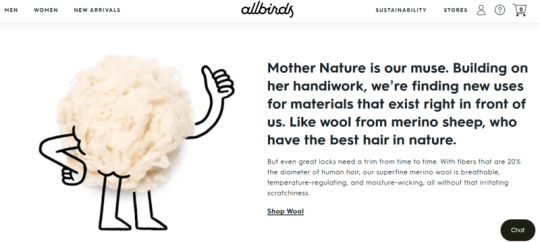
Conclusion
Considering all of this, Allbirds can very well make history with its IPO soon. And while it’s true that the company is dealing with its fair share of losses during the process, the fact that Allbirds has established itself as a billion-dollar enterprise in less than a decade is all the reason to believe that the brand will successfully go on with its domination of the footwear industry.
Allbirds doesn’t just sell pairs of shoes, its mission is environmentally charged. Their IPO as a public benefit corporation represents more than just a big business, they also want to create a social and environmental impact.
What do you think about Allbirds? Do you think they have what it takes to disrupt the apparel and footwear industry? Let us know in the comments below.

FAQs
Did Allbirds go public?
Allbirds has submitted its listing documents to the US Securities and Exchange Commission and is looking to go public as soon as September.
Who owns Allbirds?
Allbirds was founded by Timothy Brown and Joseph Zwillinger who currently own the company. Various venture capitalist investors are named as directors that own shares of the business. The Allbirds IPO is expected to release in September.
Is Allbirds profitable?
Allbirds has not yet recorded a profitable year. The company’s net losses grew to $25.9 million in 2020. However, the company did report a 25% spike in net revenue (compared to the previous year) in the first half of 2021.
How to trade Allbirds?
When Allbirds lists, you can trade it the same way as any other share available on the market. Allbirds will be listed on the Nasdaq under the ticker “BIRD”.

Related Content
Why Did MailChimp Sell to Intuit for $12B?
How The Rock Created a Record Selling Tequila Brand
Why Did Hubspot Buy The Hustle (And What Can We Learn From This?)
How Instacart Became a Billion-Dollar Business
How Marie Kondo Built Her Million-Dollar Empire
OnlyFans Uncovered: Valuation and Business Model Explained
13 Family-Owned Businesses That Went Global
7 Disruptive Marketing Tips to Win Over More Customers
from RSSMix.com Mix ID 8230801 https://ift.tt/3AMicCt
via IFTTT
0 notes
Text
5 Ways to Grow Your Mailing List with a Virtual Event

Growing your mailing list is a balancing act of quantity and quality. Having an email list of 100,000 people who don’t respond to your brand is unhelpful to the point of being counterproductive - it simply becomes expensive to maintain.
On the flip side, having a tiny group of activated people in your mailing list doesn’t always help you scale what you want to achieve.
A good mailing list is made up of an active but scalable audience.
And what's a great way to attract an active but scalable audience? Well, okay, the title was a bit of a giveaway, but you’ve got it! Virtual events.
Virtual events are one of the most efficient ways to capture email addresses and activate your audience. HeySummit sees an average of 2643 attendees per event - that’s a lot of email addresses!
Even beyond this, virtual events are a highly effective means of cross-pollination and a fantastic way to repurpose content. Most importantly, virtual events demonstrate your value through the power of experience.

Here are 5 ways to grow your mailing list with a virtual event:
1. Know Your Why

Know why you want to grow your list.
Now we’re not trying to be abstract or philosophical here, but knowing why you want to grow your email list is absolutely crucial to your marketing strategy. Ask yourself:
Do I want to spread knowledge?
Am I trying to sell a product?
Do I want to grow and activate a community?
Is my ego a motivator?
Am I aiming to establish myself as a leader in my field?
If you’re uncertain why you want to grow your email list, you’re going to have a pretty tough time trying. Simple as that. Knowing your ‘why’ is fundamental to communicating clearly and effectively with both your attendees and speakers.
Write down at least three reasons you want to grow your email list and use this to guide your strategy.
If ego is a motivator, for example, embrace it! Thought leadership is a prevalent and valid reason to want to grow your email list. Focus on networking and aligning yourself with experts in your field. Entrepreneurial coach Doc Williams recruits his clients as speakers on topics such as How to Brand Yourself as an Influencer. A firm believer in letting his work speak for itself, Doc’s virtual events establish social proof and thought leadership.

2. Build an Attendee Persona

Treat your event, even if it’s free, just like a product. This will hone in your focus for growing your mailing list. Like any product, your event needs a customer persona. Or, in this case, an attendee persona.
An attendee persona is a very detailed profile of the type of person you’re trying to reach. When you know your attendee, you know what’s going to make them sign up.
What does your typical attendee look like?
How old are they?
What are they interested in?
What are their pain points?
What was their favorite song at high school?
The more detailed, the better.
For example, Siobhan Farr’s Digital Nomads Beyond 50 2021 summit was built on a clear attendee persona. This persona includes but is not limited to:
An aspiring digital nomad in their late 40s and beyond
Based in the United States
Without children or with children who have flown the nest
Now considering retirement due to COVID -19
Their concerns include: understanding how to pay tax whilst traveling, generating new income streams, being a good guest in a foreign country, etc.
Siobhan sought speakers to address these pain points to capture and maintain attendee attention. Over 130 people signed up to Siobhan’s summit, bumping her Digital Nomads Beyond 50 Network Facebook group to 388 members.

Just as it is essential to know who your event is for, you need to be equally as clear with yourself as to who it is not for. For example, Siobhan’s summits are not for people under 47 years old or those unable to work remotely. If you can’t think of anyone that your event isn’t for, it’s far too broad.
When was the last time you signed up for something you’re vaguely familiar with? Your sign-ups will be from people who see your event as something that directly speaks to them. Don’t underestimate the power of your attendee persona - it will guide everything you do.
3. Find Your Niche
Once you’ve narrowed your focus to your attendee persona, narrow it even further to one of their problems.
We’re serious - you need a microscope on this thing. You’ve heard the saying, “If you try to please everyone, you’ll please no one.” Well, the same applies to your attendee’s problems. If you try to solve all your attendee’s problems, you won’t end up solving any of them.
When creating your event, start with the problem. Whatever you do, don’t start with a solution and go about finding a problem to attach to it haphazardly. It sounds simple, but it’s frustratingly easy to get it upside down. Fall in love with the problem.
There may be loads of problems you’re absolutely smitten with. That’s great! In time, you’ll address those too. Just make sure to establish your credibility with one problem first before moving on to the next. The other problems won’t get jealous, we promise.
Writing coach Daniel Wallace’s first summit, Escape the Plot Forest, really honed in on a niche. Created for aspiring fiction authors, it focused on one aspect of writing: plot.

Escape the Plot Forest attracted over 3000 attendees, netting over $26,000 in revenue. Not only did Daniel get a lot more sign-ups than he was expecting, but he also grew and activated his online community. Trust us, finding your niche works.
4. Cross-Pollinate with Your Speakers
Virtual events are strong sources of cross-pollination.
Cross-pollination occurs when individuals or companies combine their talents to extend their reach. When you invite speakers to your event, they get access to your audience. And guess what? You get access to theirs!
Having your speaker’s audience sign up for your event is a fantastic way to capture email addresses. If you have several speakers - that’s more email addresses!
It can be uncomfortable asking your speakers to promote your event. We know this is easier said than done but push through this. It’ll be worth it.
When you invite speakers to your event, you’re giving them the opportunity to grow their own list as well. Be upfront with your speakers with how you expect them to share your event with their audience. If some people aren’t comfortable with that, c’est la vie! You’ll find another speaker who is.
At the same time, make it as easy as possible for speakers to share your event. Ask them what their outreach strategy is and what you can do to help them with it. Provide them with copy, prompts, whatever they need.
Product-Led Growth Pioneer Wes Bush cross-pollinates in quarterly ProductLed virtual events. His speakers are people his attendees recognize as strong players in the product-led space. Bringing together so many experts is fantastic for attracting new leads, growing Wes’s email list, and in turn providing great promo for his book, Product-Led Growth: How To Build a Product That Sells.

Cross-pollination is one of the most efficient ways to grow your list - take advantage!
5. Maximise Your Content
Evergreen Summits
Collecting event sign-ups before launch day is not the only opportunity you have in your event marketing strategy to grow your list.
Your event is not a single moment. You have its build-up, the event itself, and the aftercare. Growing your mailing list is as much about nurture as it is capture. Don’t forget about your new sign-ups once the event is over - give them a reason to stay.
Most of the events run on HeySummit are ‘Evergreens’ - they’re left open once they’re over. They’re great for SEO _and _for people to discover your event after the fact.
The Worlds of Learning summit for course creators and entrepreneurs is a great example of an open event. Since its March 2021 launch, all-access passes and replays to specific talks remain available. Record your event, keep it open, and don’t take away any future opportunities to grow your list.

Repurpose
Events give you _so _much content. Repurpose it! If your event had 30 talks, for example, that’s 30 podcast episodes, 30 blog posts, and 30 social media campaigns, all with their own call-to-action to join your mailing list. The more events, the more content you provide, and the easier it is to grow your list.
Your event shouldn’t be an isolated one-off. Make it work with your marketing flow. If you’re a podcaster and you’re using events to capture leads, talk about your events on your podcast and talk about your podcast at your events. This way, you’re giving people several reasons to sign up across channels.
Related Content
How to Organize a Live Summit: 11 Tips
12 Best Email Marketing Tips for Entrepreneurs
5-Step Guide To Mastering Your Paid Search Keyword Strategy
3 Critical Ways to Build Your Blog and Newsletter Audience
What is a Landing Page?

The Rundown
The best way to build a list is to have people believe in the value you’re providing. Hosting a virtual event is one of the best ways to demonstrate your value. When done well, virtual events show your audience that not only do you know your value, and you know them. Hone in your focus and:
Know Your Why
Build Your Attendee Persona
Find Your Niche
Cross-Pollinate with Your Speakers
Maximise Your Content
Go on - get on that (virtual) stage!

Written by our guest writer Rob Gelb, Founder and CEO of HeySummit
He loves tech, cool projects, and cheer-leading awesome people.
.flex-container { align-items: center; display: flex; flex-direction: column; justify-content: center; } @media(min-width: 768px) { .flex-container { flex-direction: row; } }
from RSSMix.com Mix ID 8230801 https://ift.tt/3DBvfIR
via IFTTT
0 notes
Text
How to Double Your Sales With Social Commerce

Online shopping is no longer just limited to e-commerce websites, it’s taking over social media too.
As consumers spend more time engaging with social media, businesses are using social media platforms to drive up their sales. This year alone, social commerce sales are expected to increase by 35.8%, making this an area your e-commerce business needs to be focusing on.
With social media becoming such a popular place for people to shop, it makes sense that businesses should be focusing more time and effort on creating a powerful social commerce strategy.
Follow our guide to help your e-commerce business make the most of social commerce.
1. What is Social Commerce
2. Social Commerce vs. eCommerce
3. The Different Social Commerce Platforms (And How to Use Them)
4. How to Boost Your Social COmmerce Strategy: 10 Tips
5. Conclusion
What is Social Commerce?
Social commerce is when you sell products directly through a social media platform. Instead of just finding brands or products on social media, social commerce allows users to complete the entire sale without moving on to another website.
Social commerce is all about streamlining the buying process, and closely connecting marketing with online shopping. It’s an area that is steadily increasing in popularity, and it’s starting to leave a major impact on the online shopping industry as a whole.
More and more social media platforms are adopting social commerce and enhancing their social commerce capabilities. Social commerce is currently an $89.4 billion market right now, and this is only growing at a rapid rate. Soon, social commerce will likely form a major part of any online retailer’s operations.

Source
Social Commerce vs. eCommerce
Ecommerce is a more broad term, and it refers to any kind of buying or selling that takes place online. Social commerce is a form of eCommerce, and it’s a model that further refines and optimizes the buying journey for social media users.
This is mainly achieved through streamlining the checkout process for mobile users. Most eCommerce traffic comes from mobile phones. Mobile users also have a much higher cart abandonment rate than desktop users. Shoppers with smaller screens need to have a simplified checkout process, which is something that social commerce can provide.
The social commerce shopping experience is way faster and easier than traditional eCommerce. Users can scroll through Instagram, find a product they like, and buy it right there and then. No need to leave the app. This type of social shopping is a highly effective way to increase sales and avoid abandoned transactions.
The Different Social Commerce Platforms (And How to Use Them)
When creating your social commerce strategy, there are six main platforms to consider. We’ll explore them and their social commerce abilities below.
Facebook
Facebook is the leading social commerce platform thanks to its easily accessible Facebook Shops tool. Anyone with a business profile can set up a Facebook Shop for free, which is connected to your eCommerce product range. You can either do this automatically through your eCommerce platform, or you can upload it through a spreadsheet.
Facebook’s social commerce solution allows buyers and sellers to easily communicate via Messenger. This can be a great way for your brand to connect and engage with its audience.
Facebook is also a good platform for shoppers to organically find products that match their interests. Organic discovery works well through the mobile app, and users can complete their transaction from discovery to purchase all within the same app.

Source
Instagram
Instagram Shopping allows eCommerce store owners to sell their products directly on the platform. Your Instagram Shop is just like your usual online storefront. All you will need is a business/creator account and an online store to set this up. Once your Instagram Shop is live, shoppers can browse and buy your products without leaving Instagram.
Your Instagram Shop can be easily customized with different themes, collections, and curated products. This could include things like bestsellers, seasonal trends, and new arrivals.
With your Instagram Shop, you could either send shoppers to your eCommerce website, or they could use Instagram checkout to purchase products directly. When shoppers make a purchase through Instagram Checkout, a small fee is charged. Otherwise, setting up an Instagram Shop is completely free.
When setting up your Instagram Shop, you can set up product pages just like you would on your online store. These product listings include things like your product description, prices, and product information.
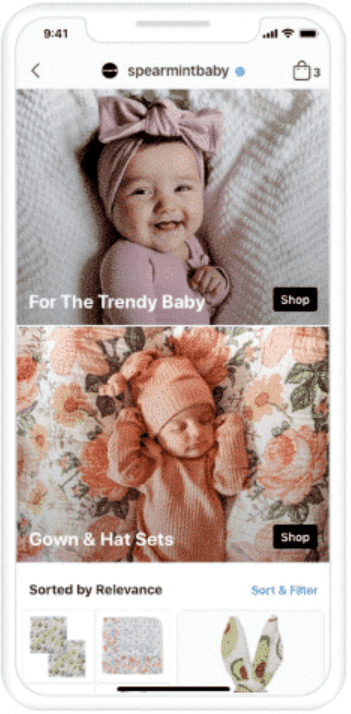
Instagram Shopping Features
Here are some of the features and different ways to use Instagram Shopping:
Shoppable Posts: You can integrate your store with Instagram product tags. Tag products in your posts just like you would tag people, and when users tap the product tag, they will be sent to the relevant product page.
Shoppable Stories: Just like shoppable posts, you can also use product tags in your stories to send more traffic to your store.
Shoppable Ads: Product tags can also be used in Instagram ads if you want to get your products out to a wider audience. You can set this up in the Ads Manager, or boost shoppable posts.
Live Shopping: This can be a great way to launch new products and promote sales of a specific product in real-time. You can incorporate your product tags into your live stream, where users are sent to your store from your broadcast.
Shopping Tab: The Instagram Shopping Tab is an excellent way to get your products and brand out to new customers. Users can discover relevant products and brands through this tab, where yours could be included to boost your visibility to new customers.

Pinterest
Pinterest has become a popular platform for selling online. In fact, 89% of Pinterest users are on the platform to find purchase inspiration.
Pinterest is not necessarily a social commerce platform in the sense that you can’t complete transactions directly on pins. Instead, users are redirected to a landing page based on the product where they can complete their transactions.
Pinterest social commerce is done through the use of Shoppable Pins. These pins are directly linked to your eCommerce products, and users can just tap on your product image and be directed to a product purchase page.
The visual appeal of Pinterest makes it a great place for brands to show off their products online and attract new customers. Pinterest also has a link to Etsy, which can make it easier to use the social media platform to boost your Etsy store sales.
Follow this guide for a more complete understanding of how to use Pinterest for eCommerce.

Source
TikTok
TikTok is the most recent social commerce platform, offering a partnership with Shopify. This new partnership marks the introduction of organic product discovery and shopping tabs to TikTok.
This is still a new social commerce pilot that is currently only available for Shopify merchants in the US and UK. The feature does have plans for expansion though, with the goal of making TikTok a hub for social media eCommerce.
Being one of the fastest-growing social media platforms, TikTok is definitely a place to look towards for social media marketing. With its new social commerce feature, the potential to reach a large new audience of customers is huge.
Follow this guide for a more complete understanding of how to use TikTok for eCommerce.

Source
Snapchat
Brands on Snapchat with a public profile can set up a store and display a variety of products. The Snapchat shopping experience is smooth, and if your audience uses this platform, it could be a great place to sell your products.
Snapscan has also recently launched a clever new Screenshop feature. This allows users to scan their friends’ clothing on the app, or scan photos that they upload, and then shop for similar items on the platform.
The future of Snapchat’s social commerce is also looking exciting. With the rise and development of augmented reality, this social media platform could soon be using AR for a very exciting shopping experience.

Source
Twitter
Twitter Shopping has just been launched as a pilot to let US users shop from their profiles. Twitter is starting to test out eCommerce on the platform, which could be a major breakthrough for this social media giant.
Twitter shopping is done through a new “Shop" module where brands and retailers can showcase their products on their Twitter profiles. Users can tap products, and this will open the business’s website inside the Twitter app. Shopping will only be available for those with a Professional Profile.
The feature is still in its testing phase, but it looks like it will offer some exciting new prospects for Twitter.
Watch this space!

How to Boost Your Social Commerce Strategy: 10 Tips
Selling products through social media is an excellent way for brands to reach a wider customer audience, and make more sales through an easier shopping experience. Here are some important things to keep in mind in order to maximize your social commerce strategy.
1. Know Your Customers
The only way to implement a successful social commerce operation is to have a deep understanding of your customers. Know your customer demographics, their online behavior, and what triggers them to make a purchase.
By understanding your audience, you will be able to do things like focus on the most appropriate social media channel, target product ads to the right audience, and optimize your listings to match your buyer’s intent.
2. Focus On the Right Social Media Channel
Knowing which social media channels your consumers spend the most time on is important. There’s no use putting all of your effort towards TikTok social commerce if your consumers are shopping on Pinterest.
You can use Google Analytics to understand which social media channels send the most traffic to your online store. These are probably the channels that you want to focus on.
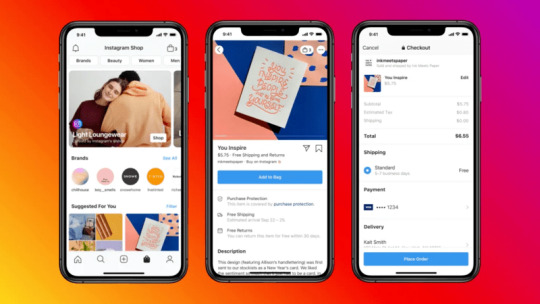
3. Focus On Customer Service
Don’t forget about the ‘social’ part of social commerce. Customers today expect to engage with brands through social media. Your social media channels should be used to offer a customer service experience as well as a shopping experience.
Unlike your online store, you can use your social media channels to respond to comments and questions, talk to customers, and build a community. Consumers want to see this engagement on your social platforms, which can be a big deciding factor for whether they make a purchase or not.
4. Leverage User-Generated Content
Social proof is a major factor in eCommerce marketing. One of the best ways to leverage social proof is to encourage and share user-generated content (UGC). Potential customers will see other customers talking about your brand on your social channels, which helps to build trust and influence a purchase.
User-generated content is important for social media marketing, but when you’re utilizing social shopping it becomes even more important. UGC highlights the customer experience, it shows your products in the real world, and it adds trust to the customer journey.
Whenever someone mentions your brand positively on social media, share this in your stories. You can also take advantage of influencer marketing or brand ambassadors to generate UGC for you.
Another excellent strategy for increasing your UGC on social media is to run a giveaway. You can ask contestants to perform a certain action (like upload a photo with your product) for a chance to win. This can get you loads of social proof to help boost your sales. With a social contest app like Wishpond, running a contest is easy.

5. Post Great Social Media Content
While the strength of your e-commerce store comes down to your products, your social commerce success is based on the strength of your social media content. Basically, you need to post great content if you want to attract and maintain an audience of consumers.
To do this, you’ll need to post high-quality images and videos on your channels that add value to your followers. Offer interesting insights into your products, helpful tips, and entertaining content. Your aim is to build an engaged following who are interested in your brand throughout their buying experience.
@vessi
#duet with @josephtburke Next dance video in Vessi’s? ??? #nomorewetsocks #vessigiveaway #freeshoes #fyp
♬ Skippin Mario - JIGGYnJIROH
6. Use Influencers
Successful social commerce combines marketing with shopping. A great marketing strategy to get you more visibility, and more sales, is to make use of influencers. Influencer marketing is huge, and the right influencer can help you to reach a much bigger audience.
For an influencer marketing strategy that works, you’ll need to work with the right influencer. This needs to be someone that appeals to your target customers and has a good level of engagement.
When you find the right influencer, develop a strategy around which products they will promote through paid posts. Their audience will see your product, tap on it, and be directed straight to your social commerce store.

7. Always Optimize Your Shopping Experiences
Social commerce is an area that’s rapidly developing, with new platforms emerging and offering new features all the time. Your customers’ behavior is also always evolving, and it’s important that you keep up with this.
Just because certain shopping experiences and platforms have worked in the past, it doesn’t mean they will continue to be the best option for your brand. Make use of all of the data that you have available, and use this to optimize your social commerce strategy.
Understand what channels are performing best, how your customers’ behavior might be shifting, and what pain points consumers have. Always optimize and update your social commerce operation to match this.
8. Encourage Reviews
Positive reviews are crucial for encouraging sales. In fact, 93% of online shoppers base their buying decision on reviews. The more positive reviews you get, the better. Share these reviews on your social channels, and make them clear to any potential customers.
You can gather reviews by sending out an automated email politely asking customers to leave a review. You could even use your contest as an incentive to generate more reviews.

9. Listen to Your Audience
Social media gives you a direct view of what your customers are saying about your brand. Businesses should use social commerce to listen strategically to their audience, monitor comments, and keep up with industry trends.
Social listening is an important aspect of social commerce. When you get this right, it can make a big difference to the way your audience perceives your brand. Of course, this will help you ramp up your sales.
10. Keep Your Prices Strategic
While social media is an excellent place to sell all kinds of products, high-end products generally don’t perform as well as products priced to move quickly. The buying journey is faster and more efficient, but this also means consumers spend less time doing product research. This means expensive splurges are not as common on social media.
Products under $70 tend to perform best on social media. Anything more expensive, and the ‘risk’ of buying these products become too high.

Source
Conclusion
Social commerce could well be the future of online shopping. It’s a rapidly advancing area that offers a lot of potential for optimizing the buying journey and enhancing the consumer experience online. If your online store isn’t making the most of social media, then it’s certainly time to start.

Related Content
5 Must-Have Features and Tools for Successful Social Commerce
8 Actionable Tips to Use Social Media for eCommerce Sales
Ecommerce Social Media Marketing: Building Trust and Engagement
How to Use TikTok for eCommerce Marketing
Using Pinterest for eCommerce
How the Instagram Algorithm Works in 2021
from RSSMix.com Mix ID 8230801 https://ift.tt/3BCd5pJ
via IFTTT
0 notes
Text
Facebook Advertising Costs: CPC, CPM, CPA & CPE Guide

How much does it cost to advertise on Facebook?
How much should I spend on CPC Facebook Ads?
These are the two questions that I hear the most when I talk to marketers who are thinking about running their first Facebook Ad campaign. And so it should be. Marketers need to be able to estimate their ROI above anything else.
Here’s the answer: Spend less on each customer you get through Facebook Ads than they are worth to you.
But how do you know much an average customer is worth? And how do you know if you’re spending less than that on your Facebook Ads?
Let me explain.

Facebook Advertising Costs Principle #1: CPC, CPM, CPE, CPA & Cost-Per-Customer of Your Target Audience
Ok, first, let’s take a look at how Facebook charges you to advertise on their platform and the factors that affect how much your Facebook Ads cost.
CPC, CPM, CPE & CPA Explained
When you set up your Facebook campaign budget, you need to choose between two to four pricing options.
In order to understand the cost of Facebook Ads, and how these Facebook Ads costs work, you need to understand the different factors that you pay for in your campaigns. These are:
CPC (cost-per-click): If you use cost-per-click (CPC) pricing, you only pay when someone clicks on your Facebook Ad. Basically, with cost-per-click, you set a budget, and each time someone clicks on your ad, you pay the specific cost-per-click.
CPM (cost-per-mille): With cost-per-impression (CPM), you pay when Facebook shows your ad 1000 times. Impressions are the number of times your ad is shown to a user on Facebook. This means your Facebook ad spend is based on the number of times someone sees your Facebook ad and not the number of clicks on that Facebook ad.
CPA (cost-per-action): This allows you to track and optimize how much you spend to get someone to take an action (or convert) on your website after clicking your ad. CPA on Facebook ads is more specific, and it gives you a better overview of how well your Facebook ads are performing in terms of creating customers.
CPE (cost-per-engagement): This allows you to track and optimize how much you spend to get someone to engage with your Facebook Page after clicking your ad. In 2021, the average CPE is $0.11. Learn more about how to increase Facebook Likes using Facebook Ads.
Calculating your Cost-Per-Customer
Cost-Per-Customer is the one number you need to watch. This is the cost of getting one person to buy from you from your Facebook ad. All of the other cost numbers are just parts of the equation for calculating your final cost of getting one new customer.
Here’s how to calculate it:
Using Facebook’s built-in CPA tracking, we can first get the cost of the initial action the user takes on our website. If that action is to make a purchase, then your CPA is equal to your Cost-Per-Customer. But if your action is to download an ebook, sign up for a newsletter, or some other form of lead generation, then you need to add one extra variable to the equation:
CPA x (Number of Leads that Buy / Total Number of Leads)
What is the Average CPC?
In 2021, the average CPC across campaign objectives and industries is $0.97. If you break the Facebook ads average CPC down into campaign objectives, the CPC average ranges from $0.25 to $3.30.

Source
What is the Average CPM?
Right now, the average CPM for a Facebook Ad campaign across all industries is $11.54. If you break down the Facebook Ads CPM by campaign, the averages range from $2.00 to $30.97.

Source
CPC vs CPM Facebook: Which One to Choose?
The default pricing option that Facebook sets for your ad is a cost-per-click (CPC) bid. This is a good option for when you’re first starting out, as the click-through rate (CTR) for Facebook Ads is lower and paying for clicks is ultimately cheaper than if you were to pay for the same number of impressions (CPM).
Depending on your ad’s performance, you may want to switch your Facebook bid from cost-per-click (CPC) to CPM - especially if it’s doing well with a high click-through rate. But be sure to monitor impressions and clicks. If impressions on your ad increase and clicks decrease, your cost will increase and you may need to switch back to cost-per-click (CPC) pricing.
After choosing your payment method, you can choose to set your own bid or allow Facebook to optimize your bid for you. Unless you’re an advanced user, we recommend allowing Facebook to optimize your bid.

Choosing a Target Audience for Your Ads
Your Target Audience is the group of Facebook users who will potentially see your ad. Facebook has a very deep knowledge of users’ demographics, employment, and interest information for very precise targeting. His accurate targeting of your exact audience is a major advantage to running Facebook Ad campaigns.
Want to target 45-year old women in Kansas City who like cats? No problem! You can even target specific individuals with your Facebook Ads using only their email address or phone number. This is called “Custom Audience” targeting. Learn how to target Facebook Ads based on their email address and phone number (custom audience) here.
If you’re interested in learning how to create a target audience, check out this helpful guide.
Why Some Target Audiences Have Higher CPM and CPC
In a nutshell, the more advertisers there are for a particular target audience, the higher the cost will be to advertise to them - basic supply and demand.
If you’ve ever run Google Ads, you’ve experienced the same thing. The more people try to advertise for a particular search keyword, the more it costs to advertise for it. This is because people bid on the Facebook CPC to make sure that their ad gets more visibility. With a larger ad spend, you’ll be able to reach more people.
What Influences the Cost of Facebook Ads?
There is a number of variables that influence the cost of Facebook ads. It’s important to understand these variables before running your next campaign.
Campaign objectives: Facebook campaign objectives make a big difference to the price of ads. For example, brand awareness or engagement campaigns cost less than conversion campaigns at the lower end of the funnel.
Audience size: If you target larger audiences you’ll generally pay less than ads targeting smaller audiences.
Daily budget: If your daily budget is too low, it will take Facebook longer to end the learning phase. Basically, ads that have better engagement rates are rewarded with lower costs in the long run.
Click-through rate: The higher the click-through rate, the lower the cost per click will be.
Seasonality: As the holiday eCommerce season takes place, the cost for advertising sees a gradual rise. Generally, Q1 and Q2 are cheaper periods to run ads, while the latter parts of Q3 and Q4 see ad prices increase.
Facebook Advertising Costs Principle #2: Your Average Value Per Customer
Now that you understand how Facebook Ads are priced, you need to look at the other side of the equation, which is how to calculate how much value (revenue) your ads generate for you.
The best way to do this is to calculate your average value per customer, so you can easily match up against the Cost-Per-Customer that we calculated above.
Calculating your Average Value Per Customer (AVC)
AVC is the average order amount of each customer.
If you have a one-time payment business model, meaning someone pays you a one-time fee for each product or service, this is the equation you use to calculate the average order amount:
Total Sales Revenue / Number of Customers
Now, if you’re a larger business and have multiple product categories, you may need to create segments based on those categories. For example, the average order amount of electronics will be much higher than that of cleaning supplies.
Calculating AVC for Recurring Revenue Models
If you have a recurring revenue model, meaning people pay you on a weekly/monthly basis for a product or service, this is the equation you use to calculate the average order amount:
(Total number of recurring payments/number of customers) x ((Recurring Payment Price #1 x Number of Customers Paying this Price) + (Recurring Payment Price #2 x Number of Customers Paying this Price) + … / Total Number of Customers)
In the next section, I’ll show you the one number you need to watch to know if your Facebook Ads are successful or not.
Facebook Advertising Costs Principle #3: Optimizing Your Ad Spend (Budget)
So, now that you know how to analyze your Facebook Ads to make sure they are making you more money than you are spending on them (a.k.a. profitable), how much do you spend each week/month on Facebook Ads? And how do you optimize your Facebook Ads to make them as profitable as possible?
Understanding Return On Ad Spend (ROAS)
The one number that you need to be focused on at all times is your average-value-per-customer minus Cost-Per-Customer. This is, how much money your average customer brings you minus the amount you need to spend on ads to get one customer. This is referred to as your return on ad spend (ROAS).
If this number is above zero then your ads are profitable. And the higher the number, the more profitable they are.
At the end of the day, every other number is just a vanity or incomplete metric. This is the only one that truly affects the bottom line of your business.

Source
3 Ways to Lower Your Facebook Ad Costs
An important part of marketing is getting the best possible return on investment with each campaign. Here are the top three ways to optimize your ads and budget costs with each Facebook Ad.
1. Optimize Your Facebook Ads Using A/B Split Testing
While there are a number of best practices on how to advertise on Facebook, the only way to optimize your Facebook Ads to maximize their ROI is to test, test, test. Specifically, A/B split test.
A/B testing is a strategy in marketing in which two versions, A and B, (the Control and the Treatment) are tested against each other. The goal is to identify changes that increase the chance of what you want to occur, occurring.
It’s used commonly for web pages, landing pages, marketing emails, and advertising. The best practices remain essentially the same across the board though:
Change the placement and formatting of objects on a page to get a user’s eye to where you want it
Change colors to ensure primary objects stand out
Change images to be eye-catching or elicit emotion: encourage engagement
Change text to be appealing to the reader, and encourage the desired outcome
Change your CTA to see what generates the most link clicks
Want to know more? Click to learn How to A/B Split Test your Facebook Ads to Maximize ROI.
2. Create a Full-Funnel Strategy
If you want to make the most of your Facebook Ad budget, then you’ll need to run campaigns that align with your marketing funnel. This means choosing objectives for each ad campaign that match the different stages of your funnel.
For example, you should run campaigns that generate brand awareness at the top of the funnel, consideration/conversion campaigns at the middle of the funnel, and conversion campaigns at the end of the funnel.
Basically, you want to start with awareness campaigns that reach a larger target audience at the top of your funnel, and then move this toward more targeted conversion campaigns.
Most people won’t make a purchase or engage with a brand on Facebook after their first ad encounter. By running ads that are more aligned to your marketing funnel, you’ll see a much better success rate and return on investment. Basically, you’ll spend less on your top-of-funnel ads, and waste less marketing dollars on your conversion ads.

Source
3. Use the Automatic Placements Setting
Instead of choosing where you want your ads to appear across the Facebook network, using the default Automatic Placements setting is a great way to save money. Placing your ads on all placements helps Facebook to understand where to best position your ads, which lowers your online advertising costs.
Your targeting requirements stay the same, but Facebook optimizes your ad placements for better results. This is a data-backed strategy that allows you to run better campaigns, faster.
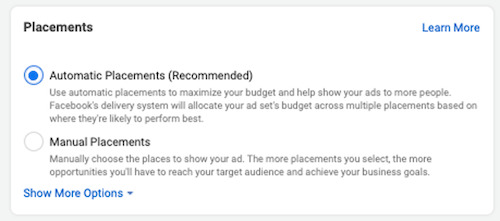
Don’t Fall Victim to Facebook Ad Fatigue
Facebook Ad Fatigue occurs when your ad’s target audience is shown your ad too many times and your Click-Through-Rate drops as your frequency rate (how many times it’s seen) increase.
Why this happens: Users are shown your advertisement frequently - every time they sign into Facebook (on average 13.8 times/day). Your ad is competing against photos and statuses on Facebook users’ News Feeds. People become inured to your advertisement and your Click-Through-Rate (CTR) drops.
Rotating the variables within your ads (Ad Rotation) stops Facebook users from becoming Ad Fatigued. Ideally, as soon as your ad starts losing efficacy it gets rotated out and replaced with a different version.
Learn more about Facebook Ad Fatigue and how to combat it.

Does Facebook Optimize My Ad Spend for Me?
Yes - Facebook does optimize your target audience for you, based on who is clicking or converting on your ad. But, to be honest, the optimization they do is fairly minimal. Using the above techniques optimize your ads far better than Facebook will.
What is CTR and How Does it Affect Facebook Advertising Costs?
CTR (Click-Through-Rate): This is the percentage of people who click on your ad divided by the total number of people who saw your ad. For example, if 100 people see your ad and only 1 of them clicks on it, your CTR is 1%.
Unlike Google Ads, Facebook does not have any documented Quality Score. For Google Ads, your Ad’s Quality Score is affected by your click-through rate and long-click-rate (number of people who stay on a website after clicking on an ad for it). Unfortunately, this is not the case yet for Facebook Ads.
P.S. Need help creating engaging social media campaigns? Wishpond's Facebook Contest Apps make it easy to create sweepstakes, photo contests, Instagram hashtag contests & more. If you're looking for inspiration, check out our post Facebook Contest Ideas.

More Free Resources on Facebook Advertising:
Free Ebook: The Complete Guide to Facebook Ads
How to A/B Split Test your Facebook Ads to Maximize ROI
The Science of Optimizing your Facebook Advertising Campaigns
7 Facebook Ad Call-To-Action (CTA) Tips, Techniques & Best Practices
How to Run a Facebook Ad that Gets Clicks
Facebook Contest Ideas

Conclusion
Facebook advertising is an excellent way to reach a far larger audience on social media, target very specific users, improve your lead generation campaigns, and grow your social media marketing. Of course, effective Facebook Ad campaigns require advertisers to spend their campaign budgets carefully.
Understanding cost-per-click (CPC) on Facebook is only the first step. Beyond CPC on Facebook, there are many other important metrics to consider (like your ROAS) to help you understand just how worthwhile your Facebook Ad campaigns are.
Keep this guide in mind the next time you run a Facebook campaign, and you should be able to do more for your campaigns with your marketing budget.
from RSSMix.com Mix ID 8230801 https://ift.tt/2YufK6u
via IFTTT
0 notes